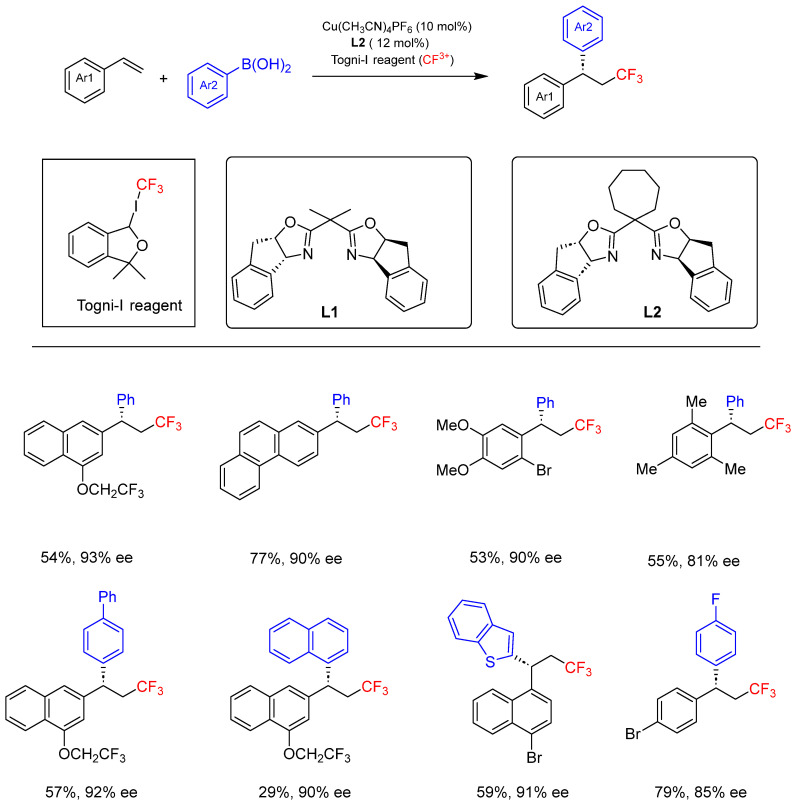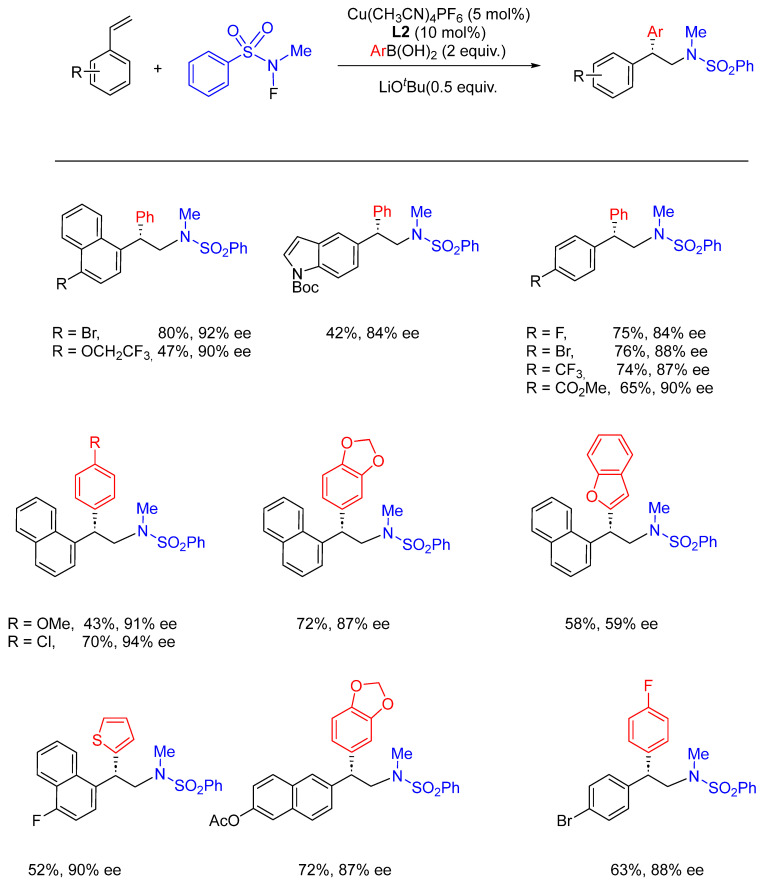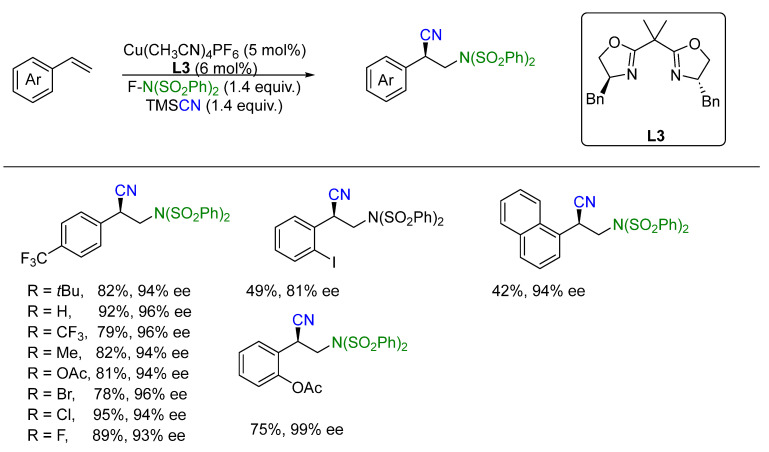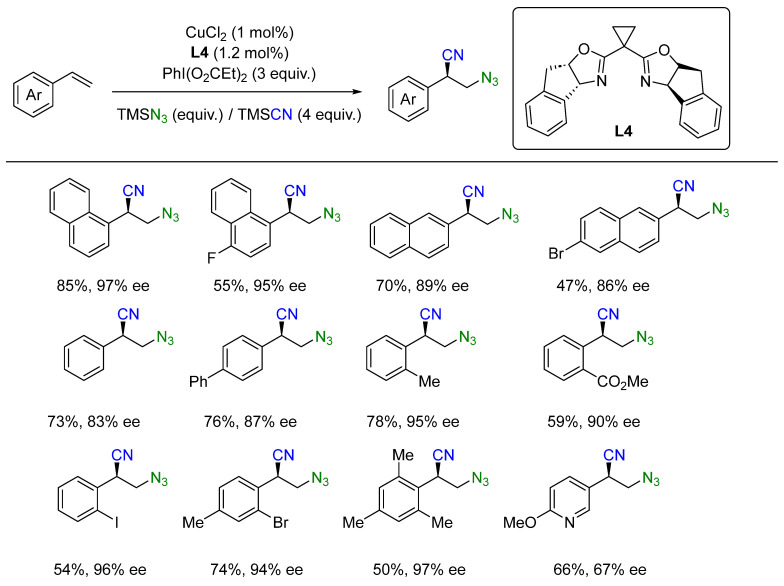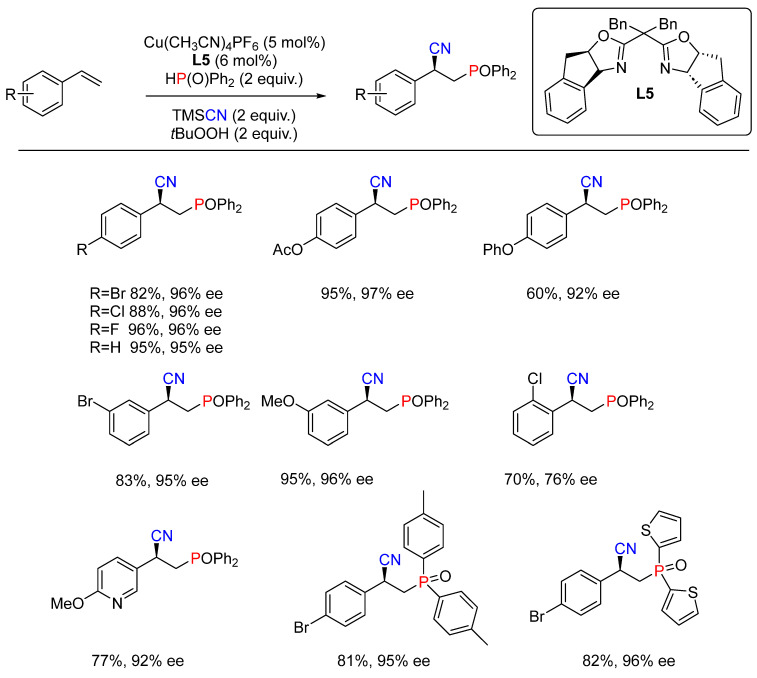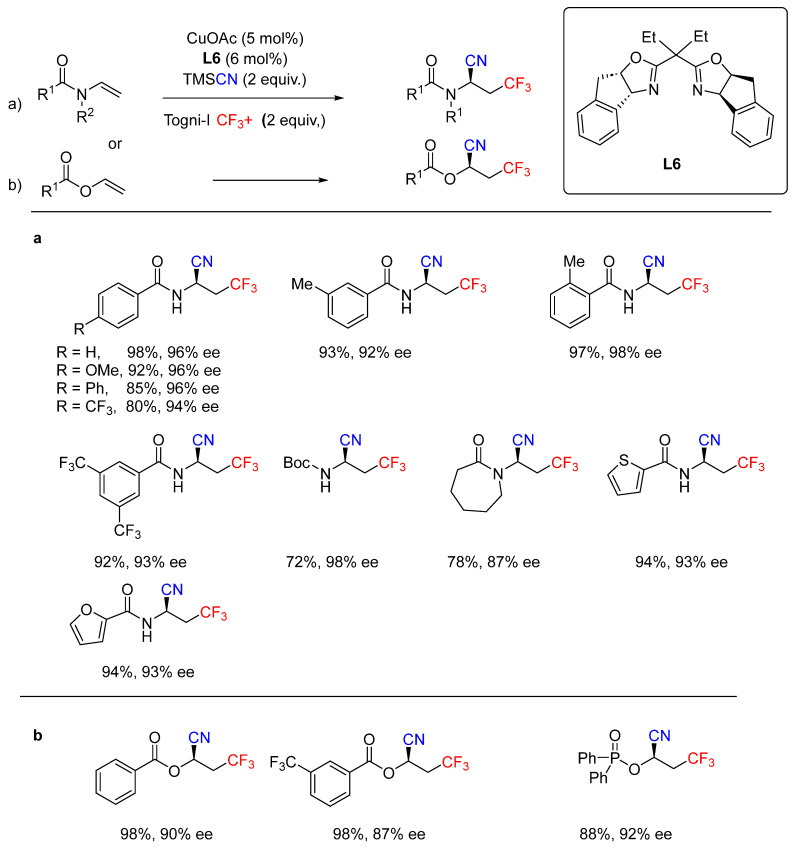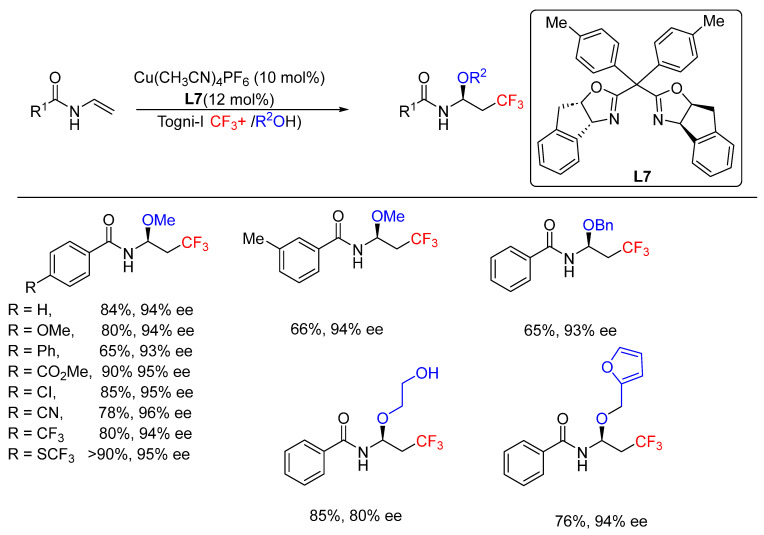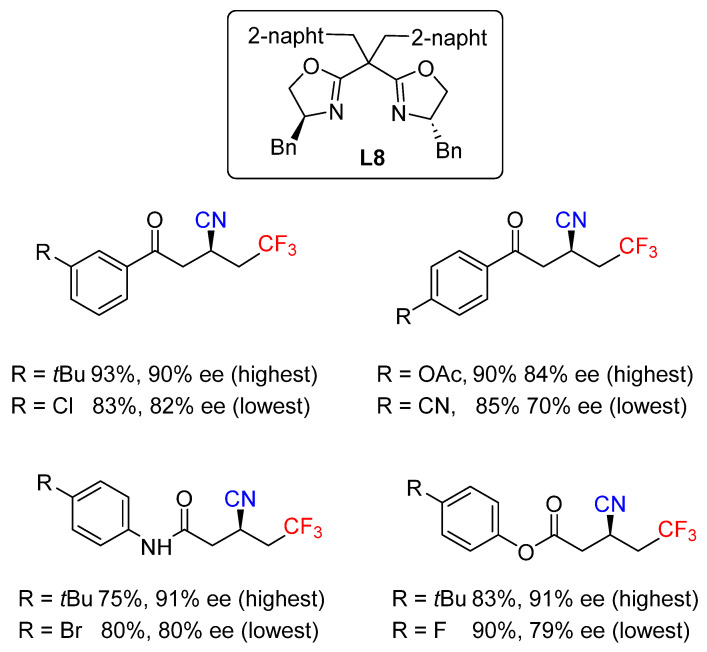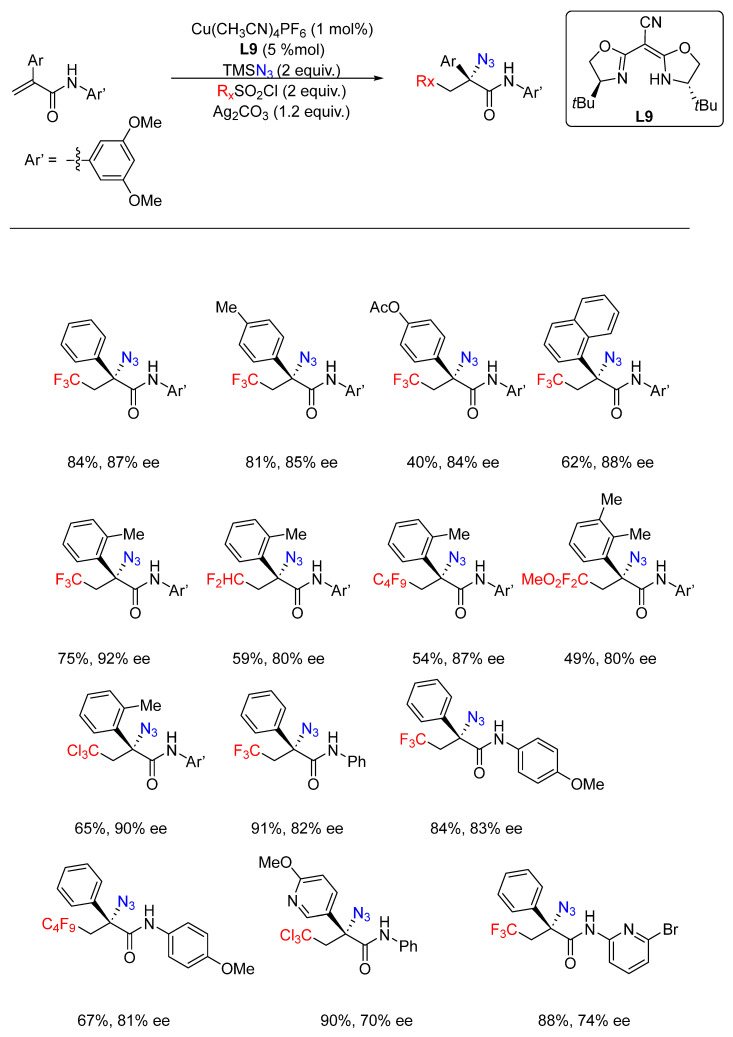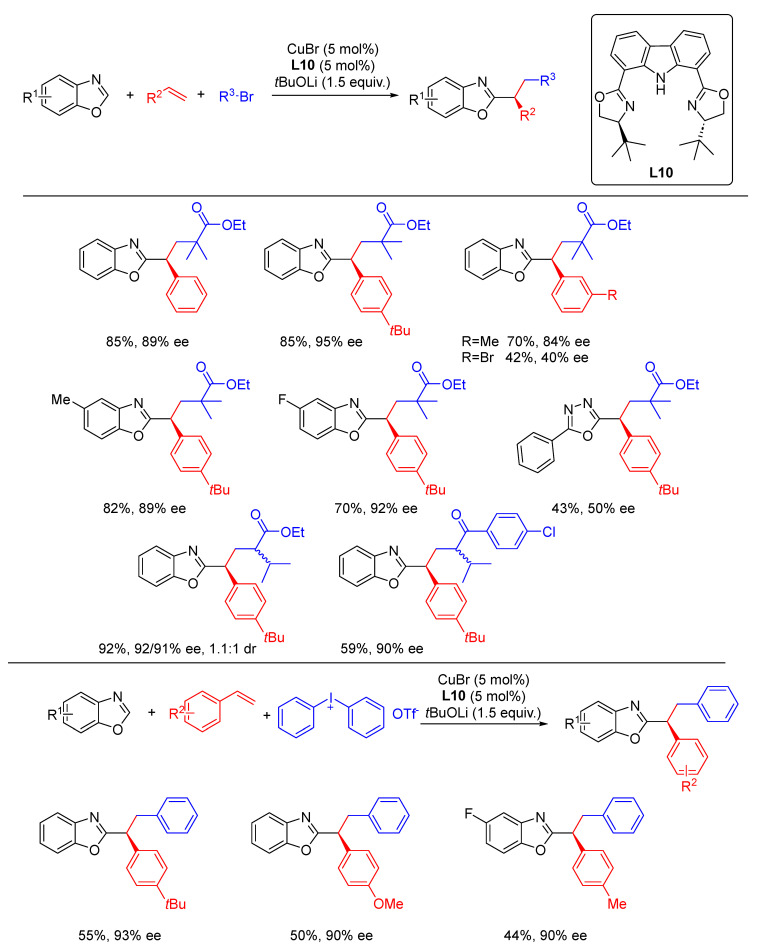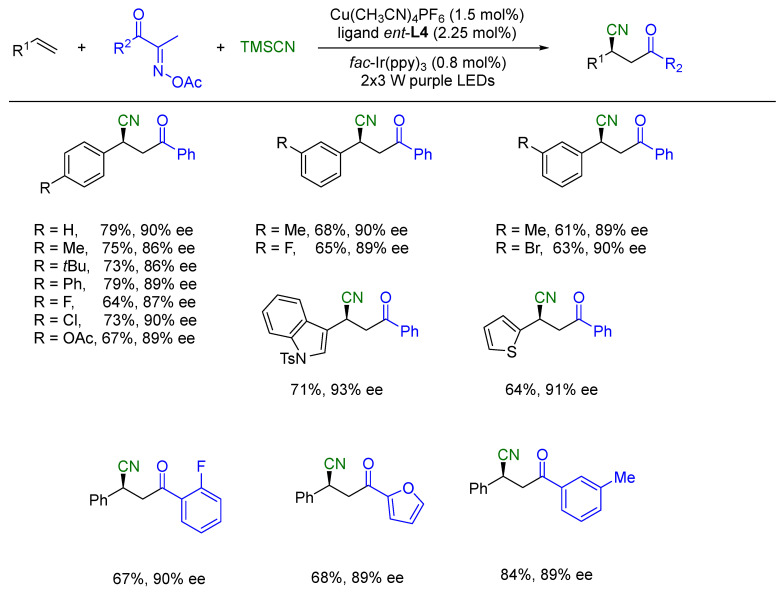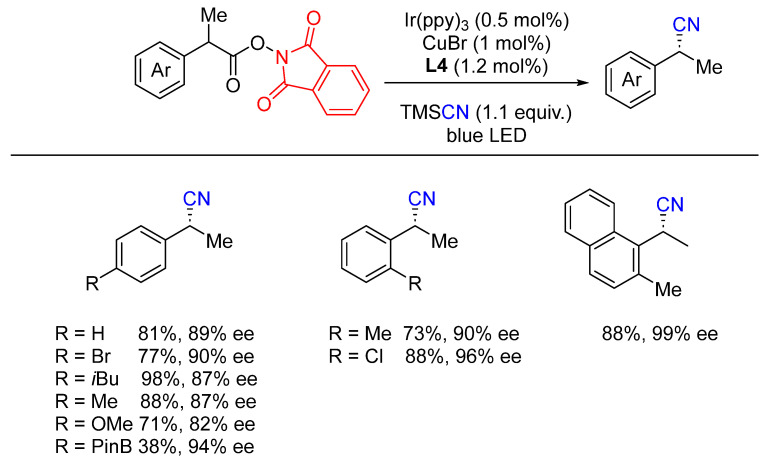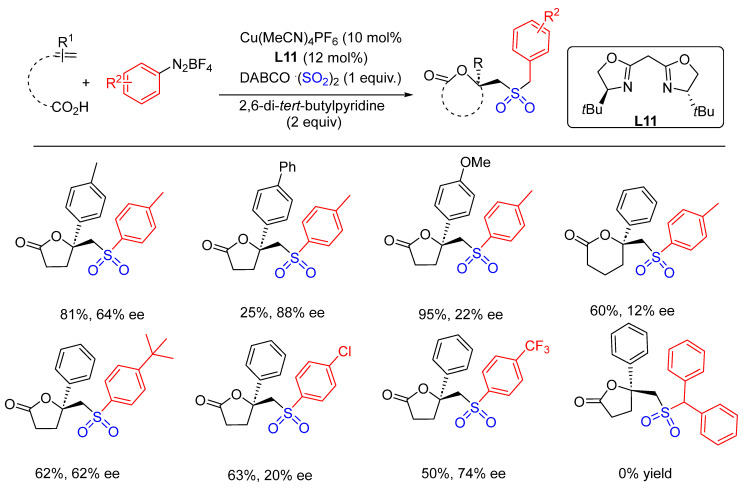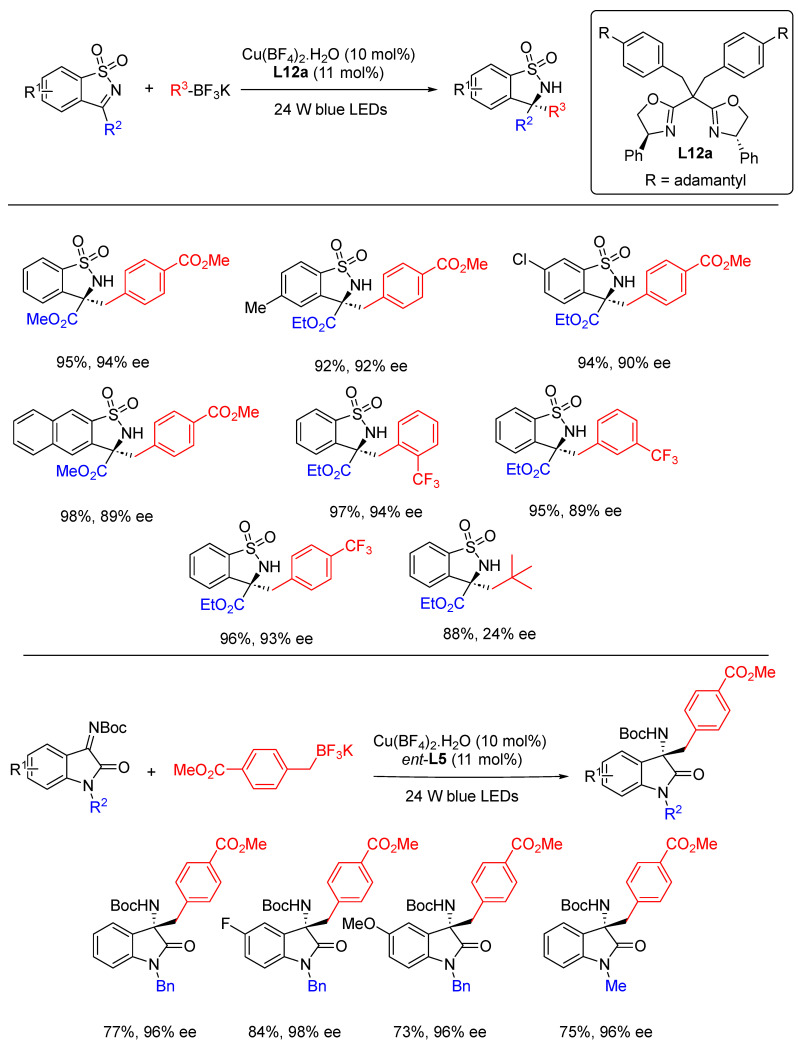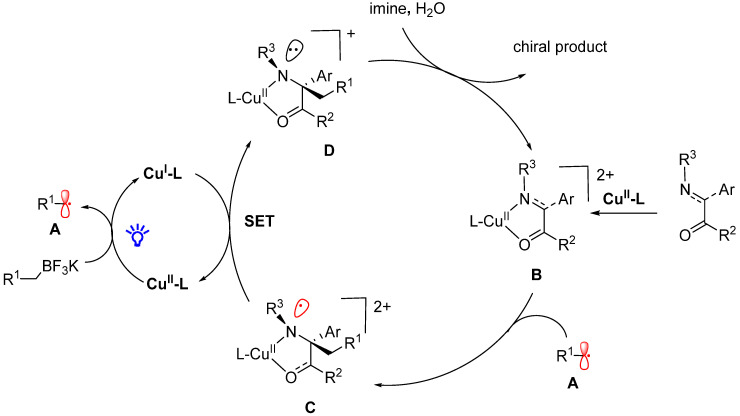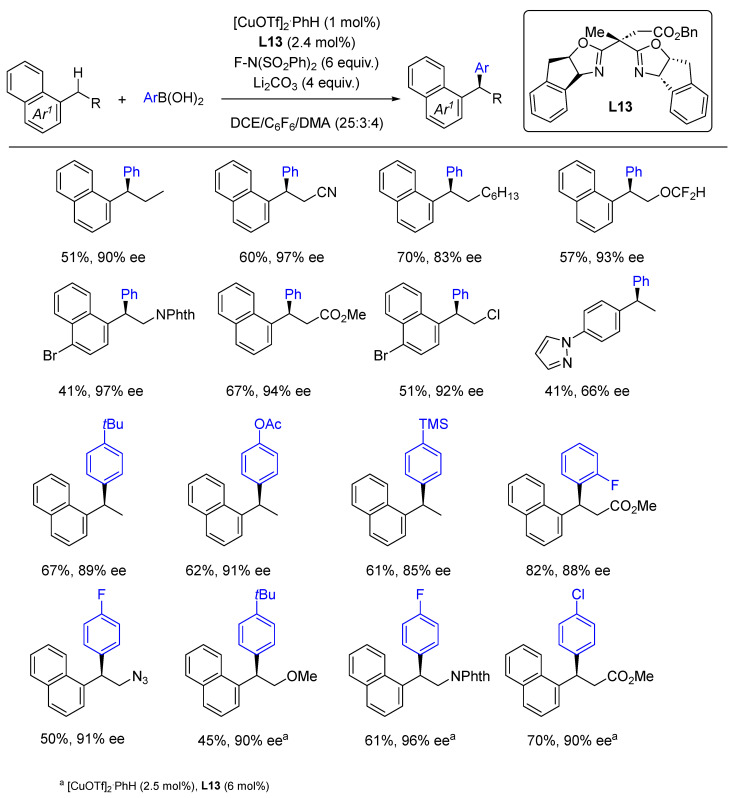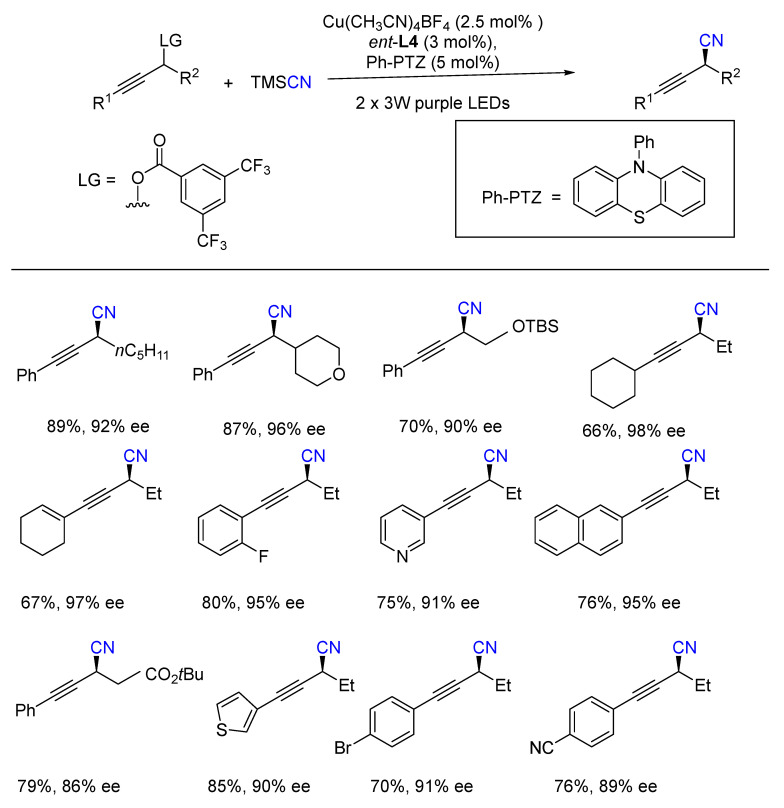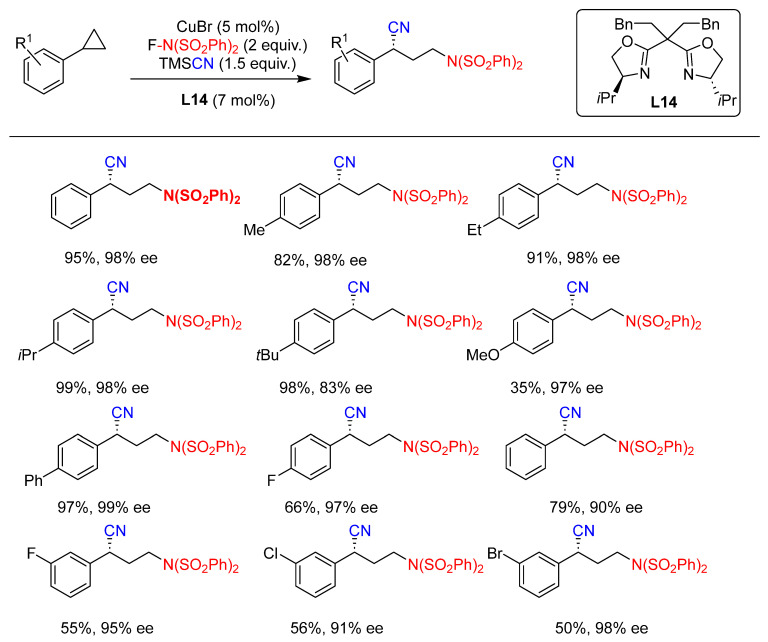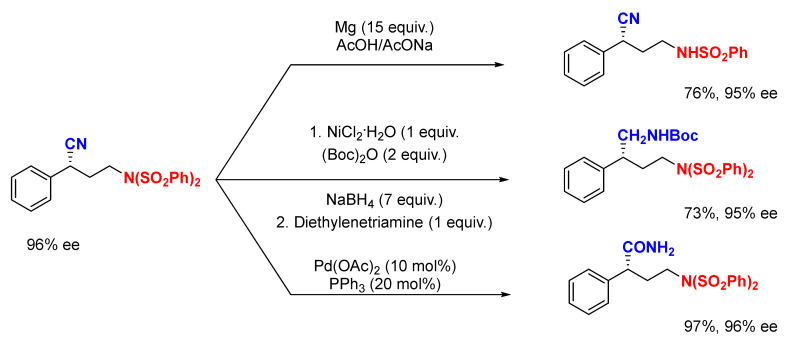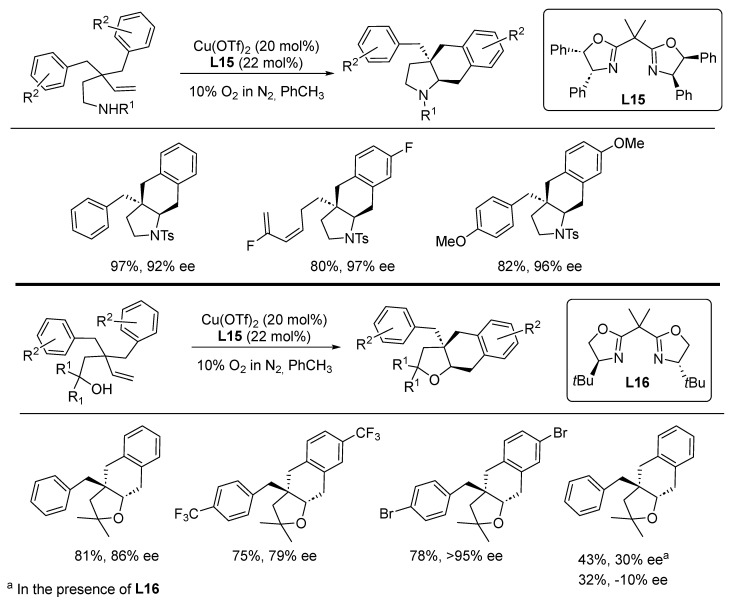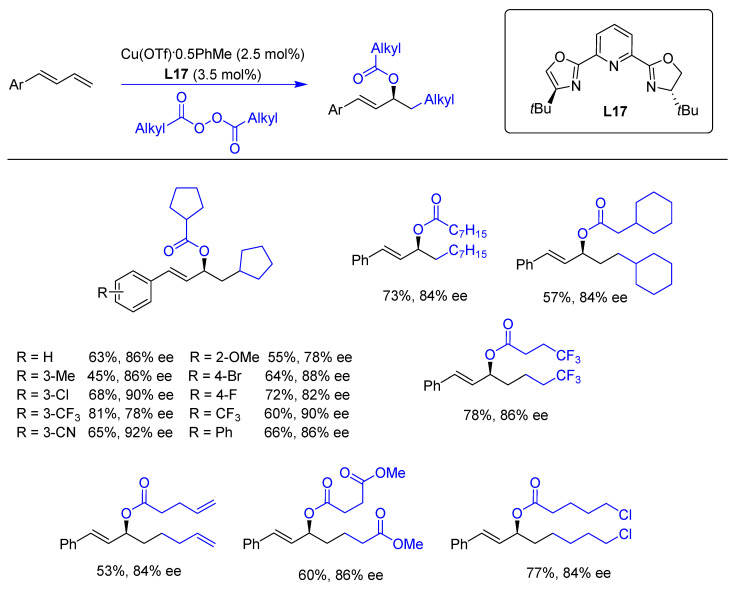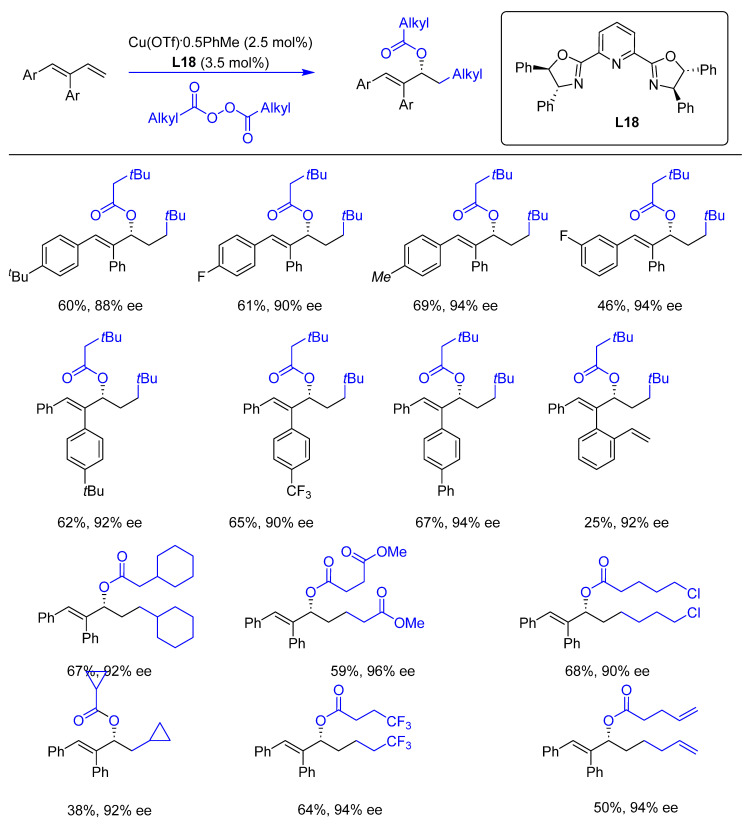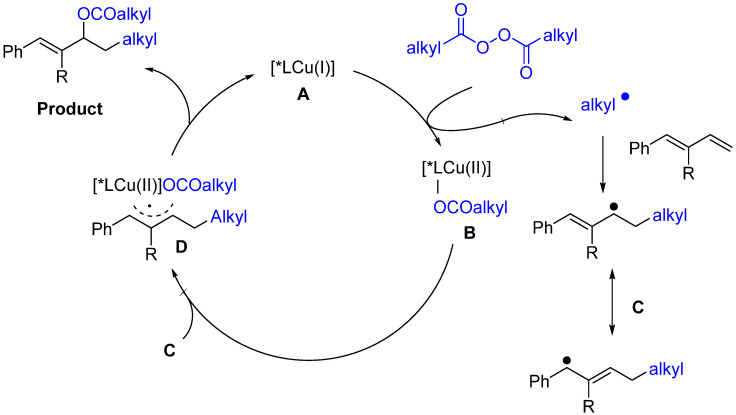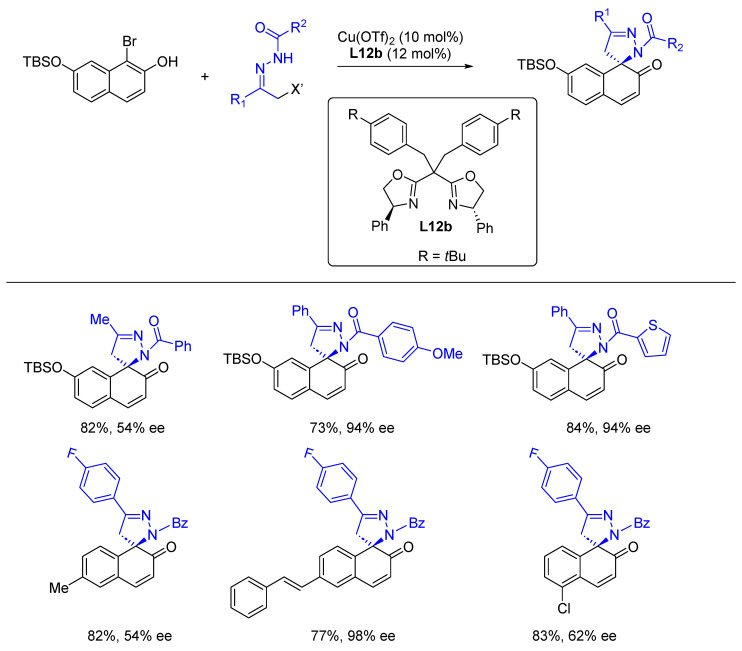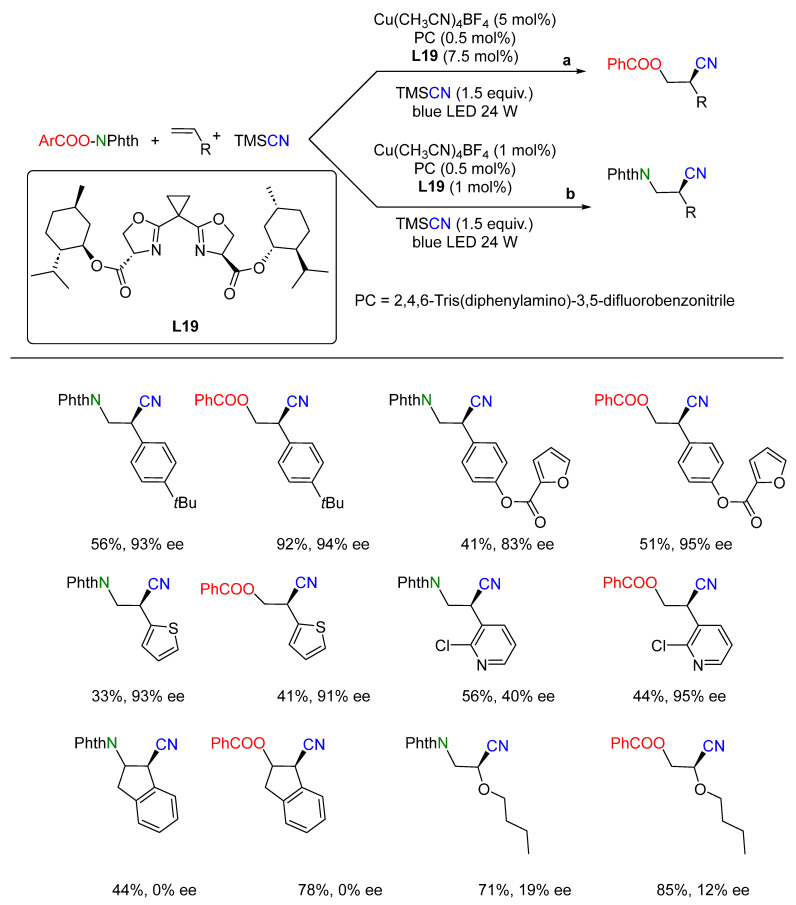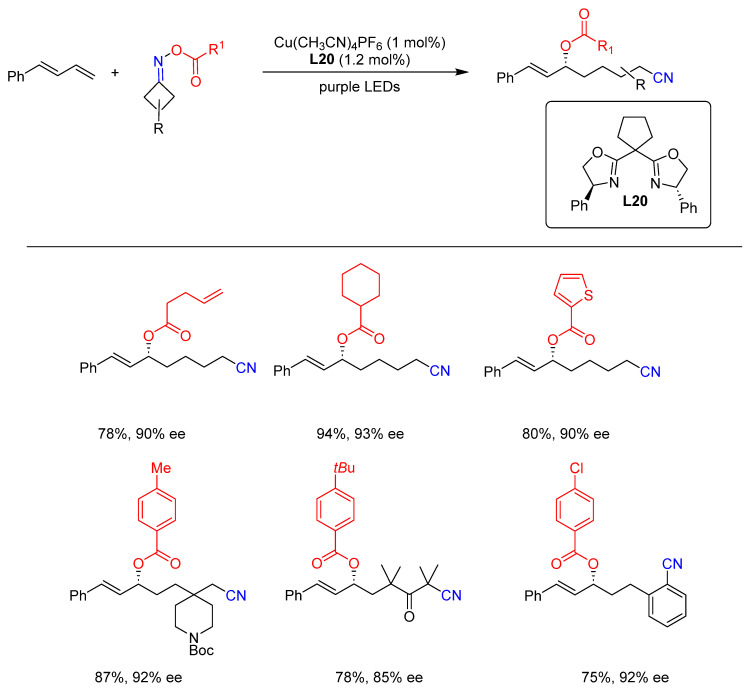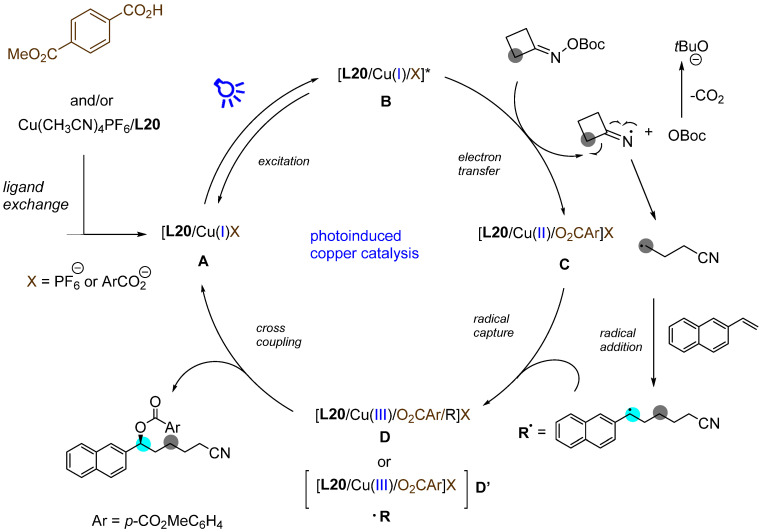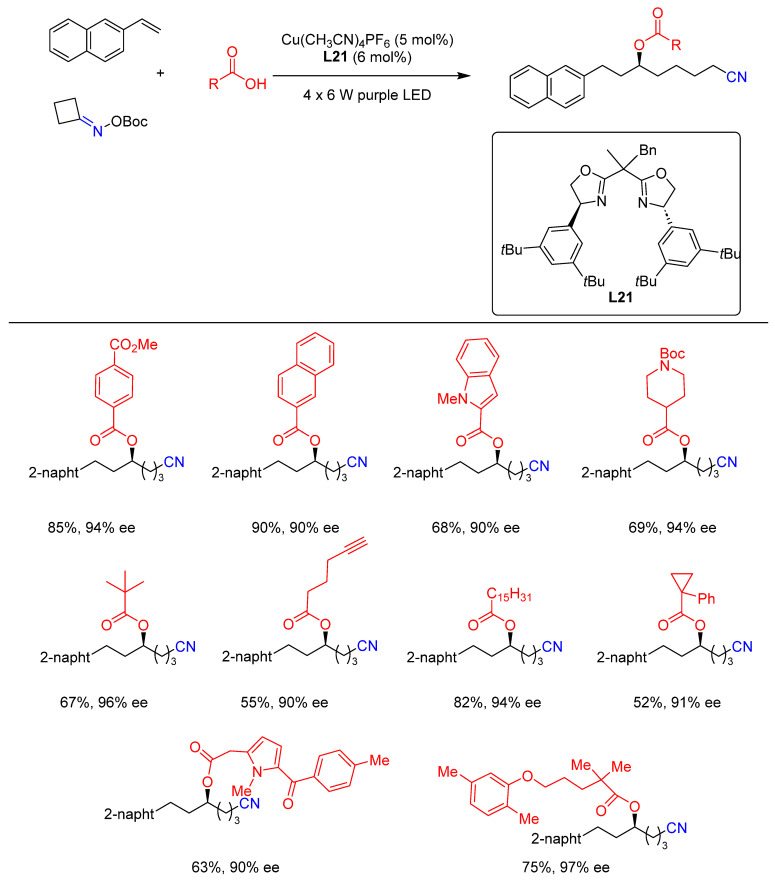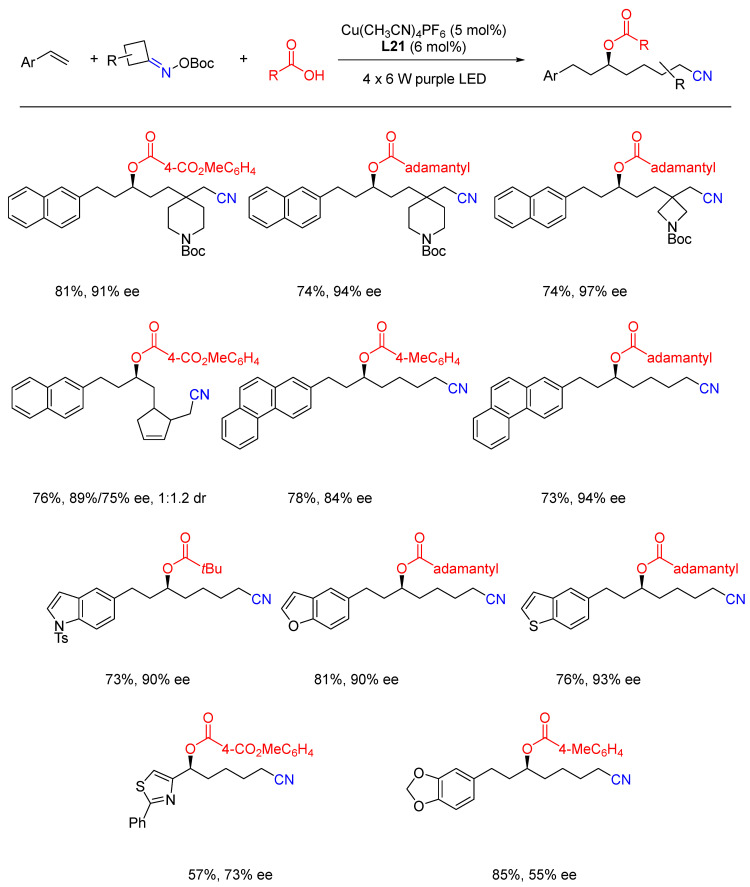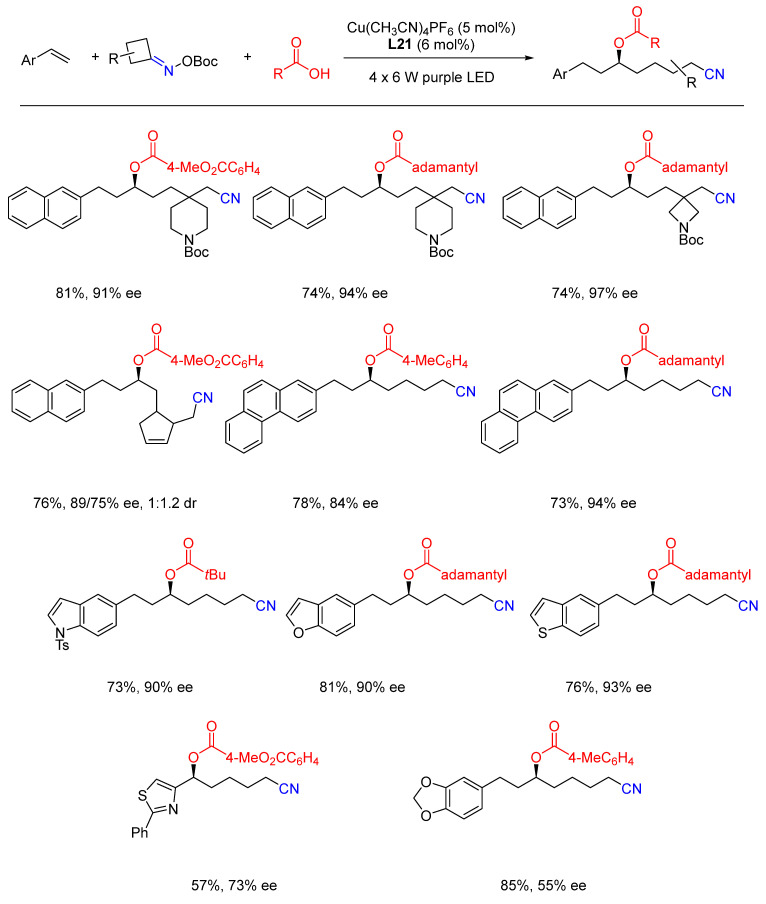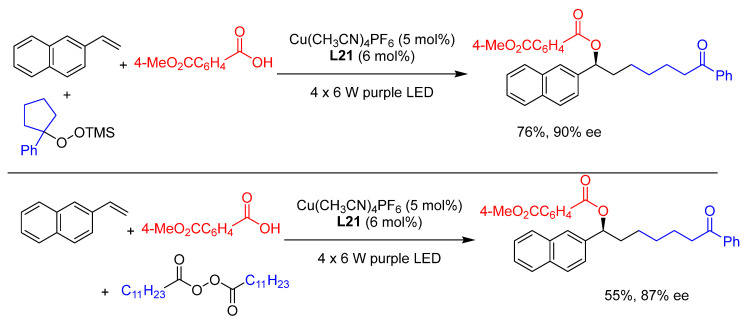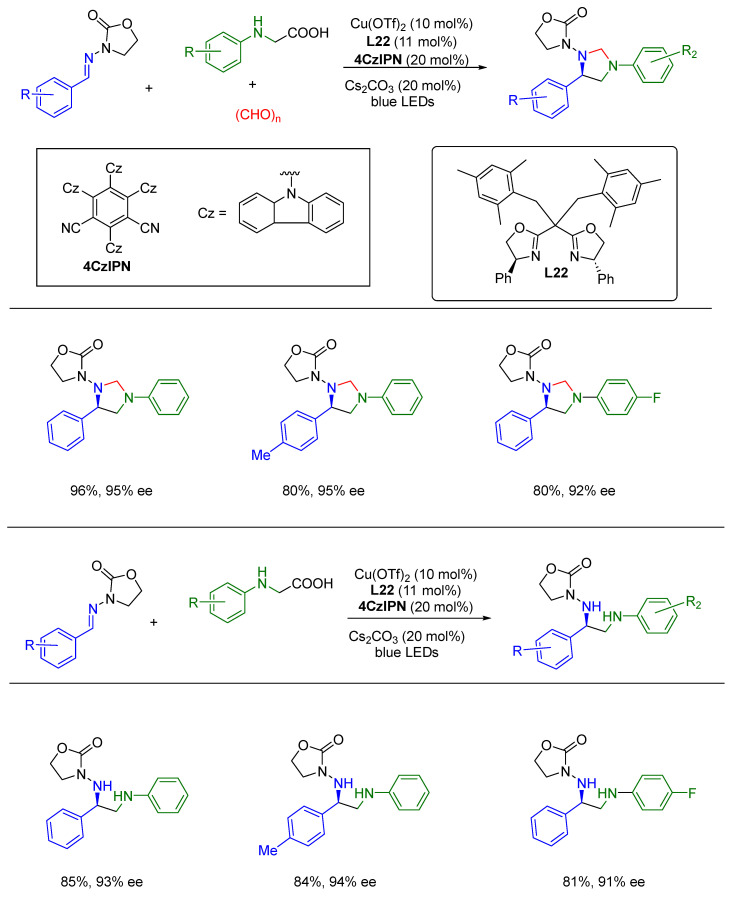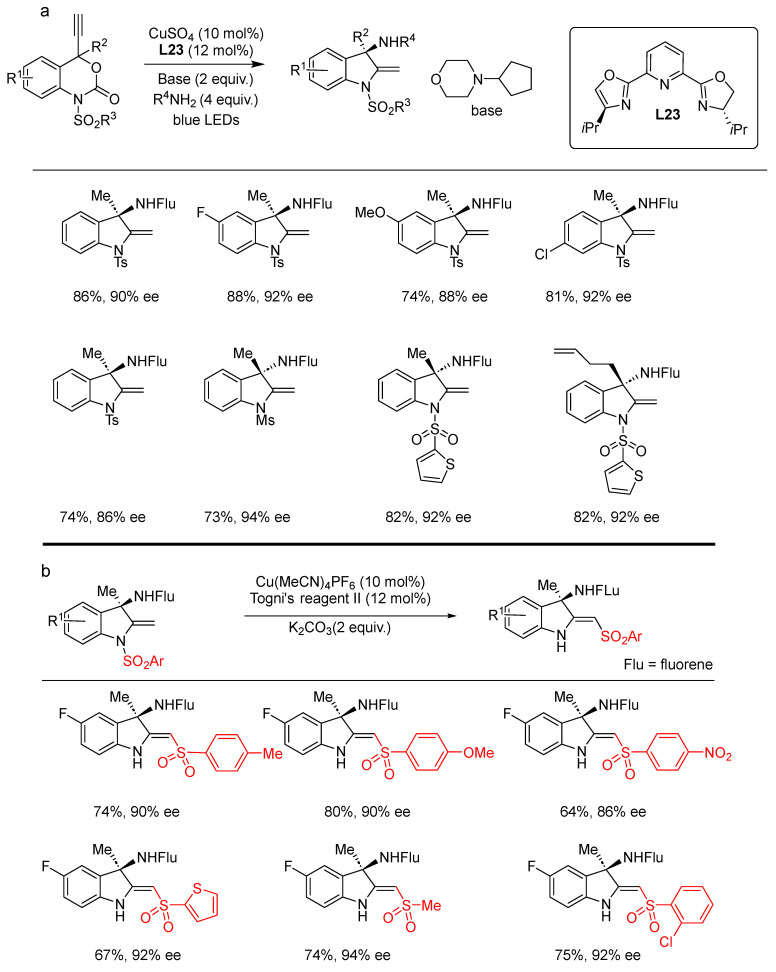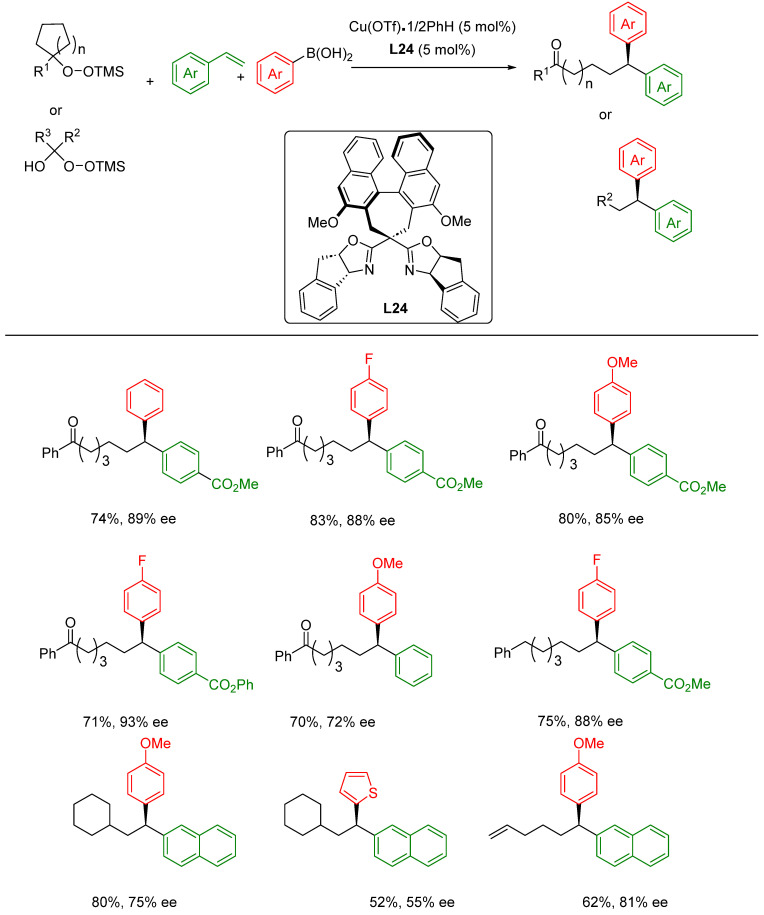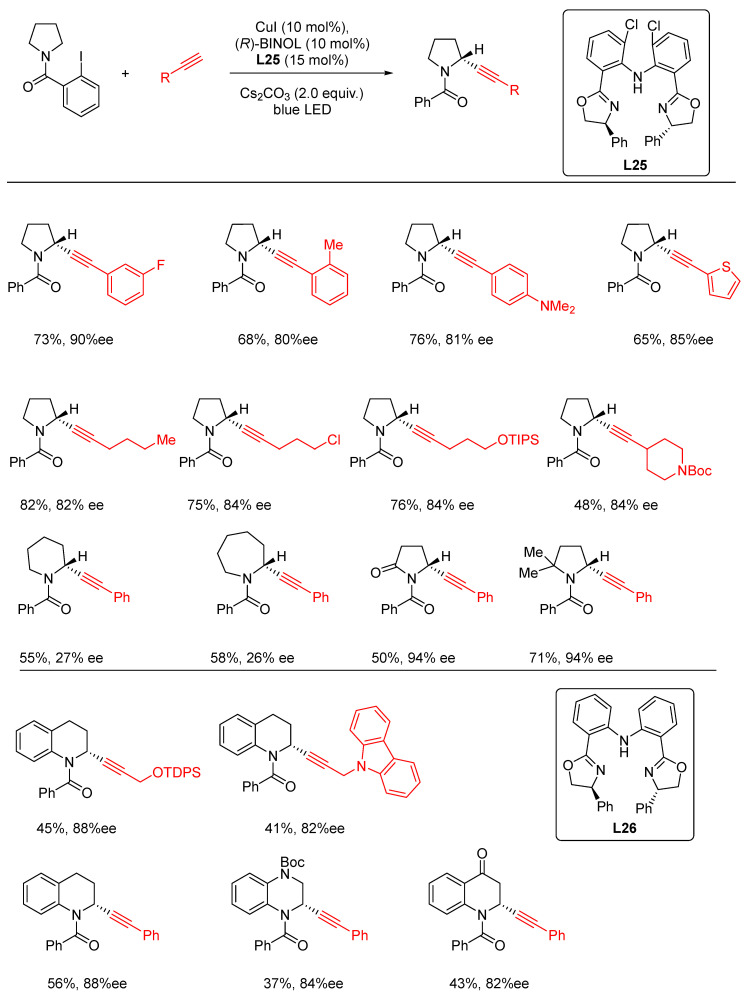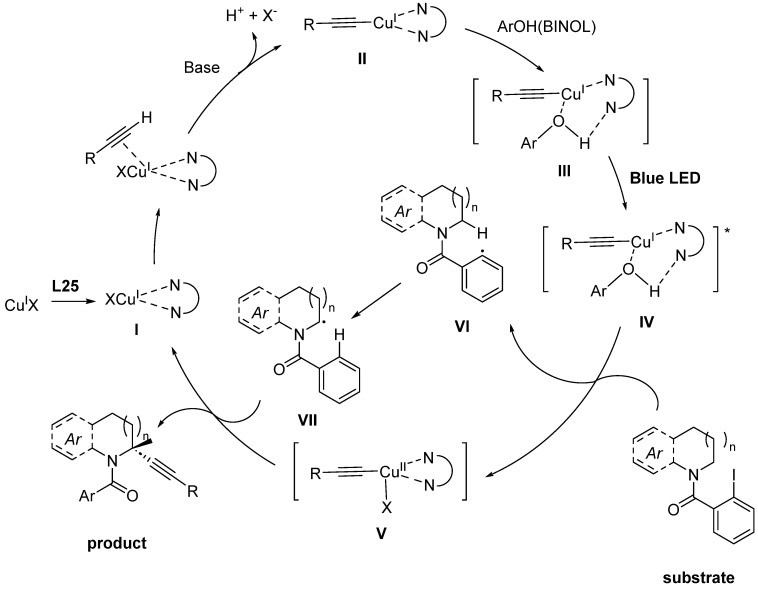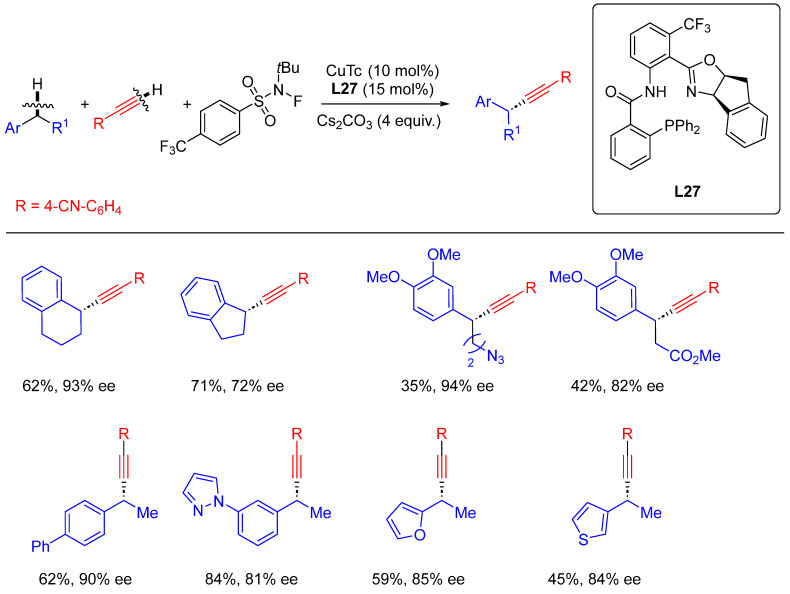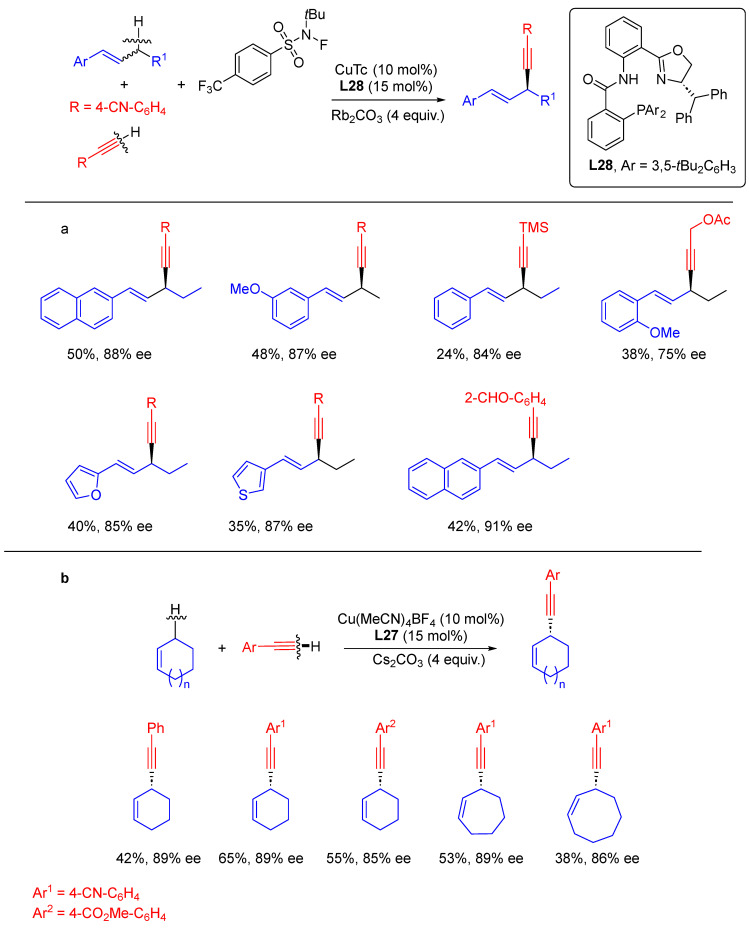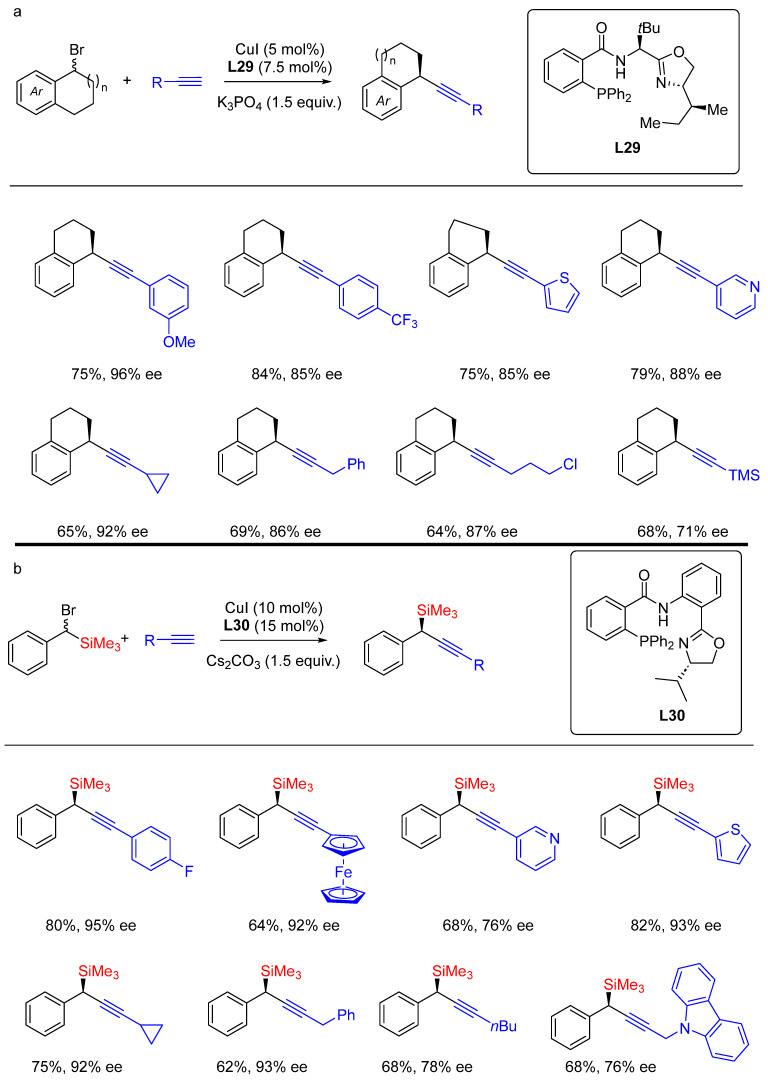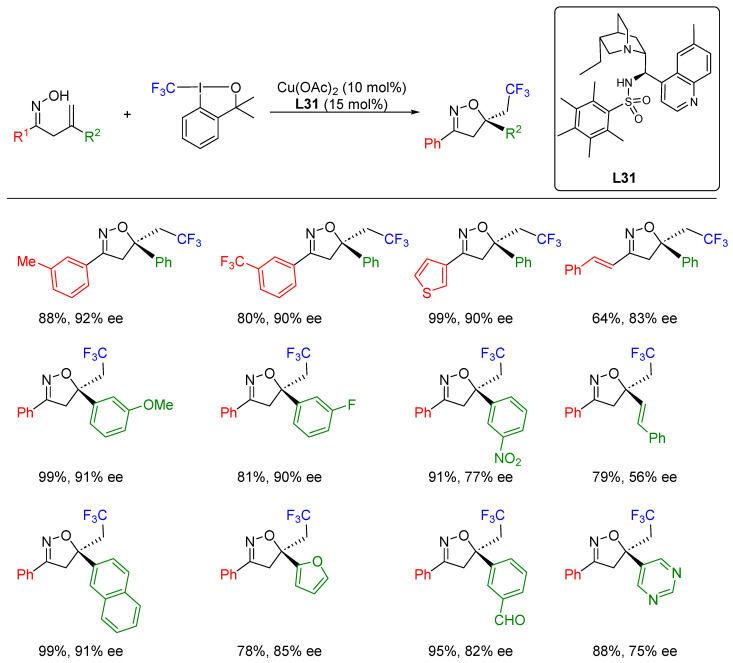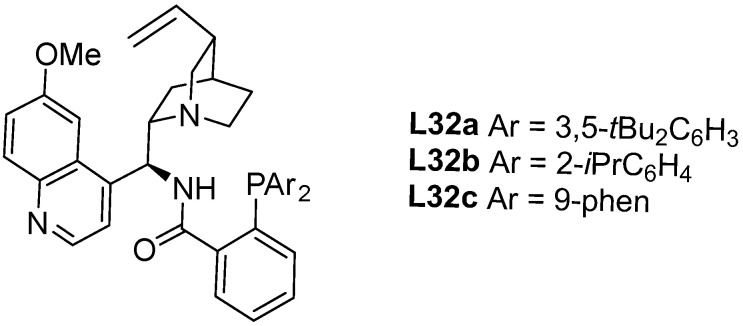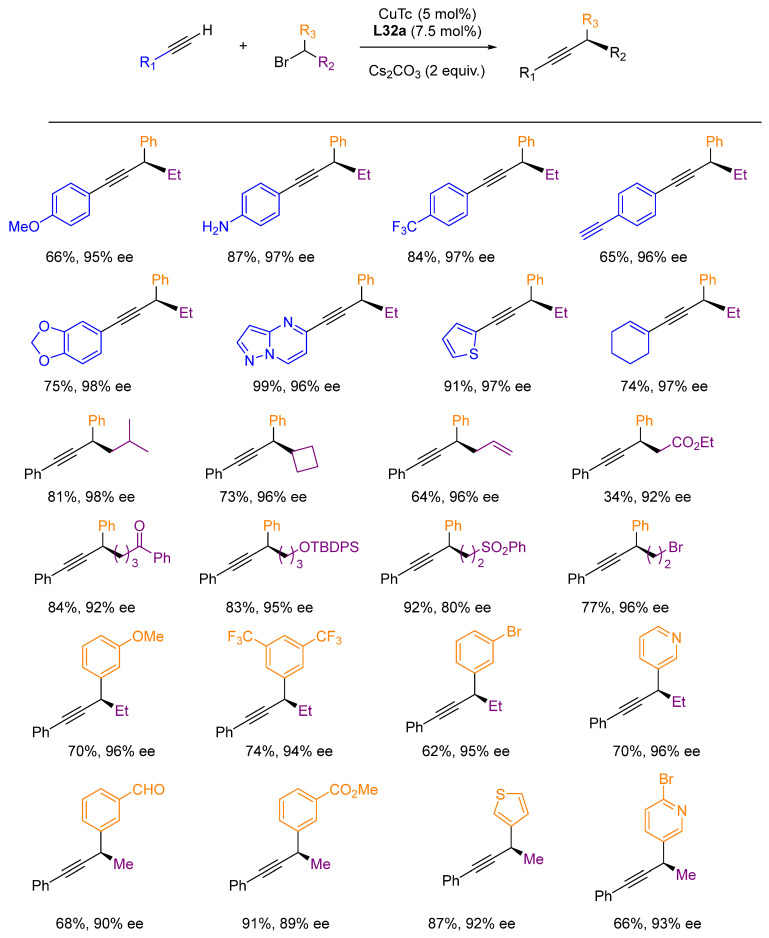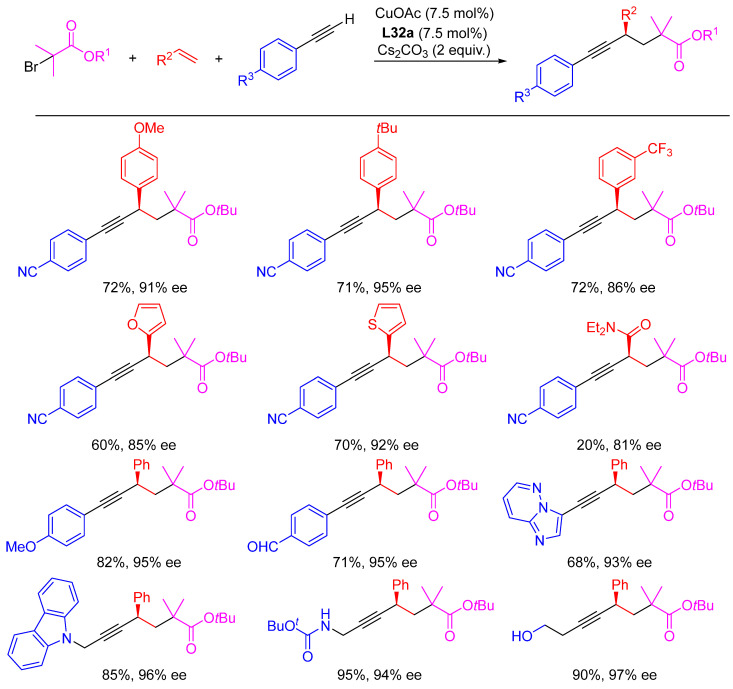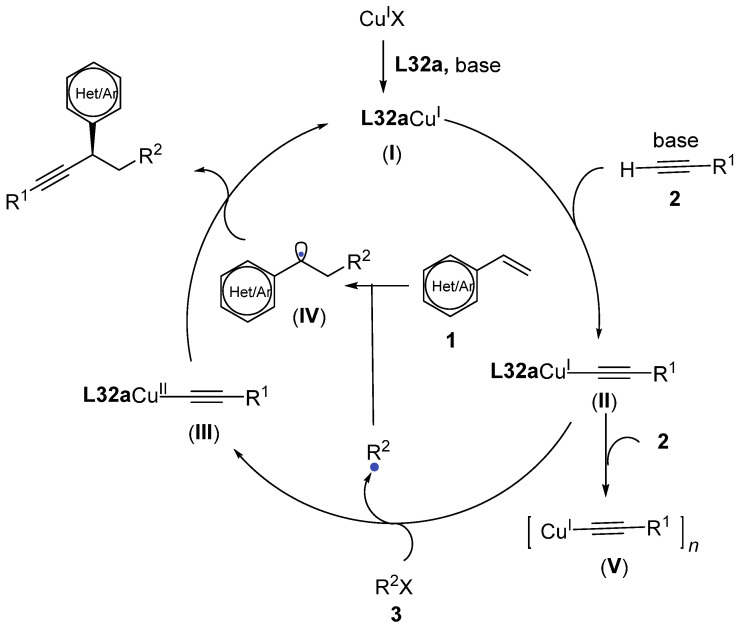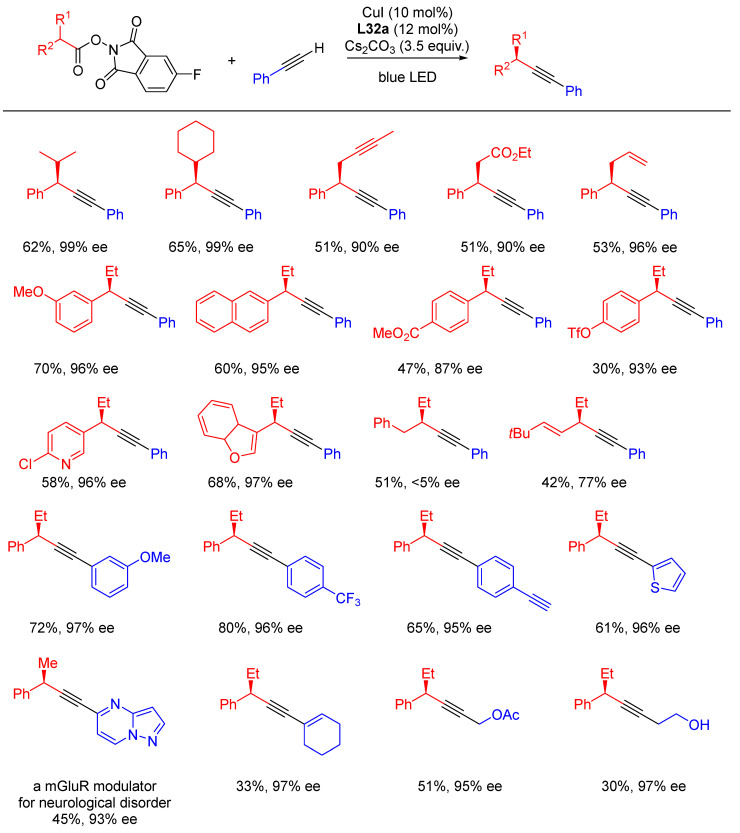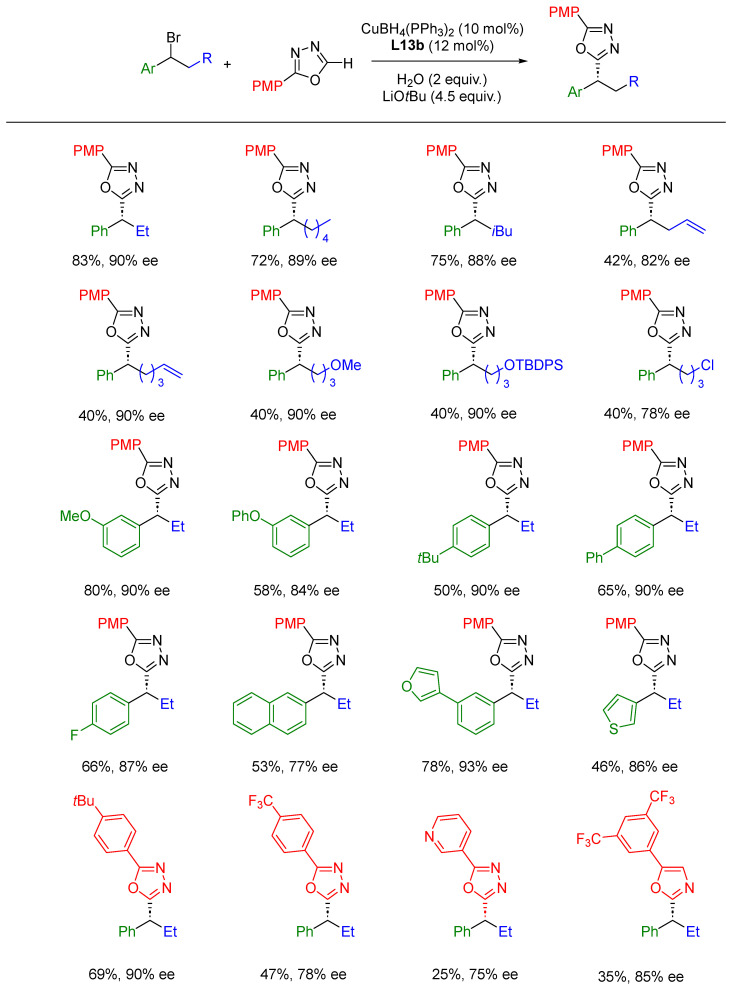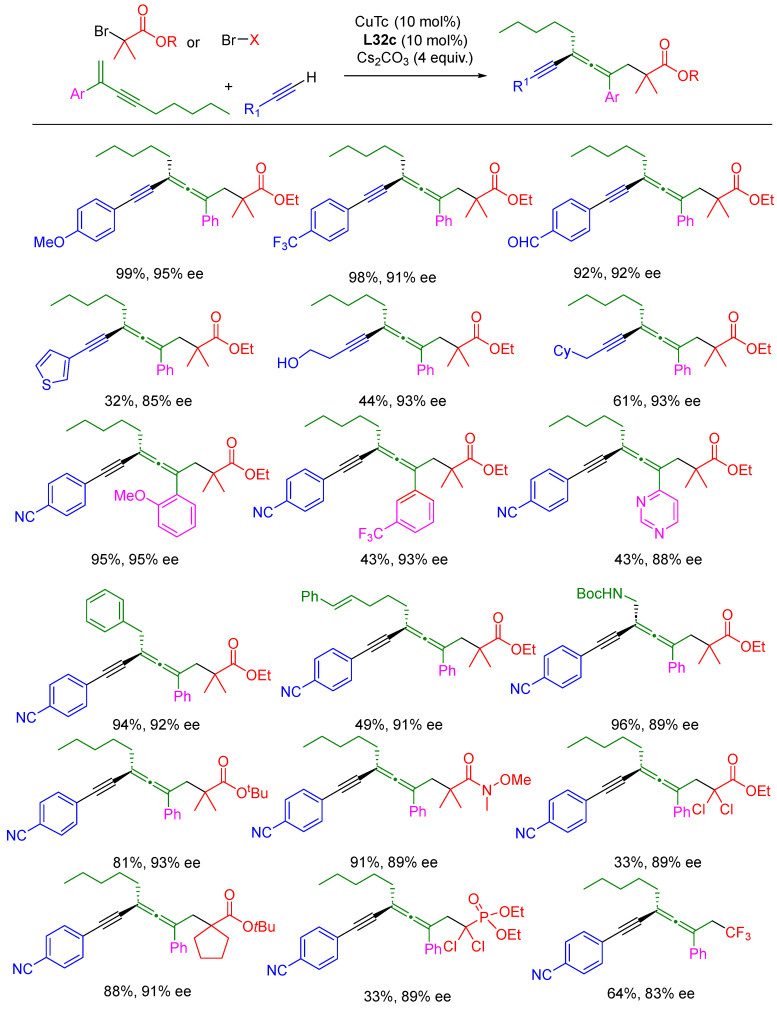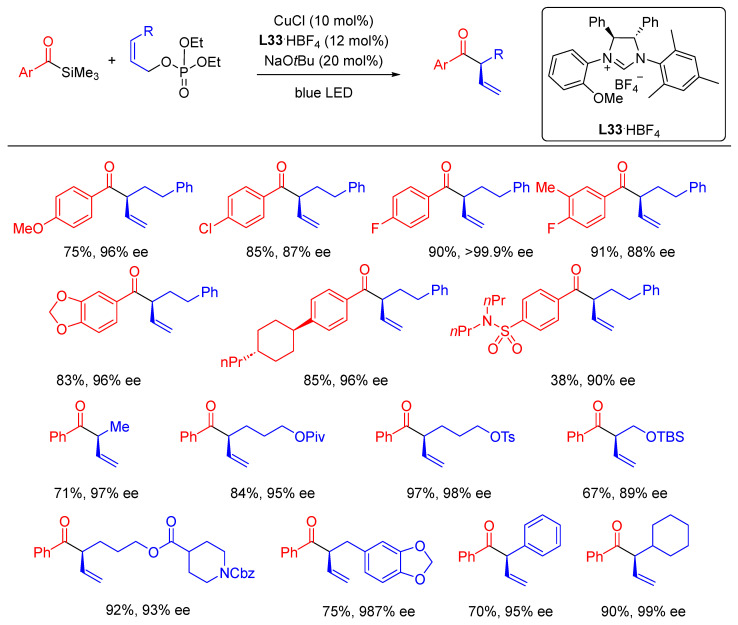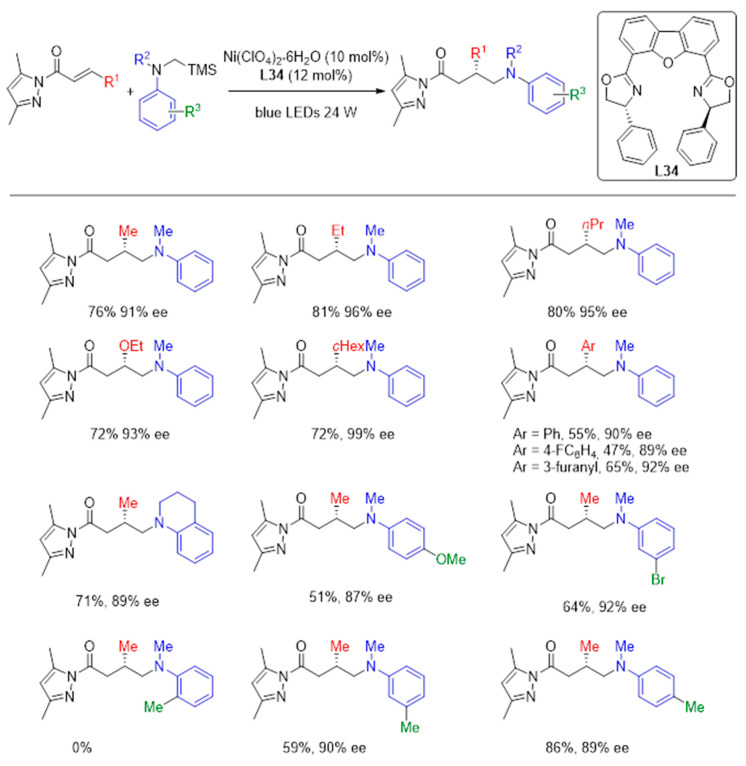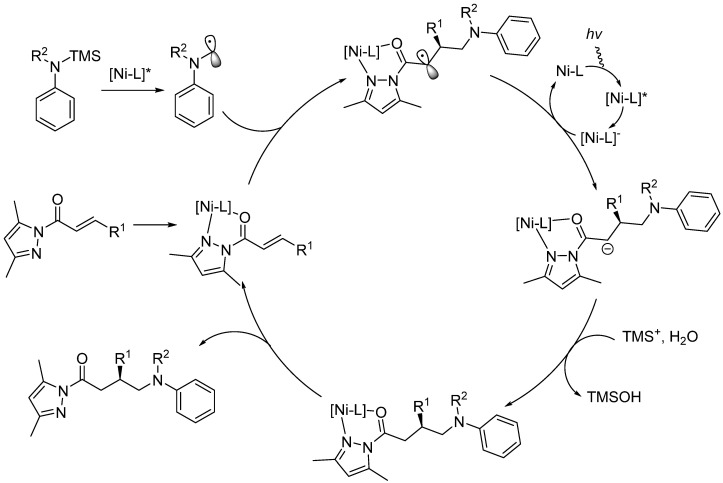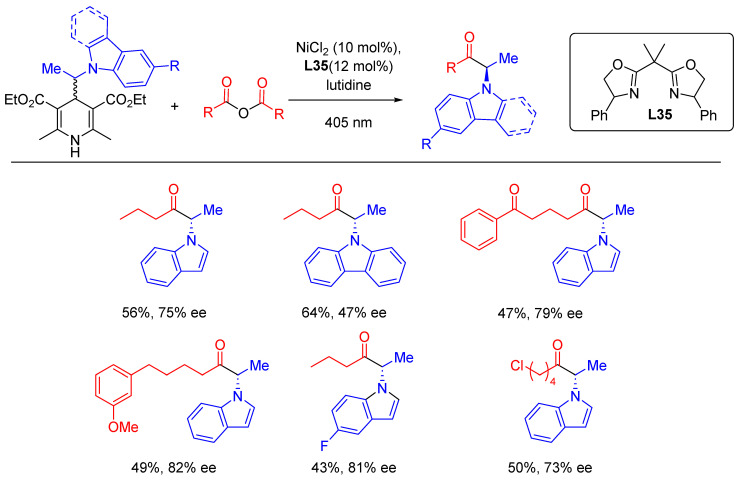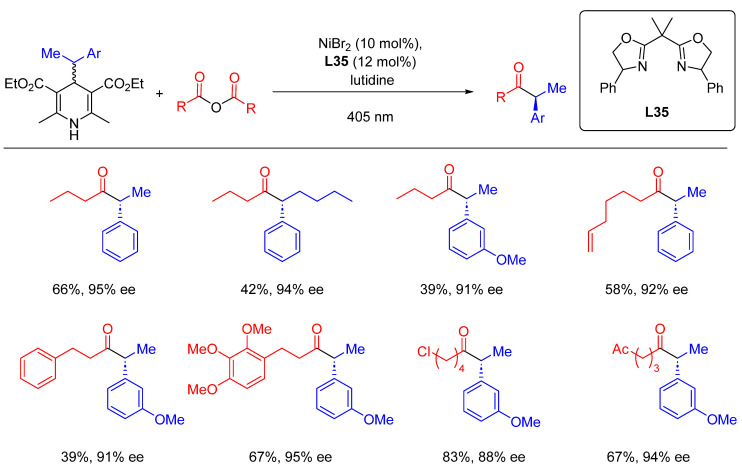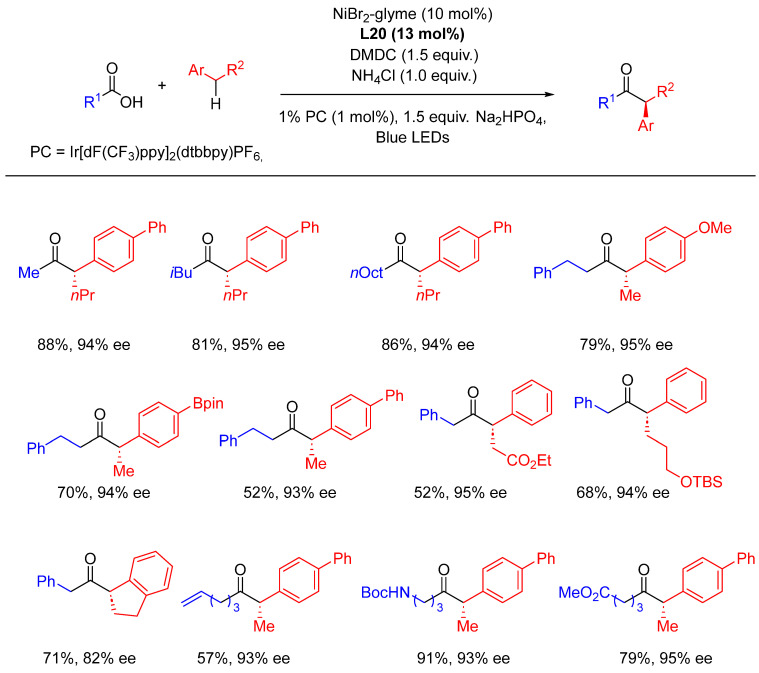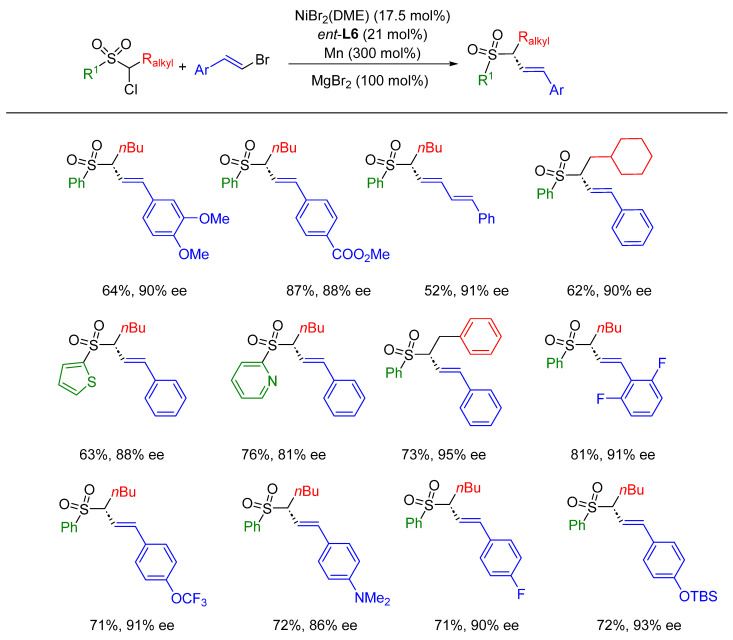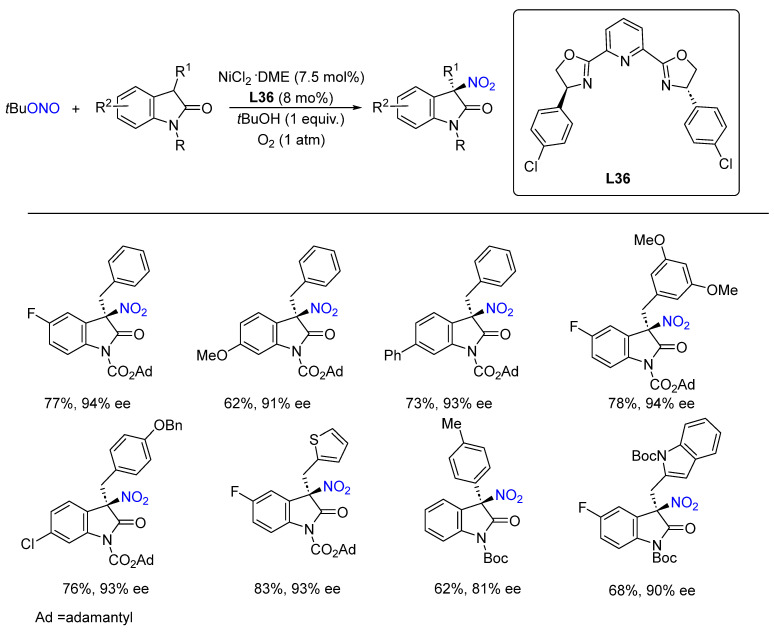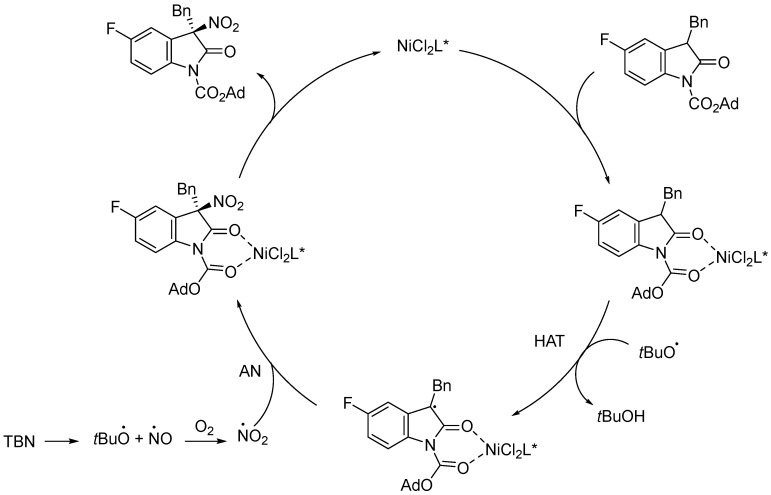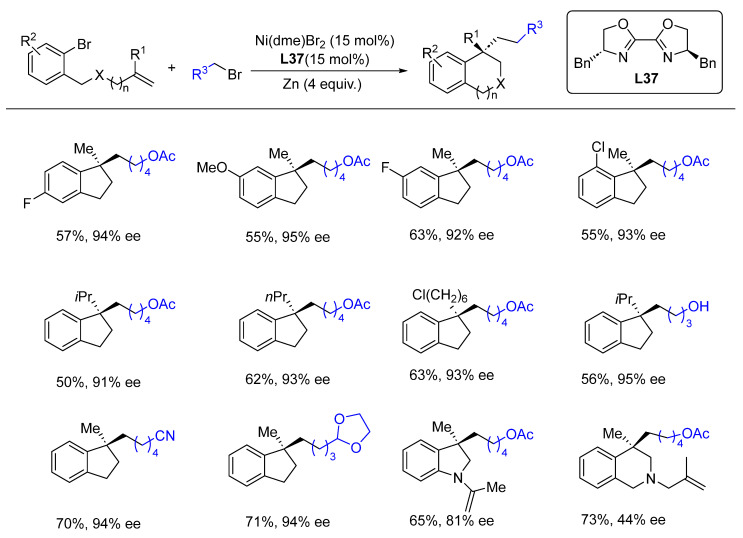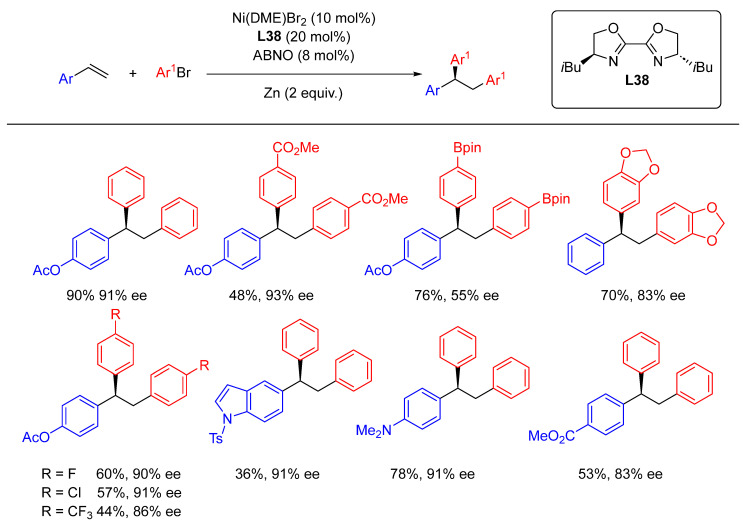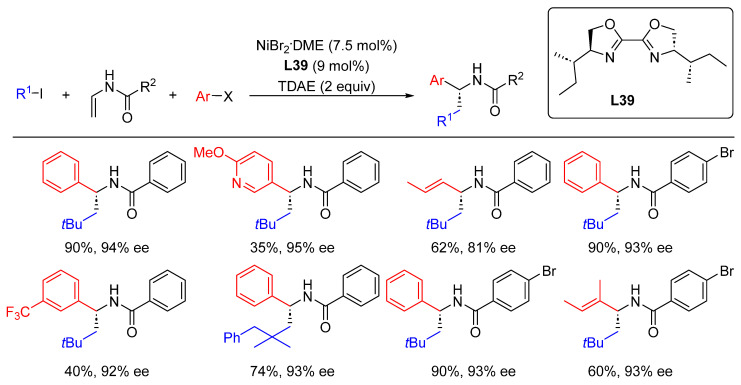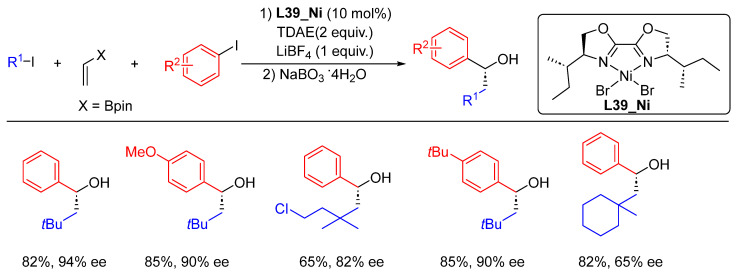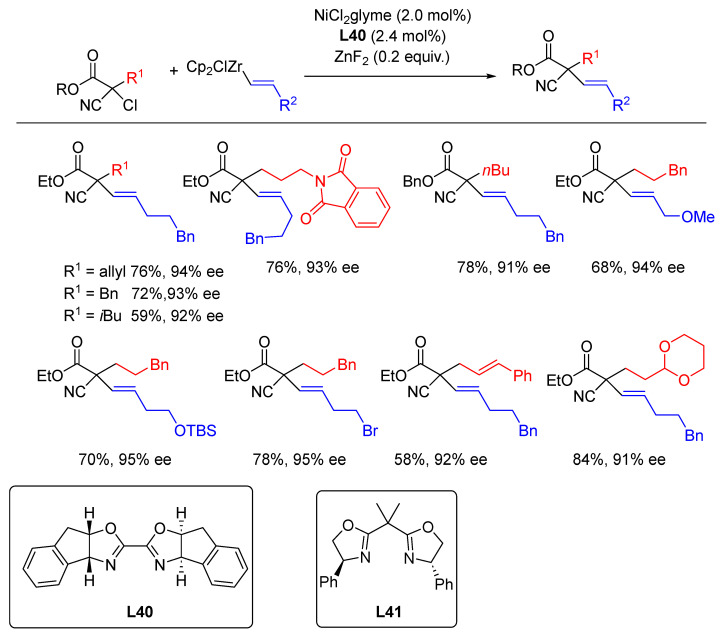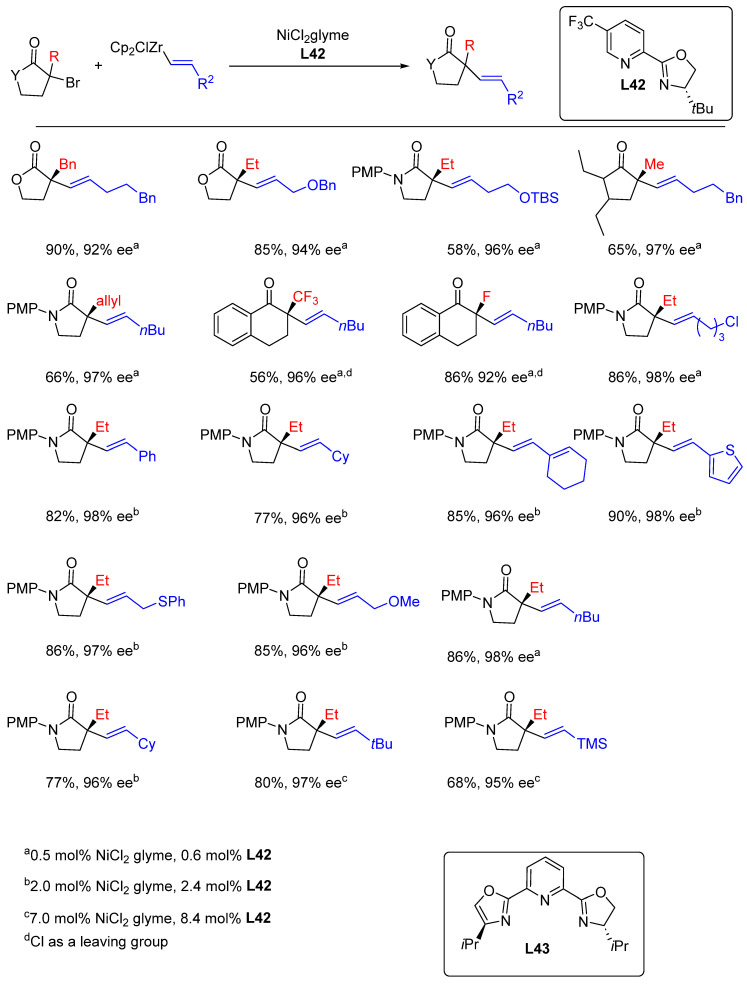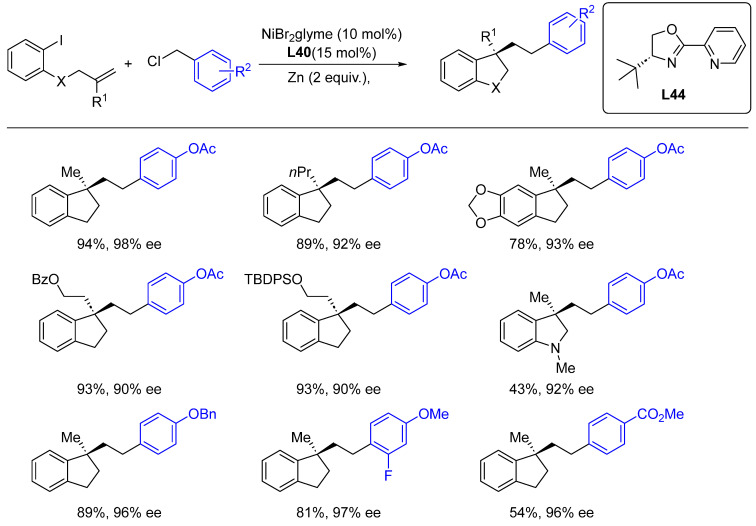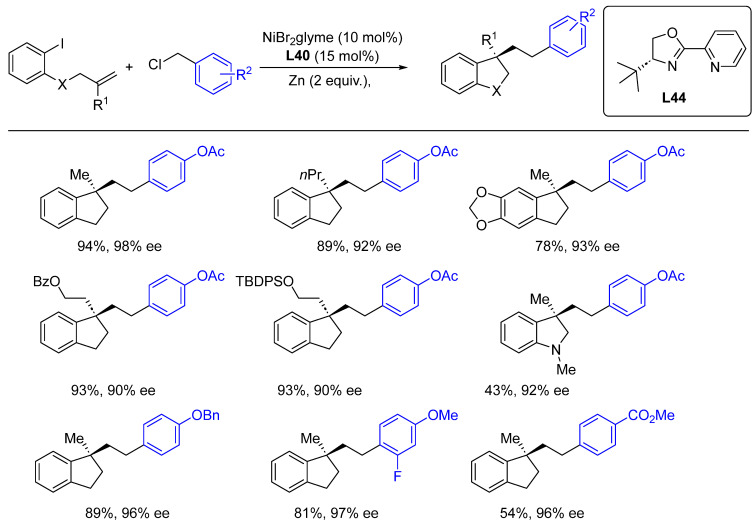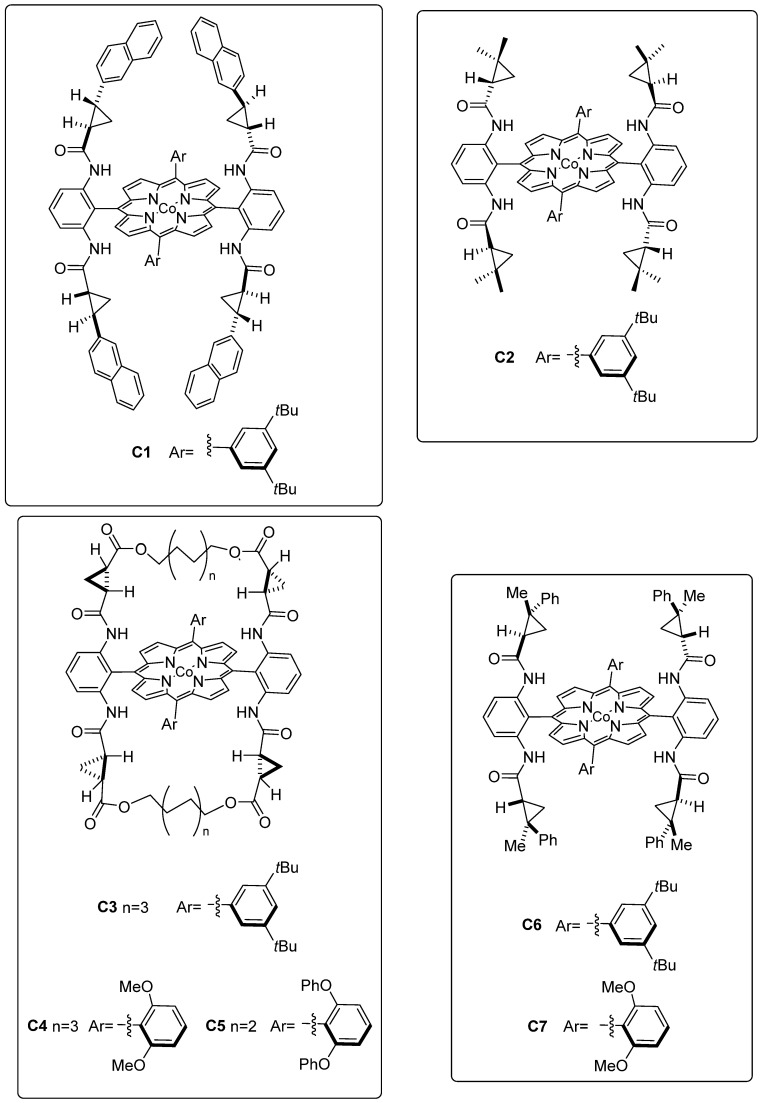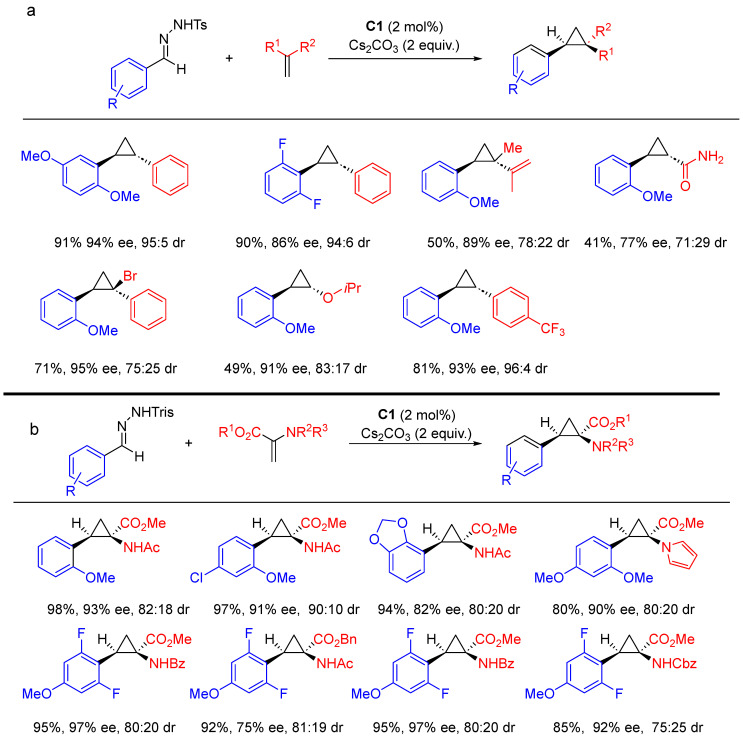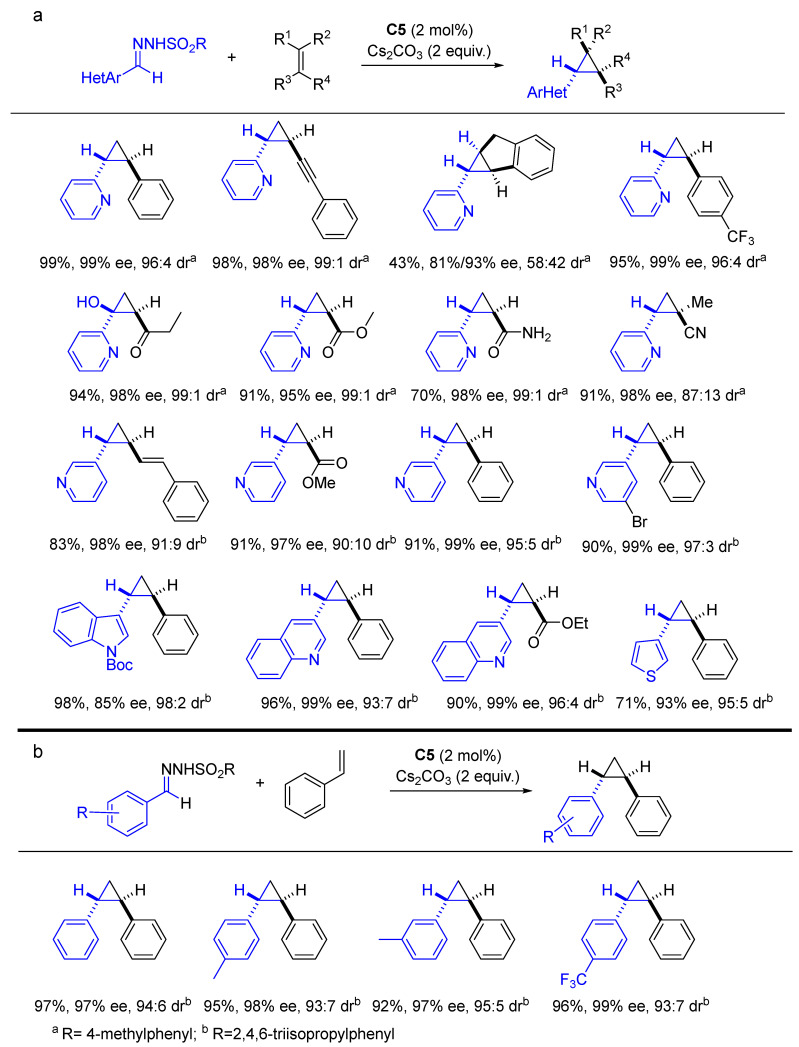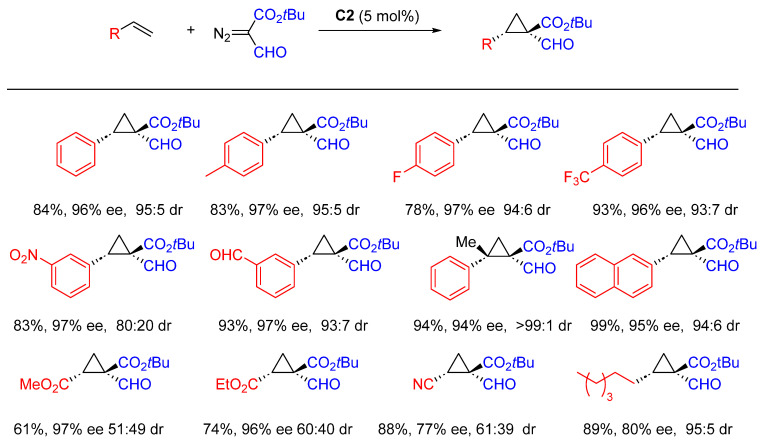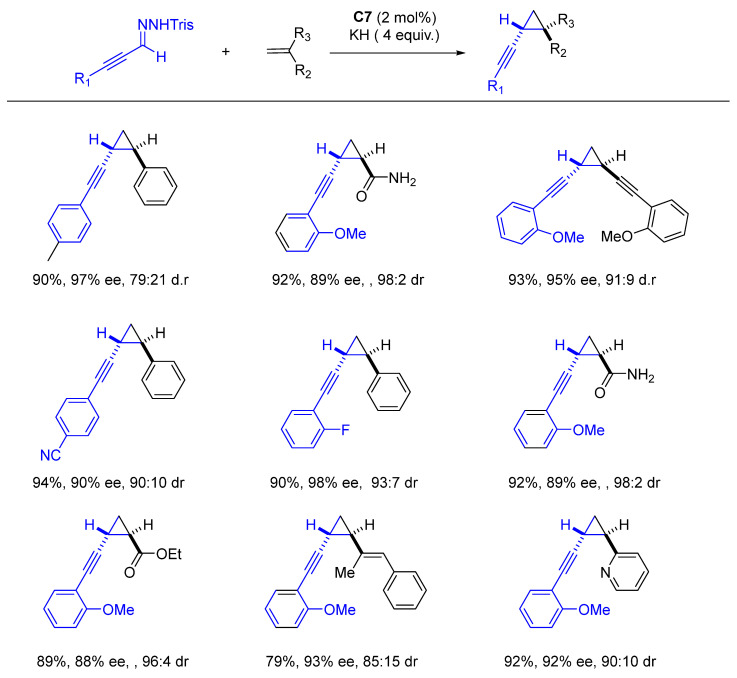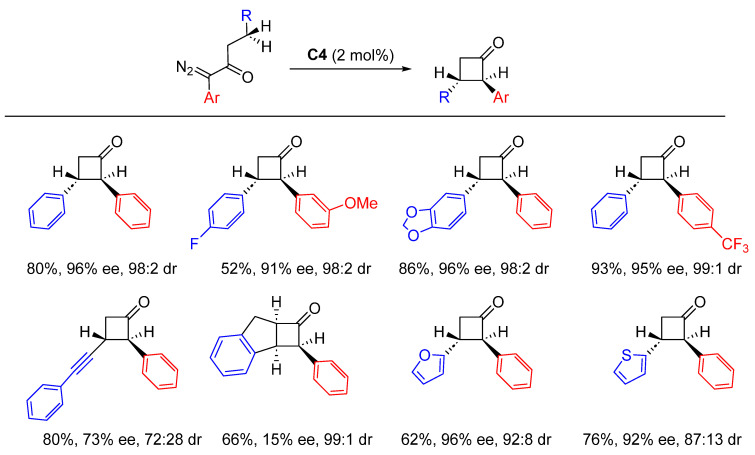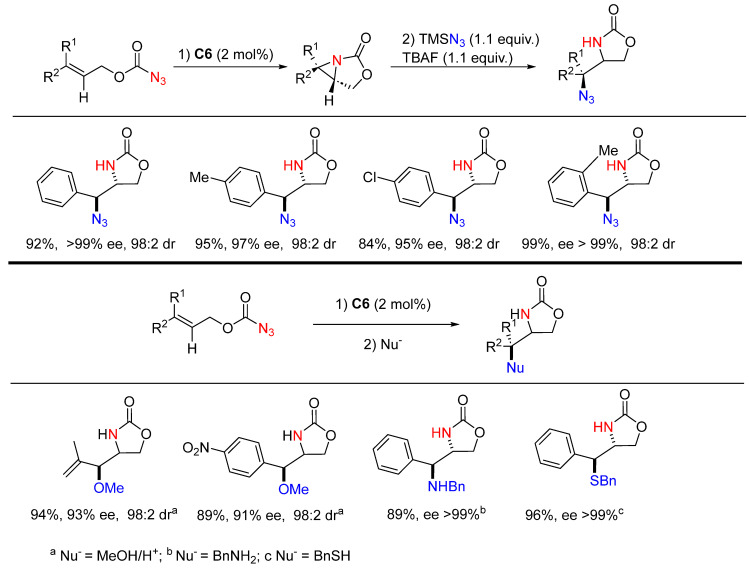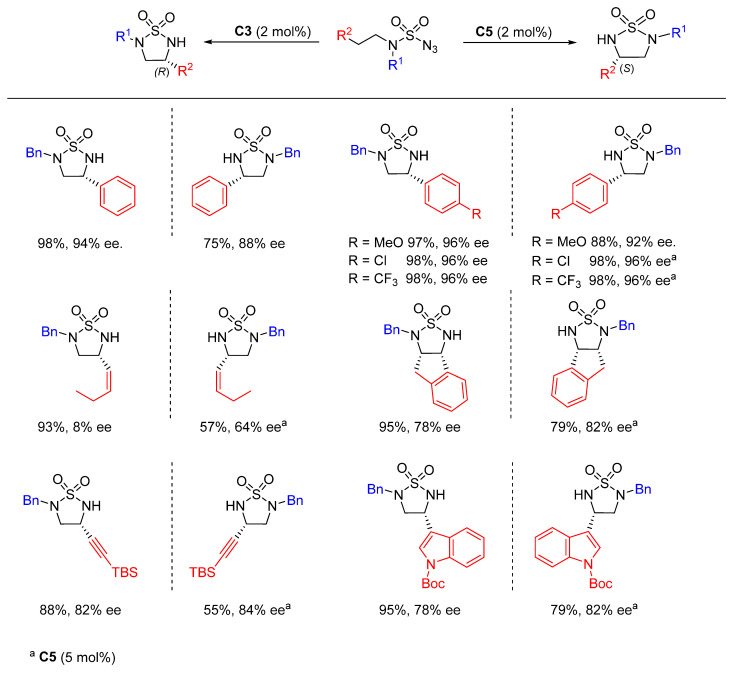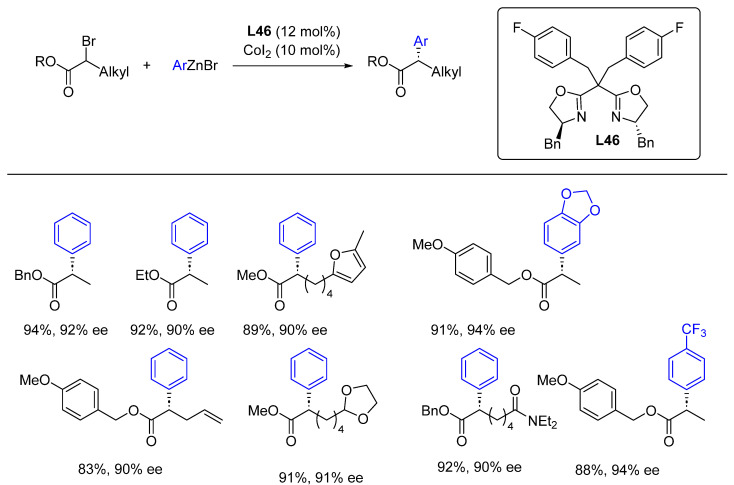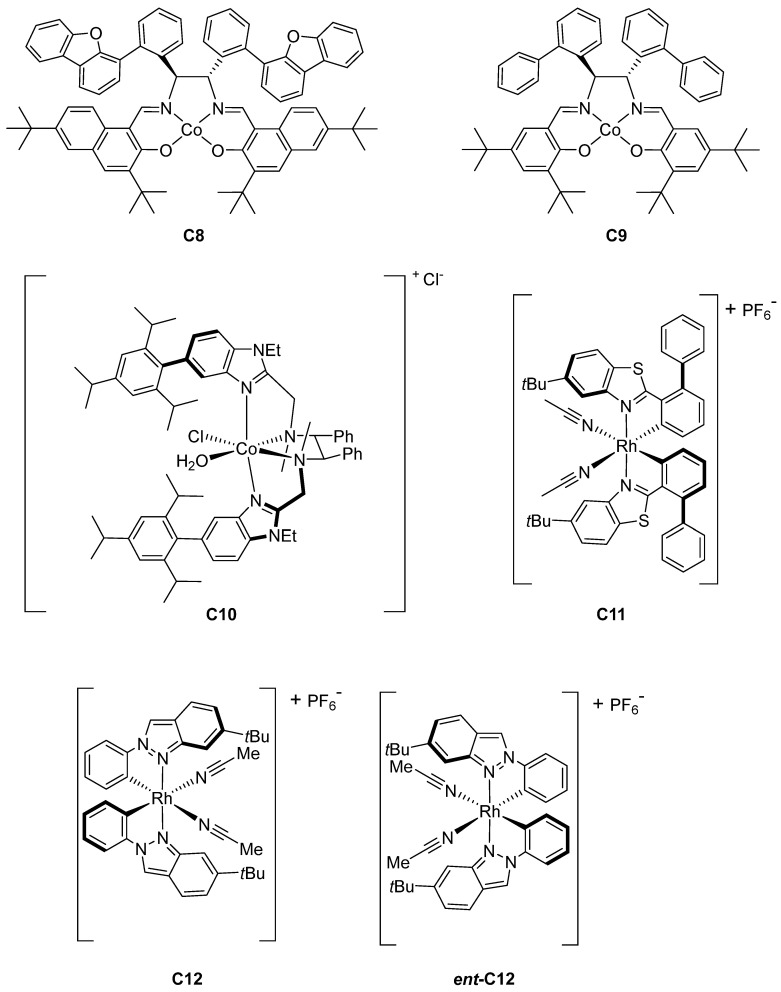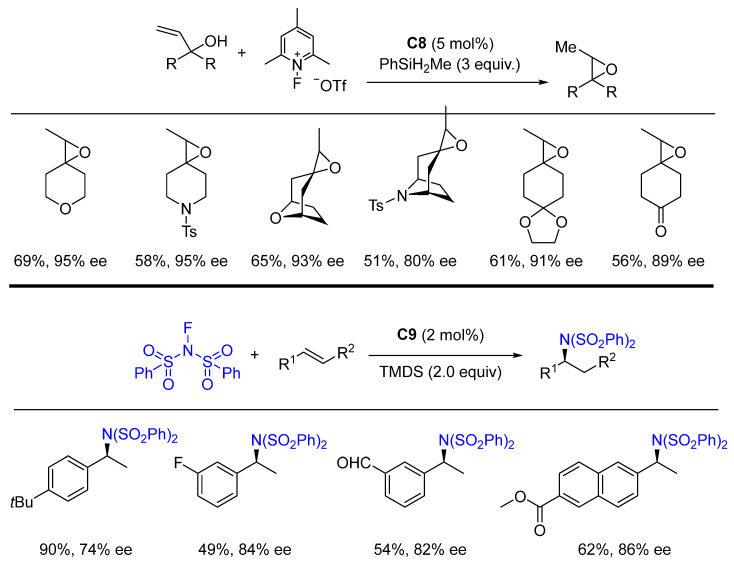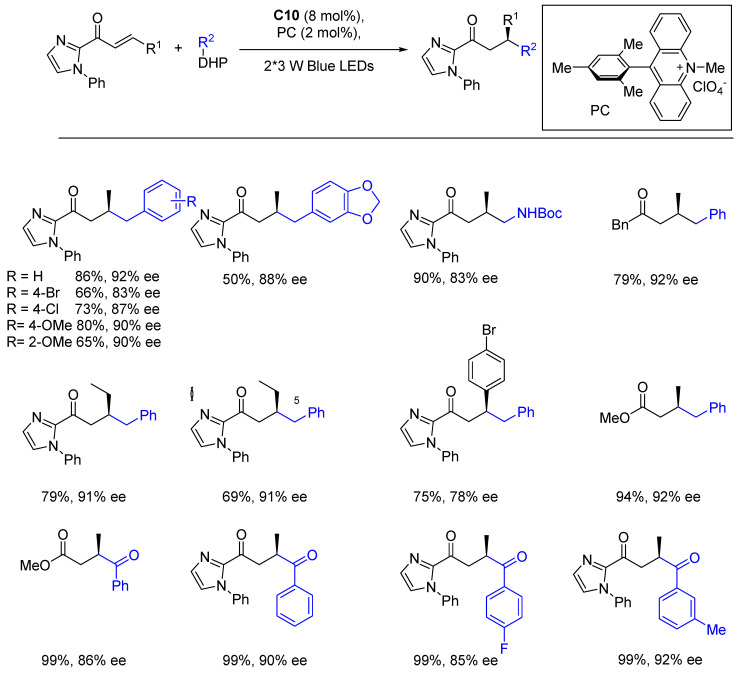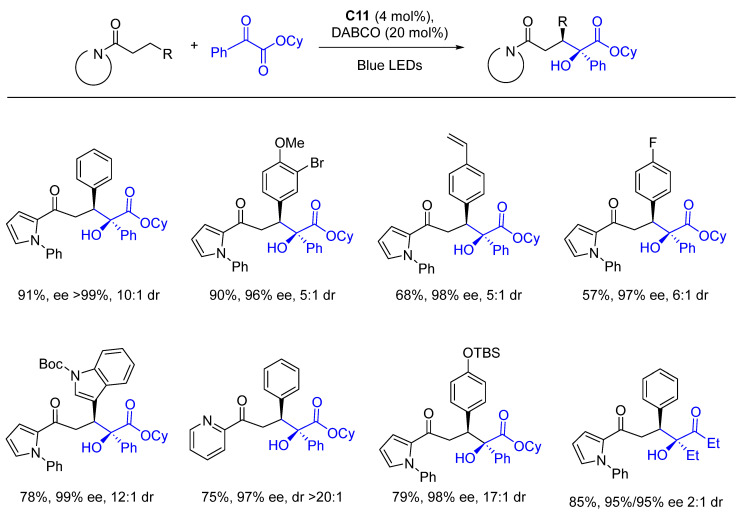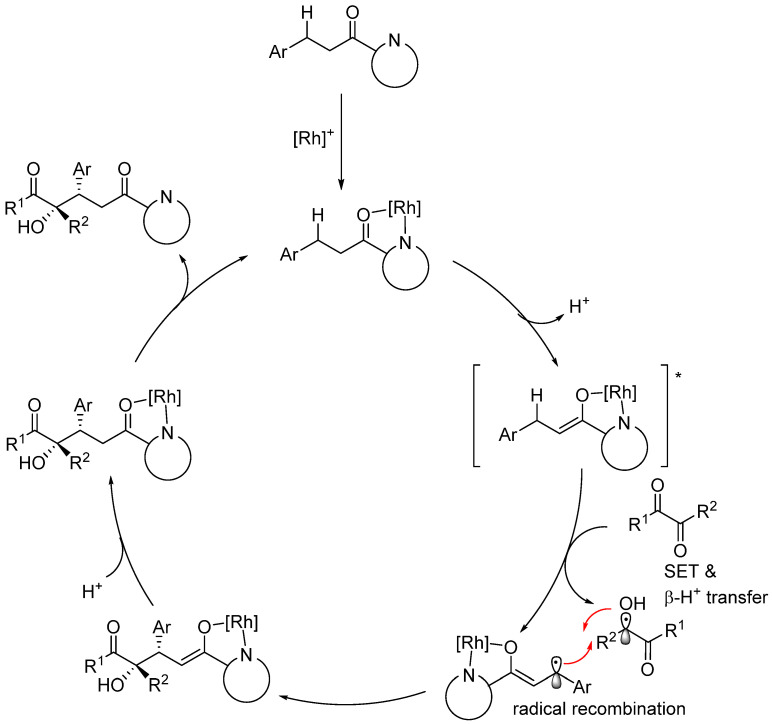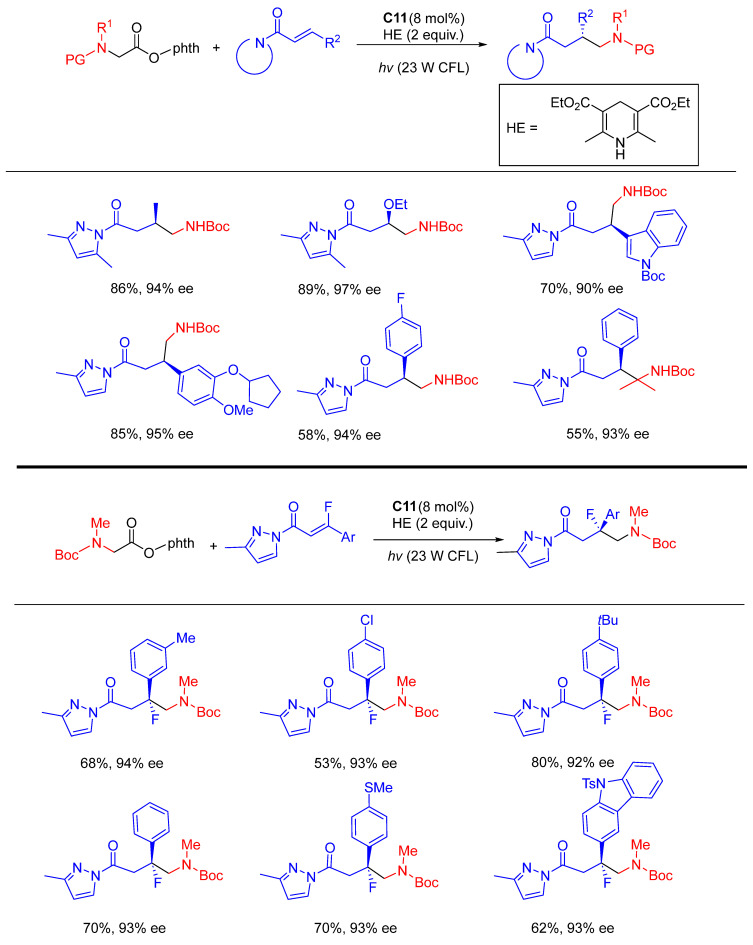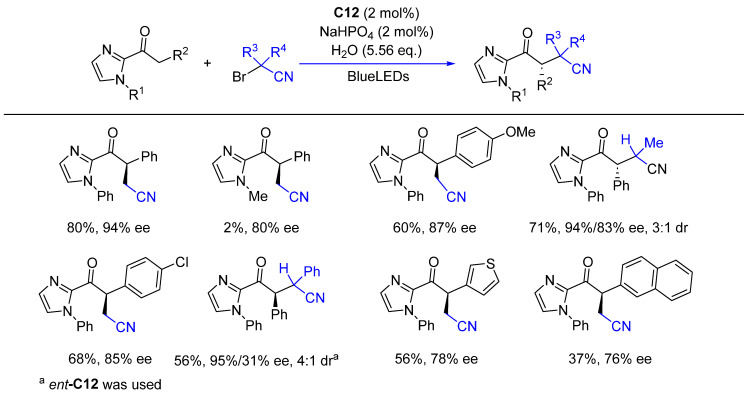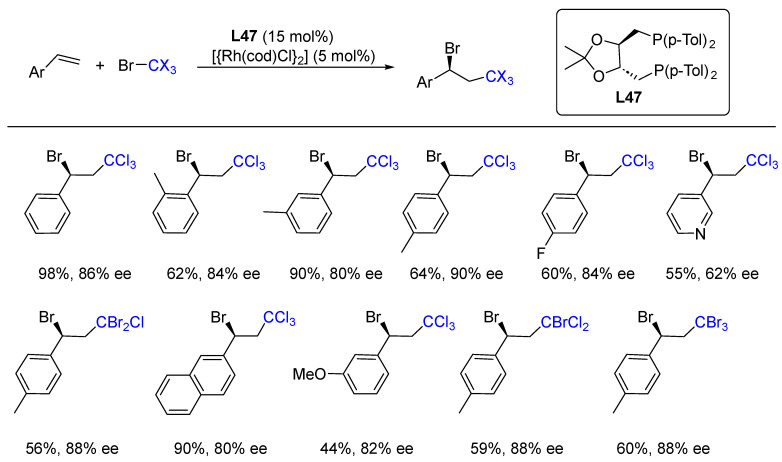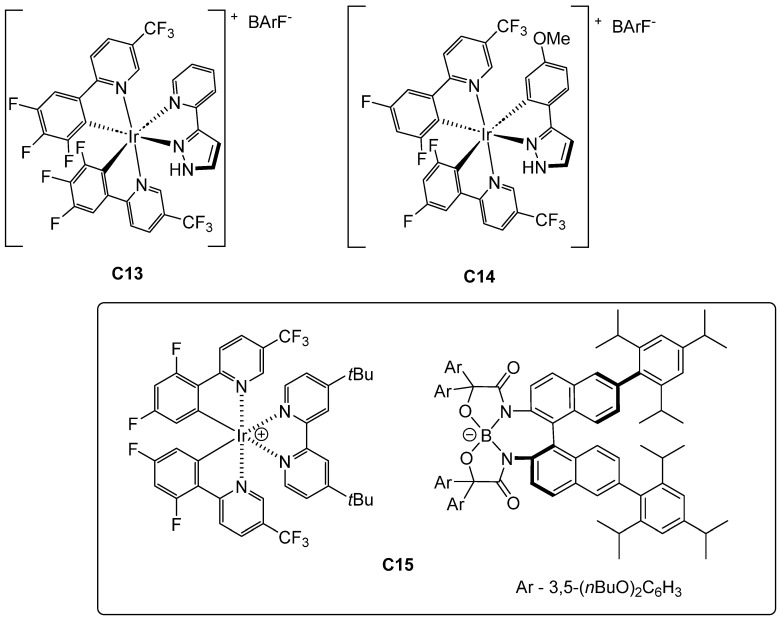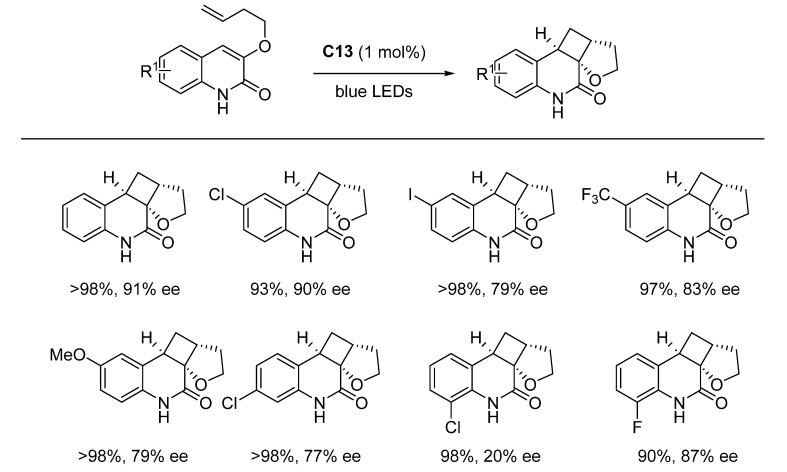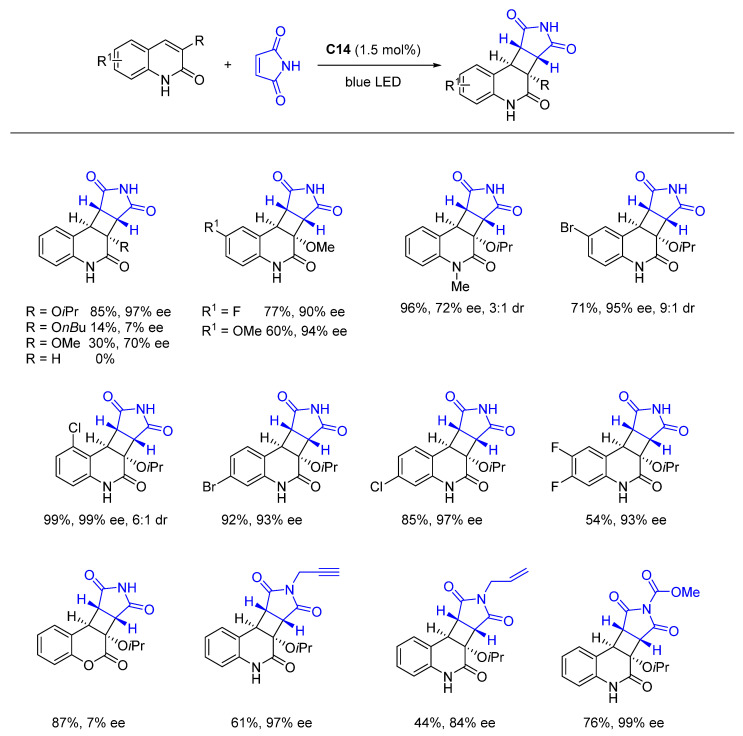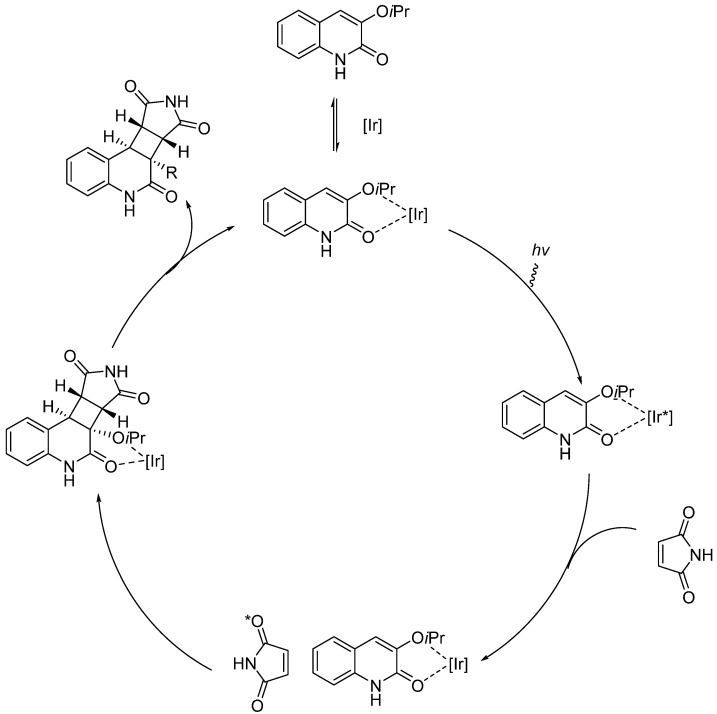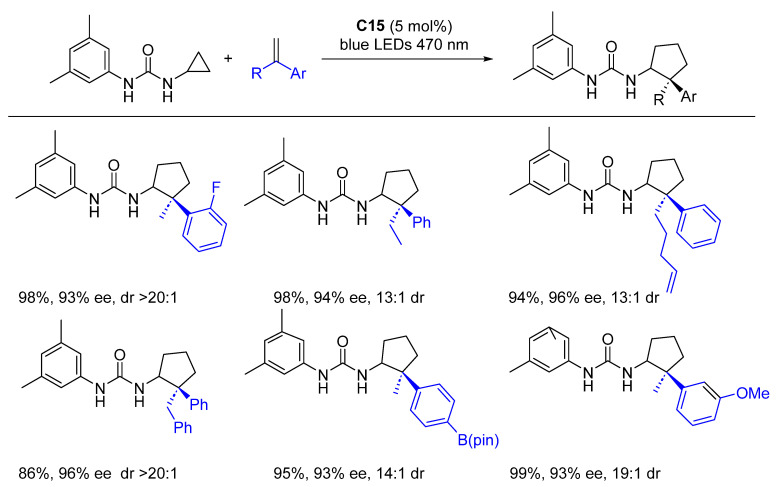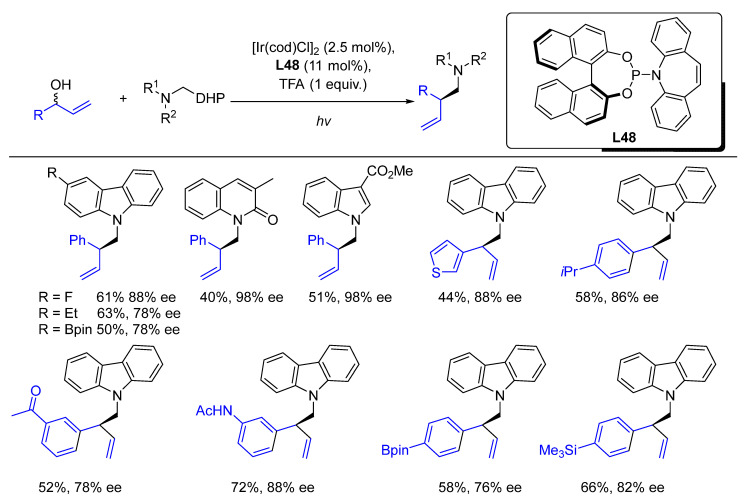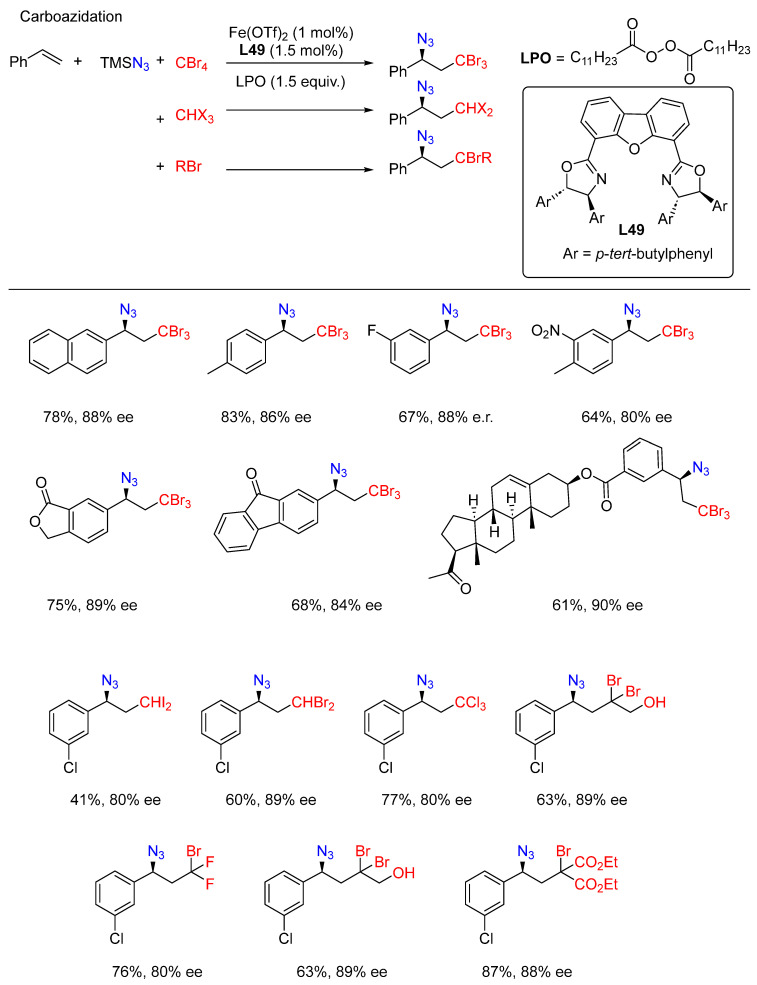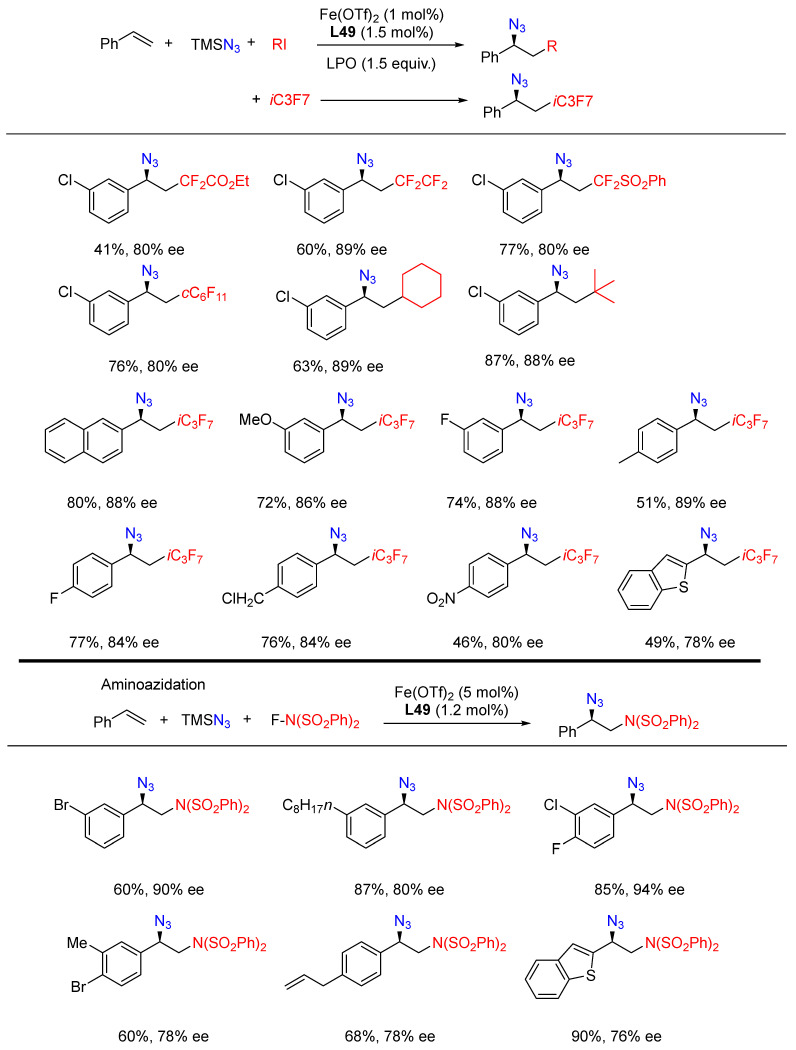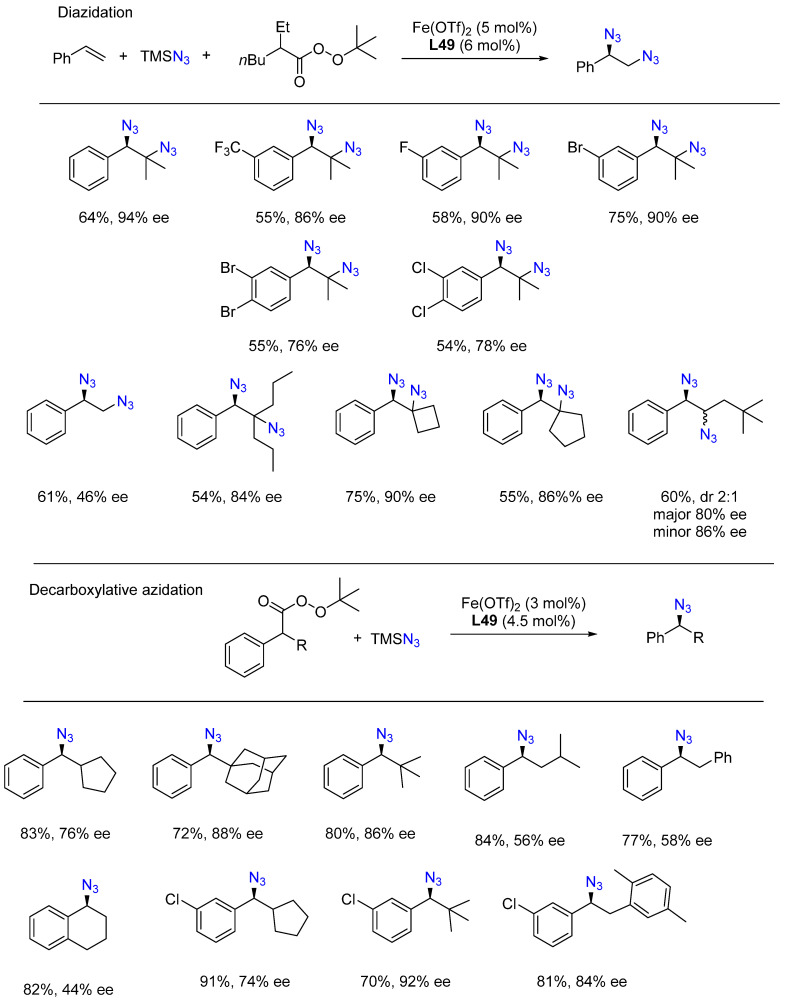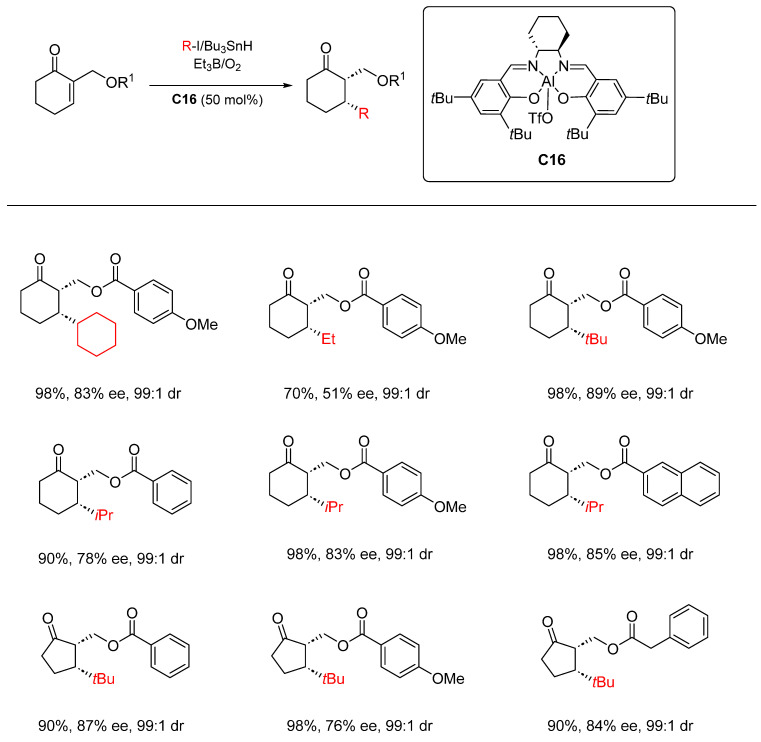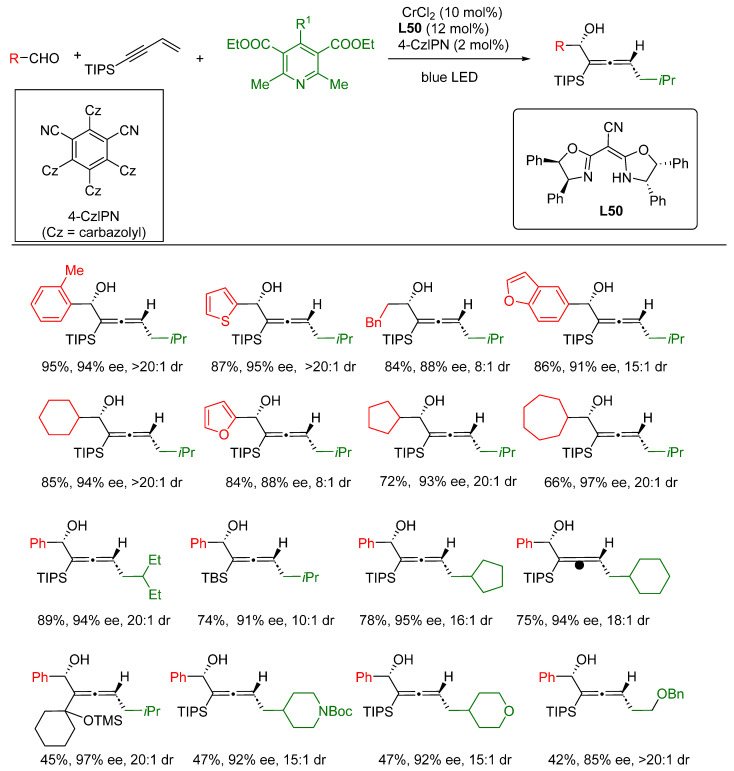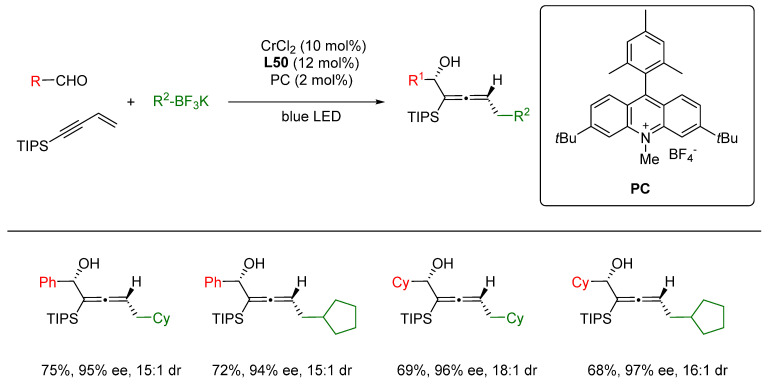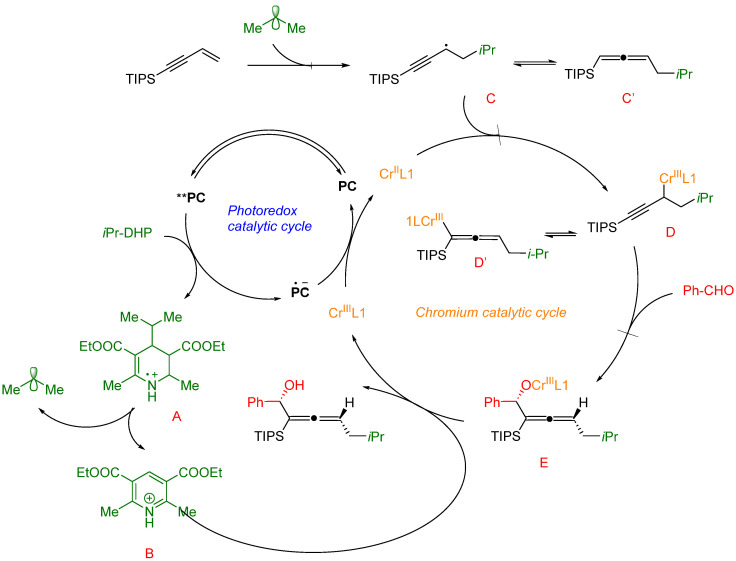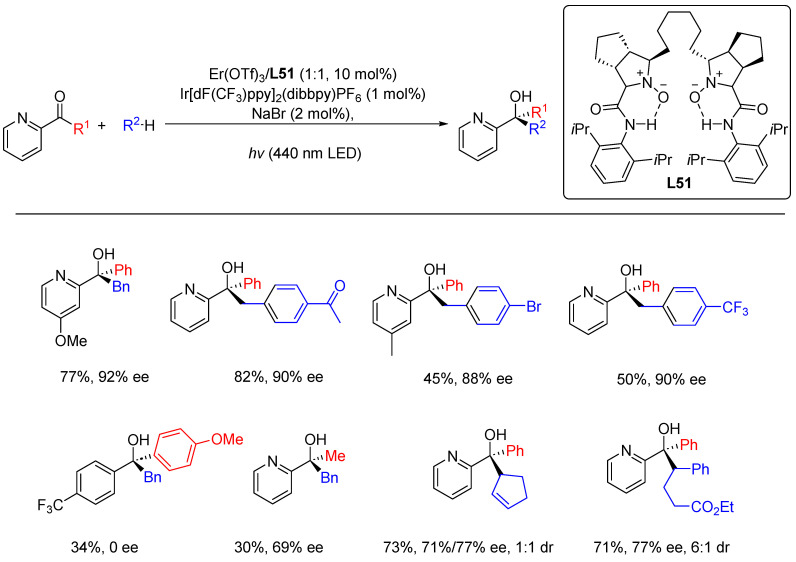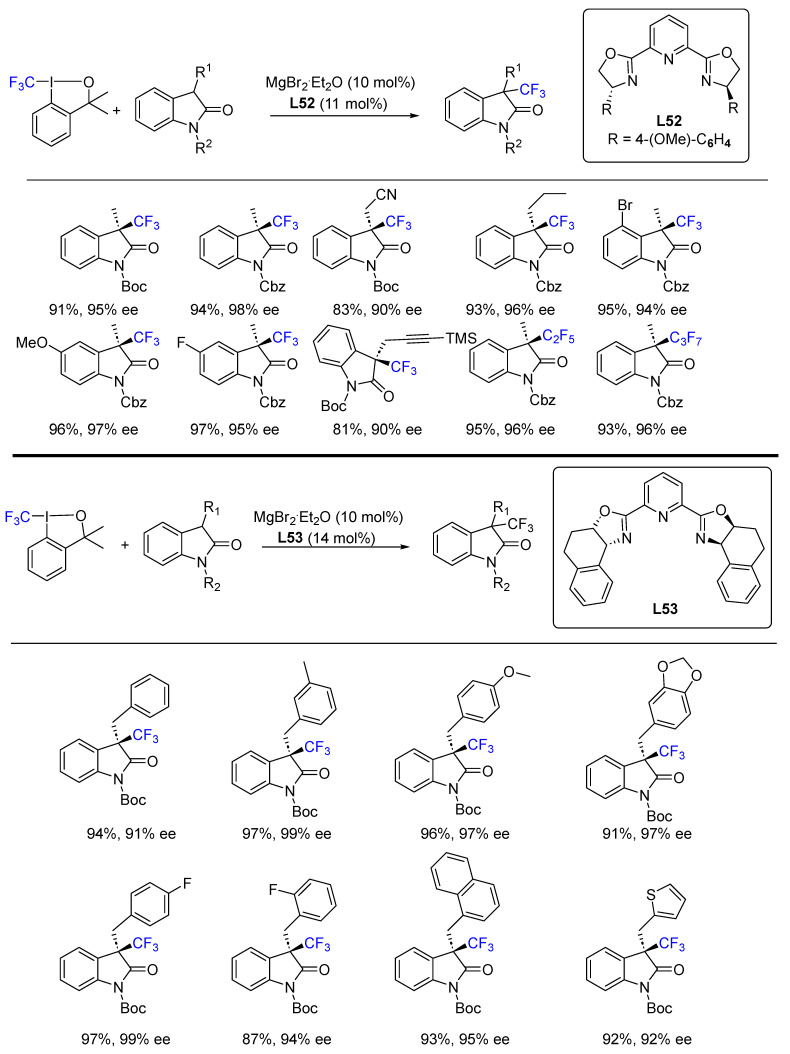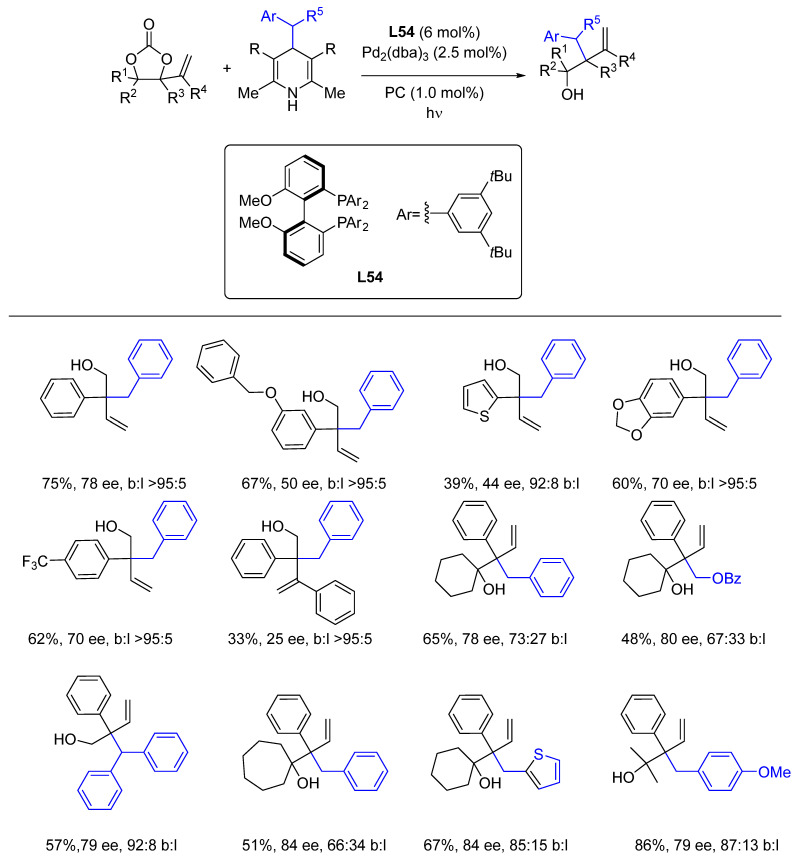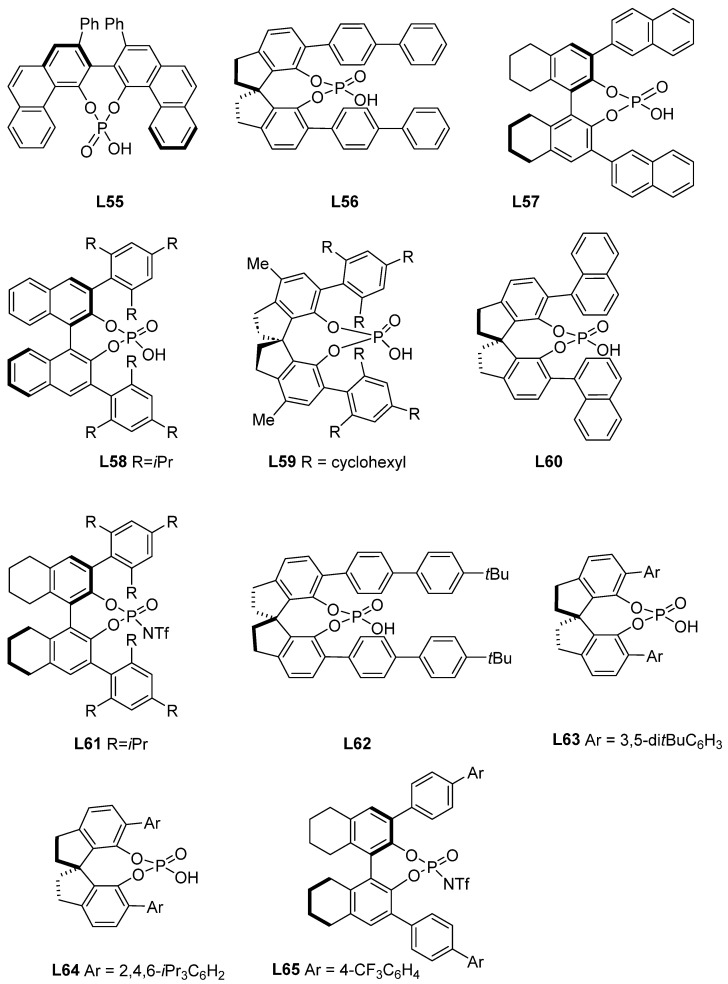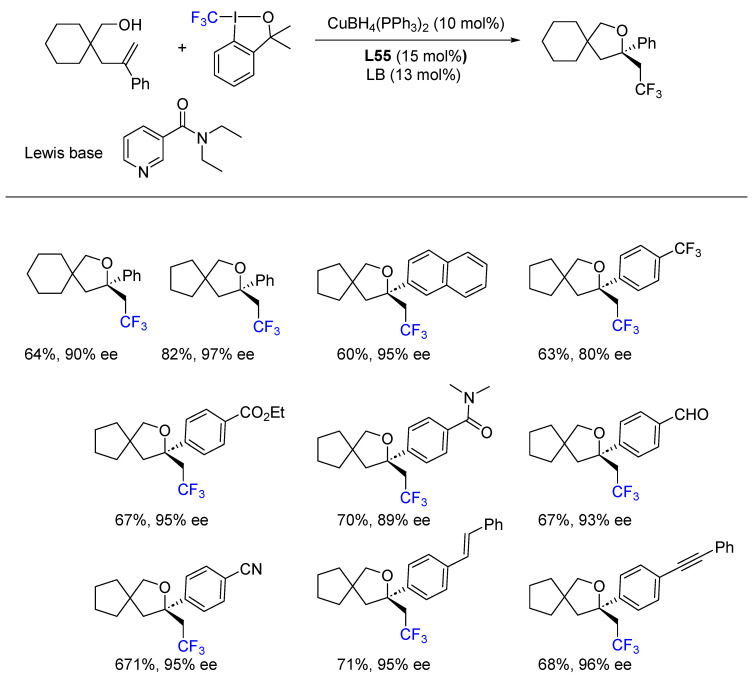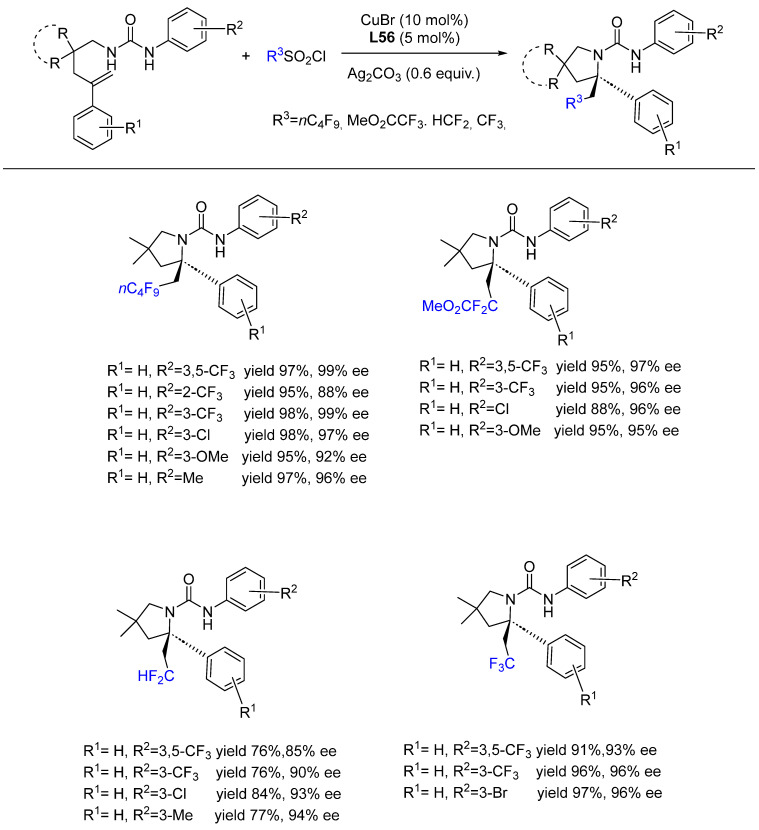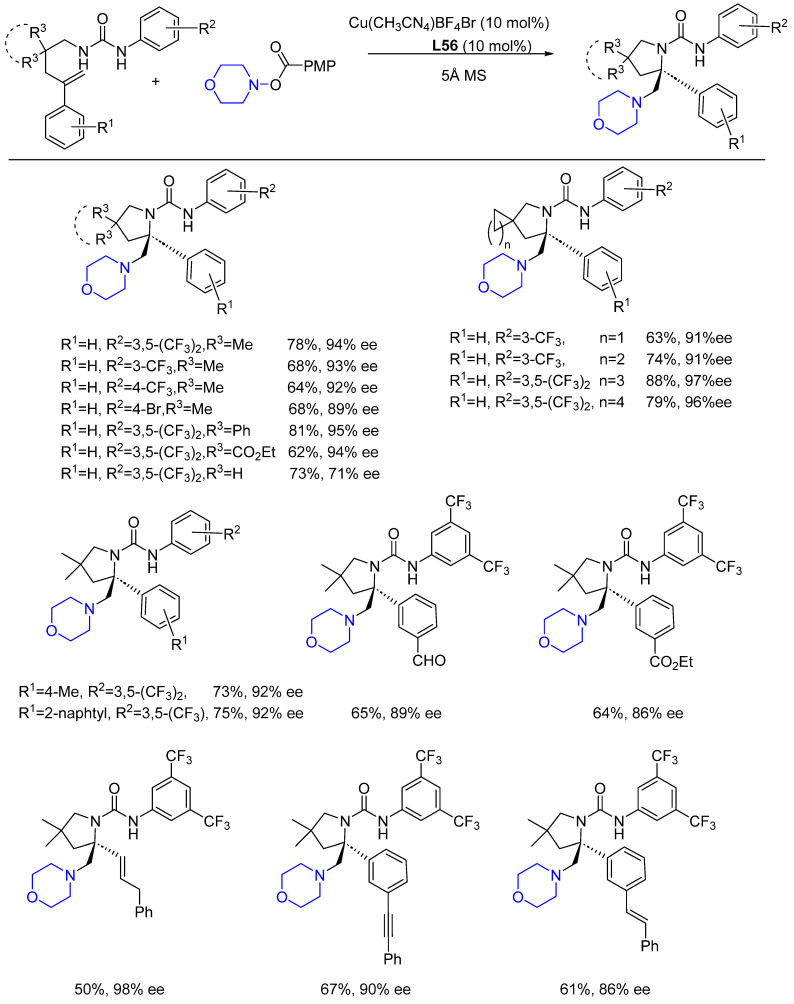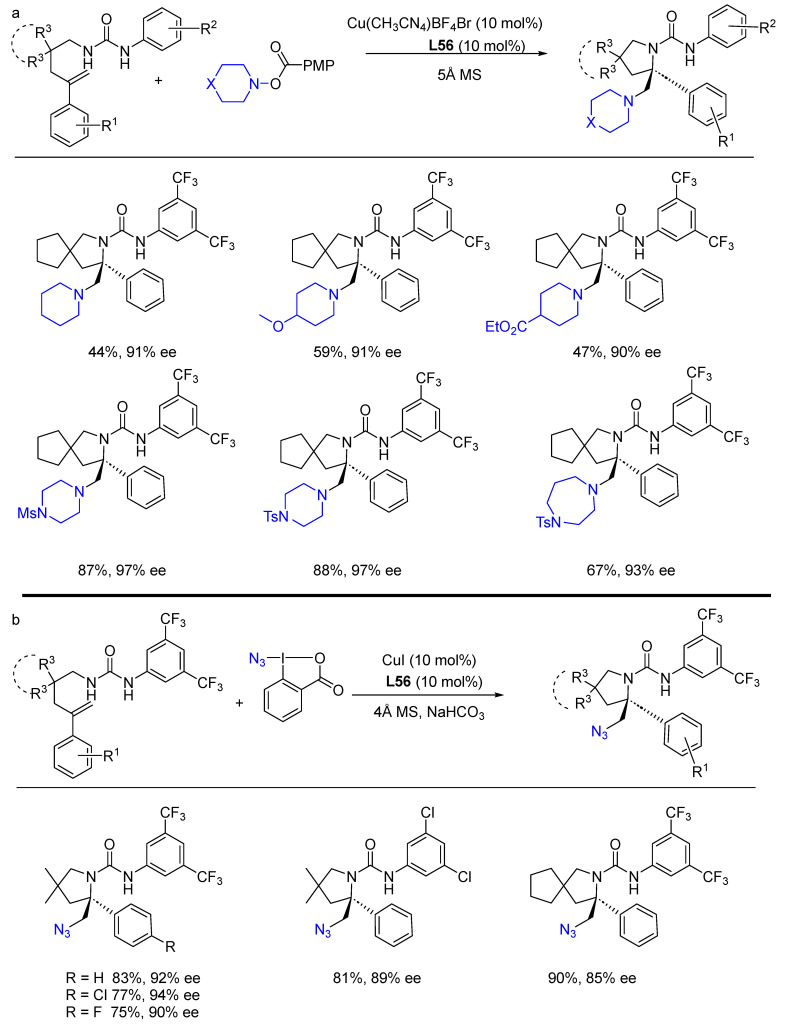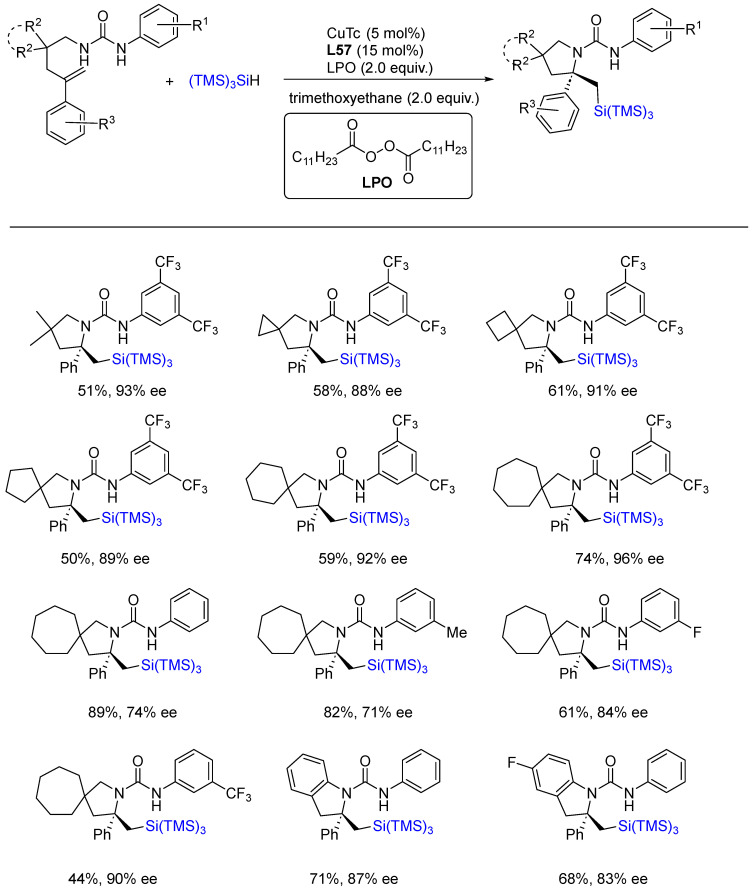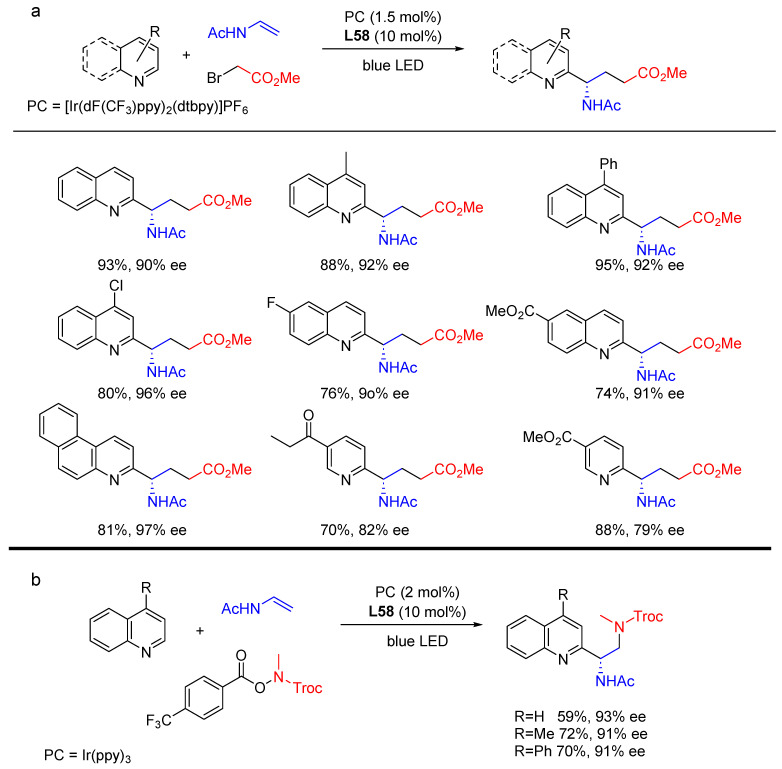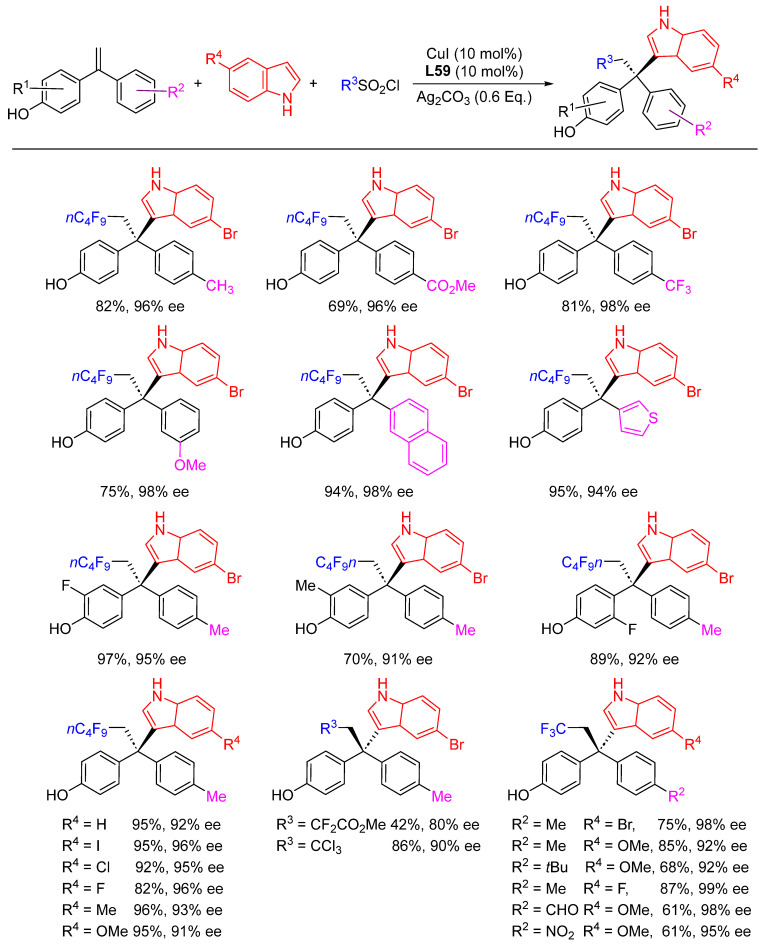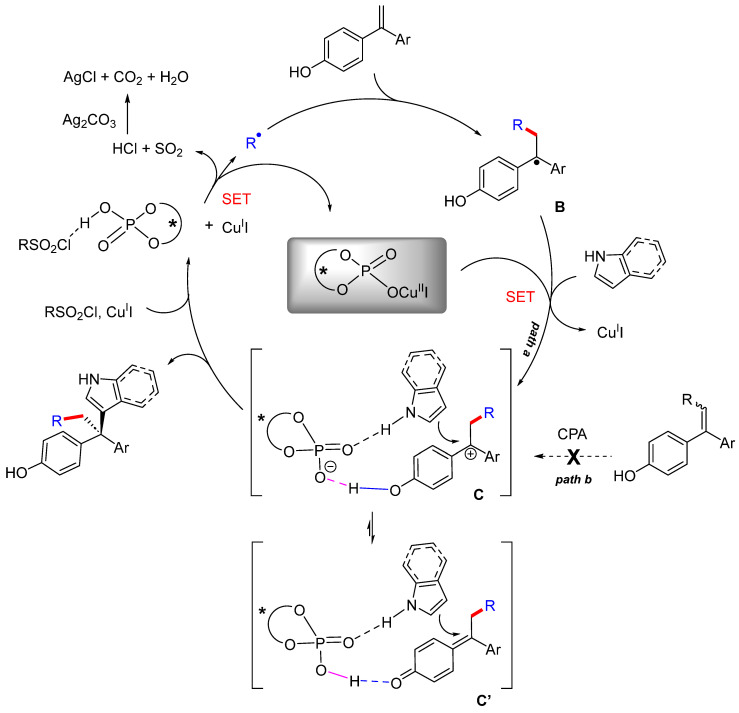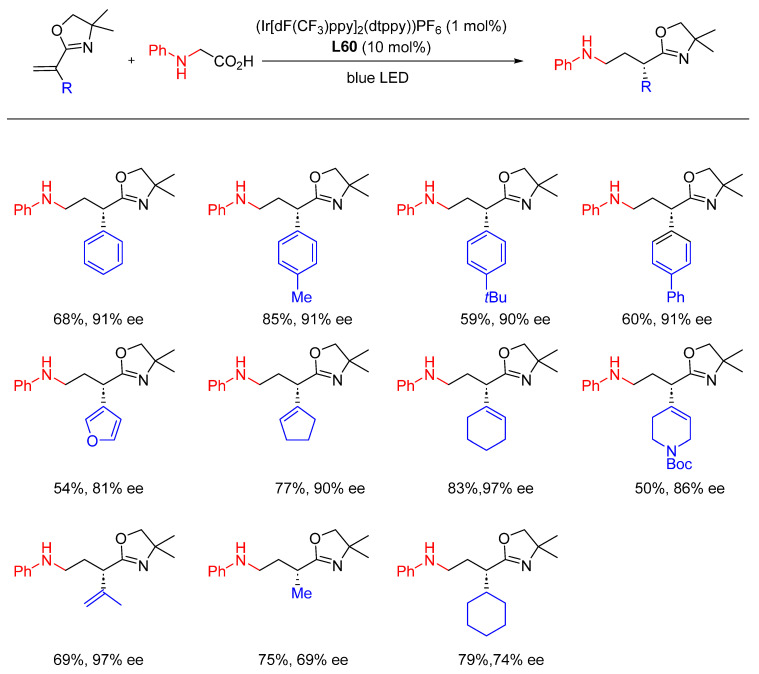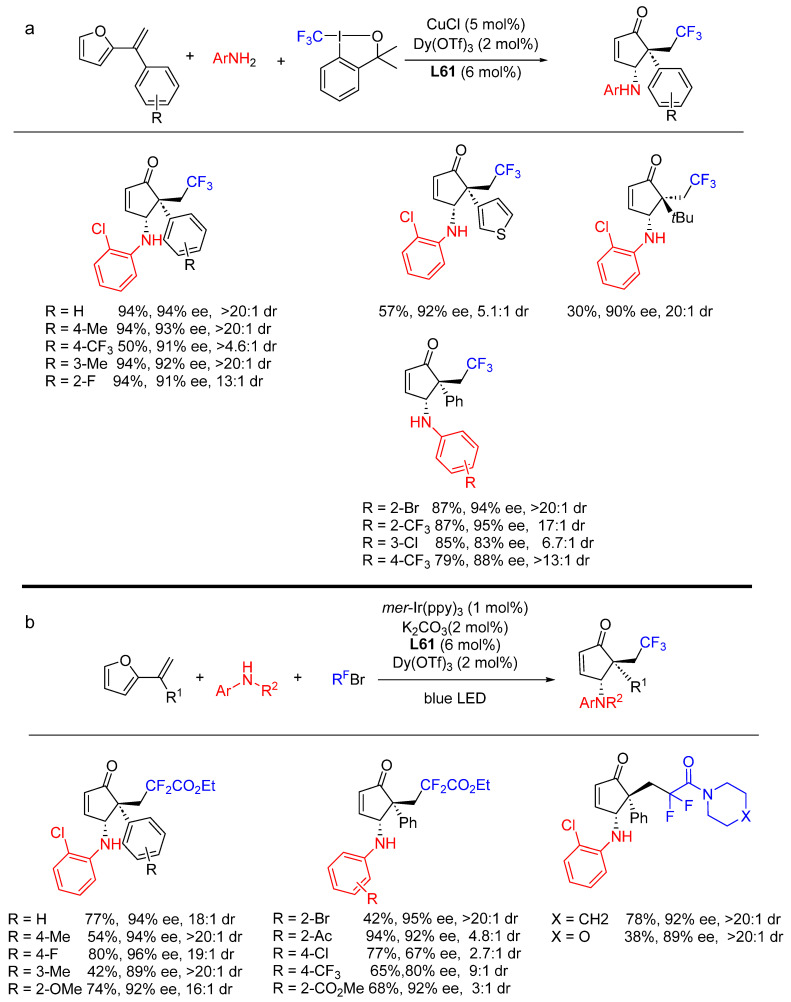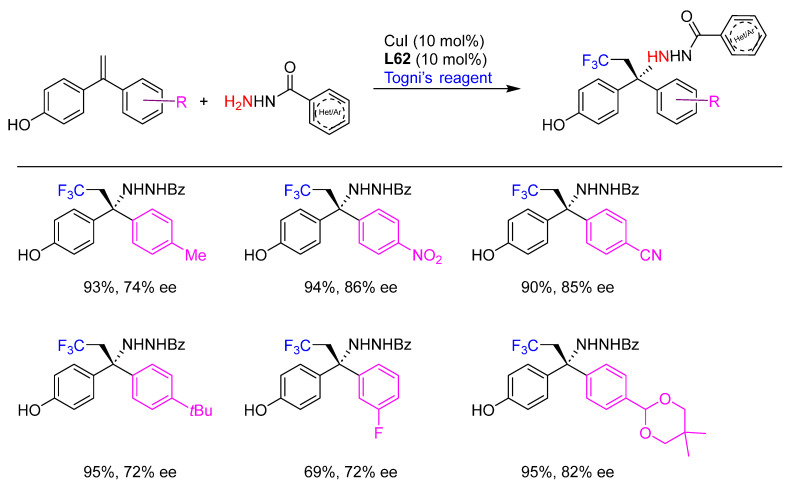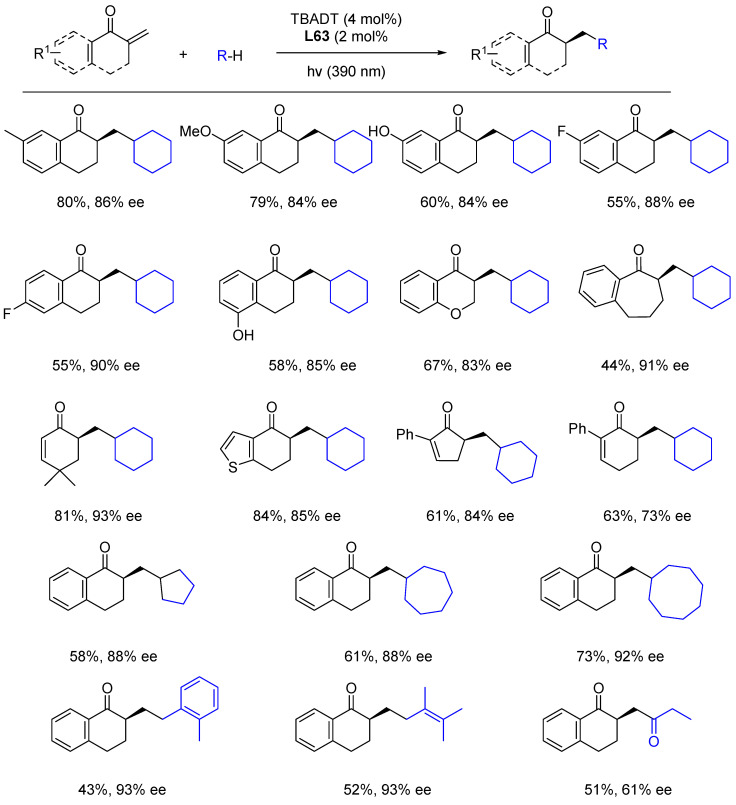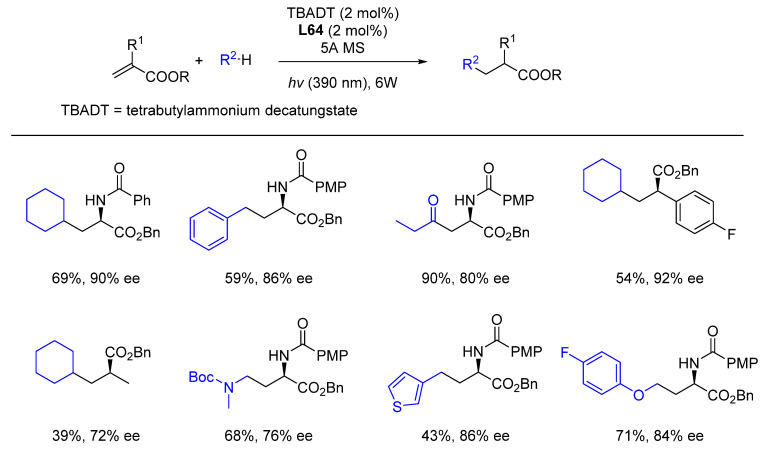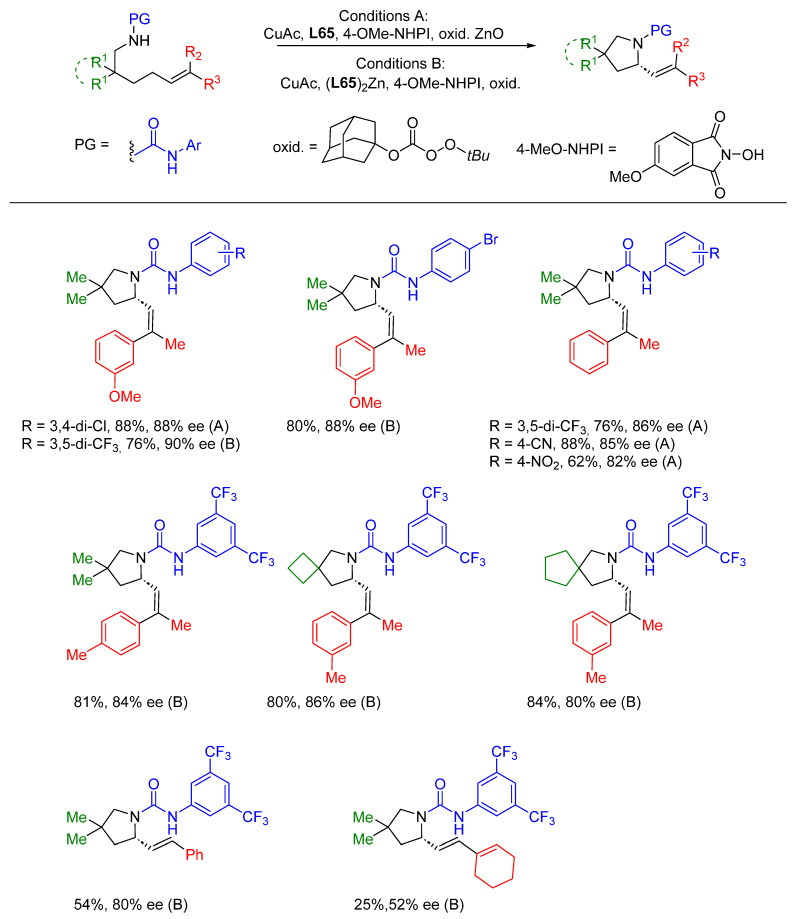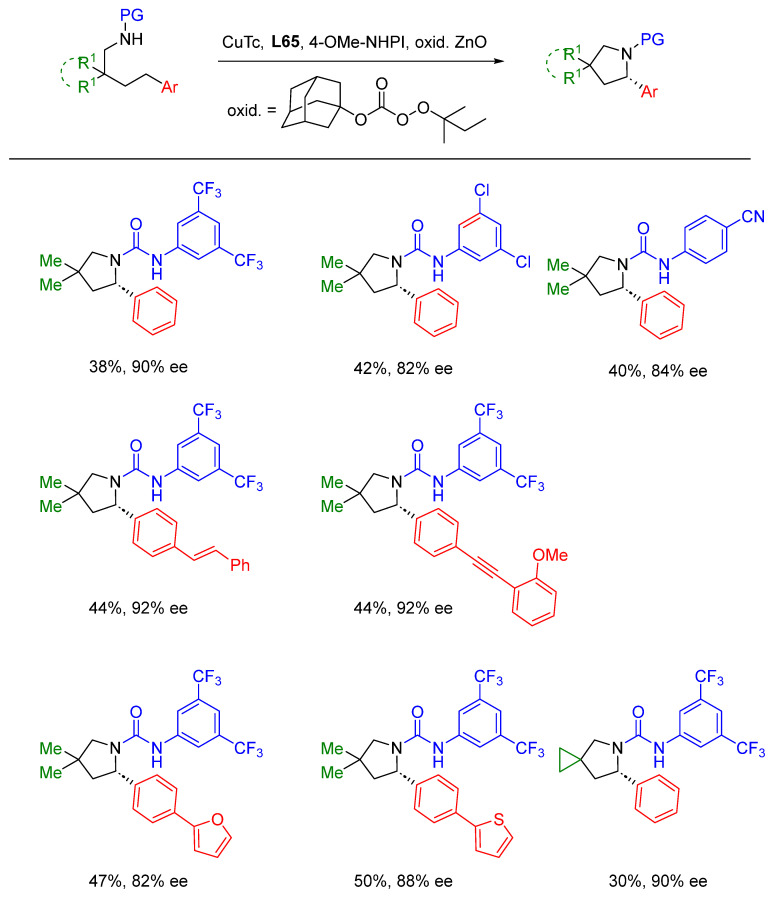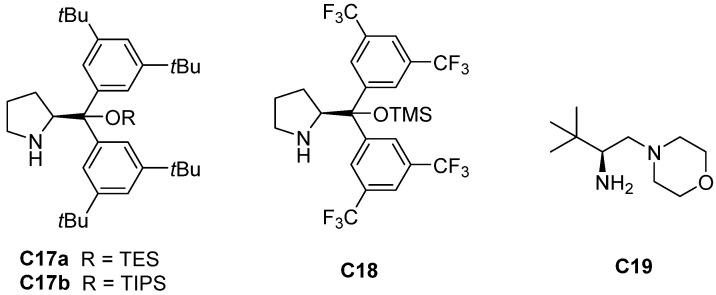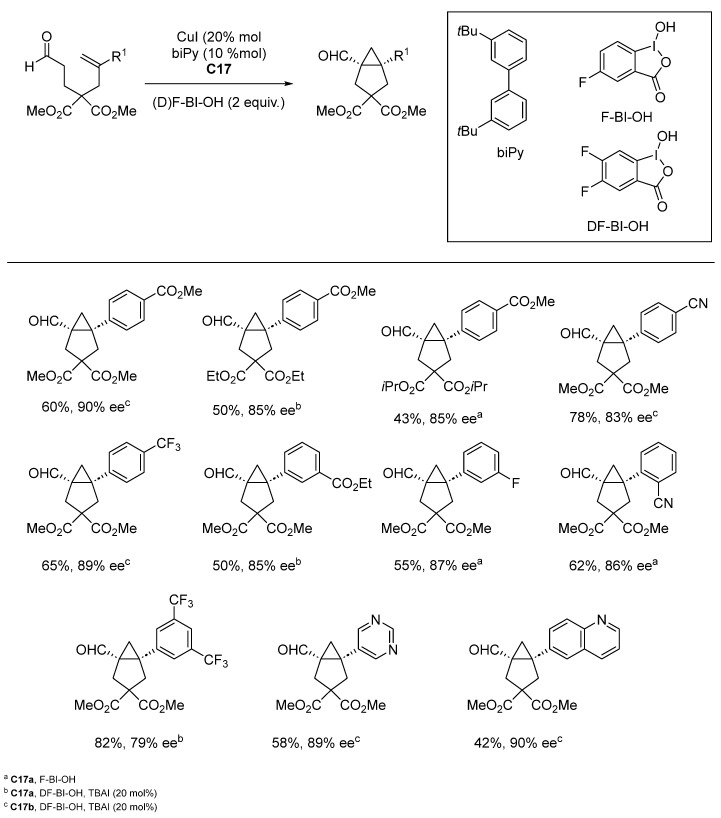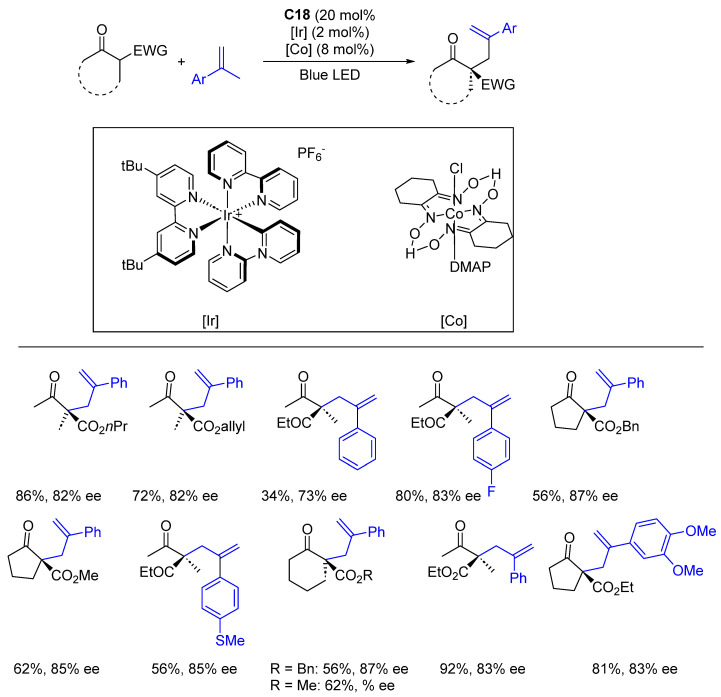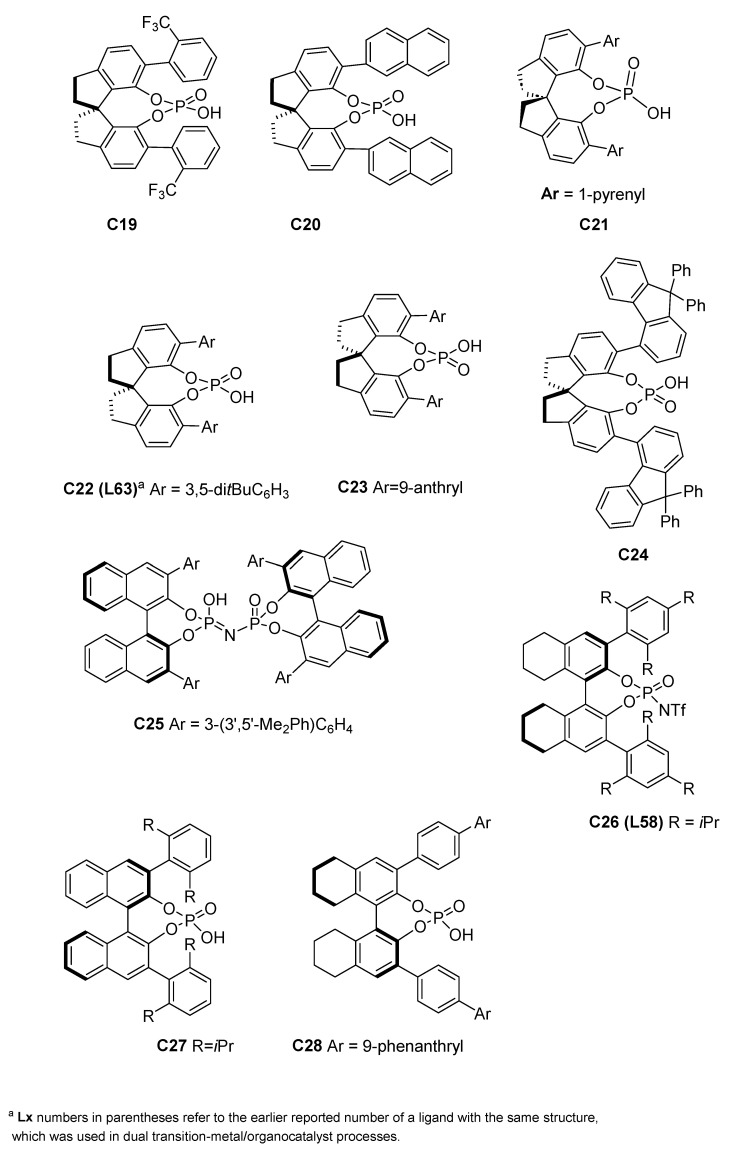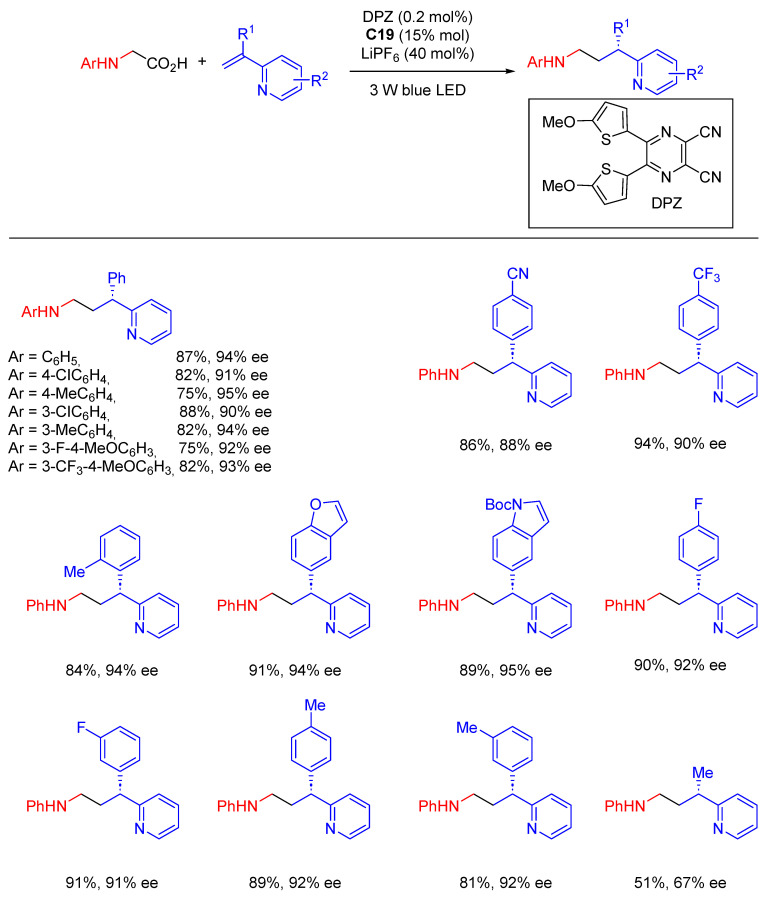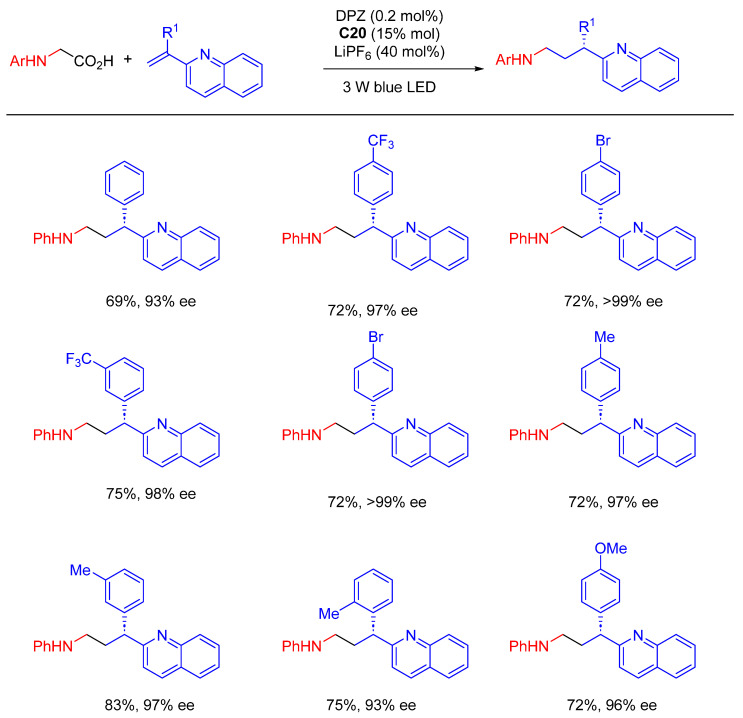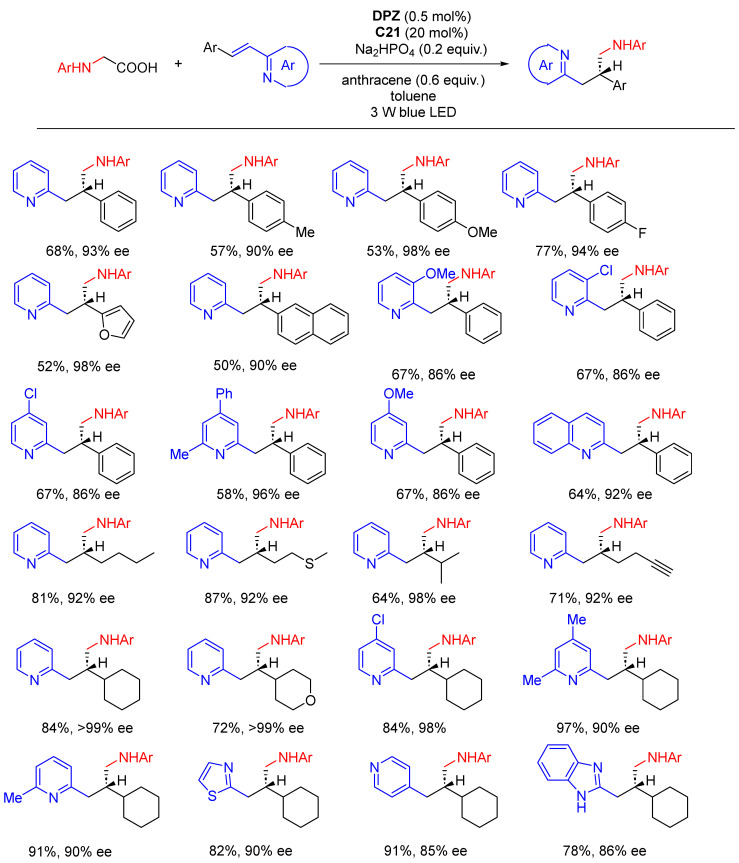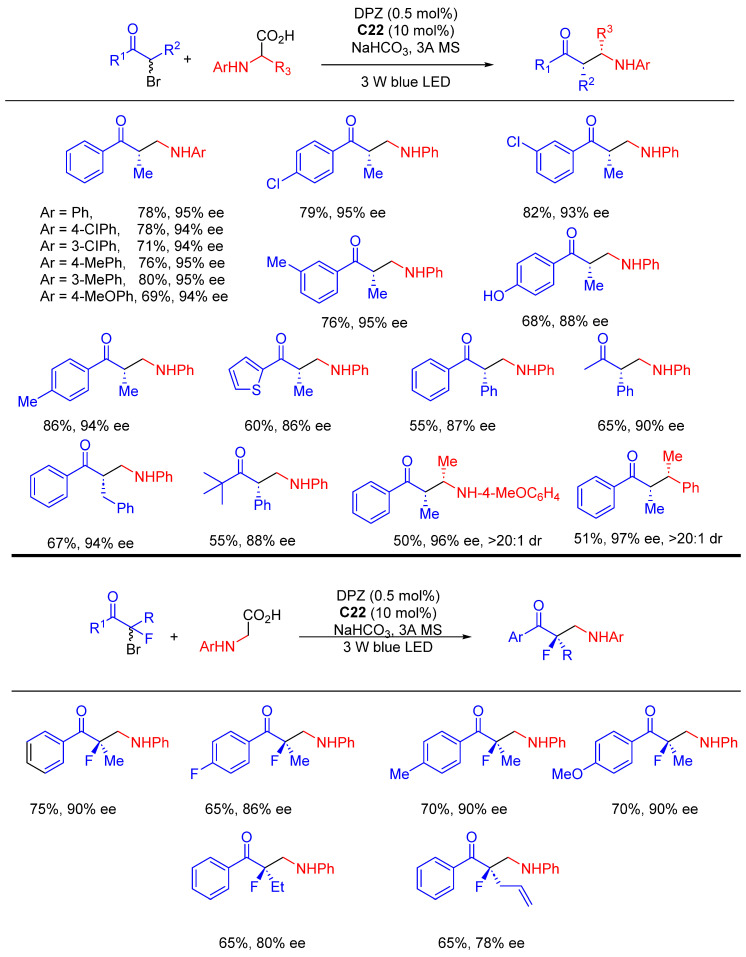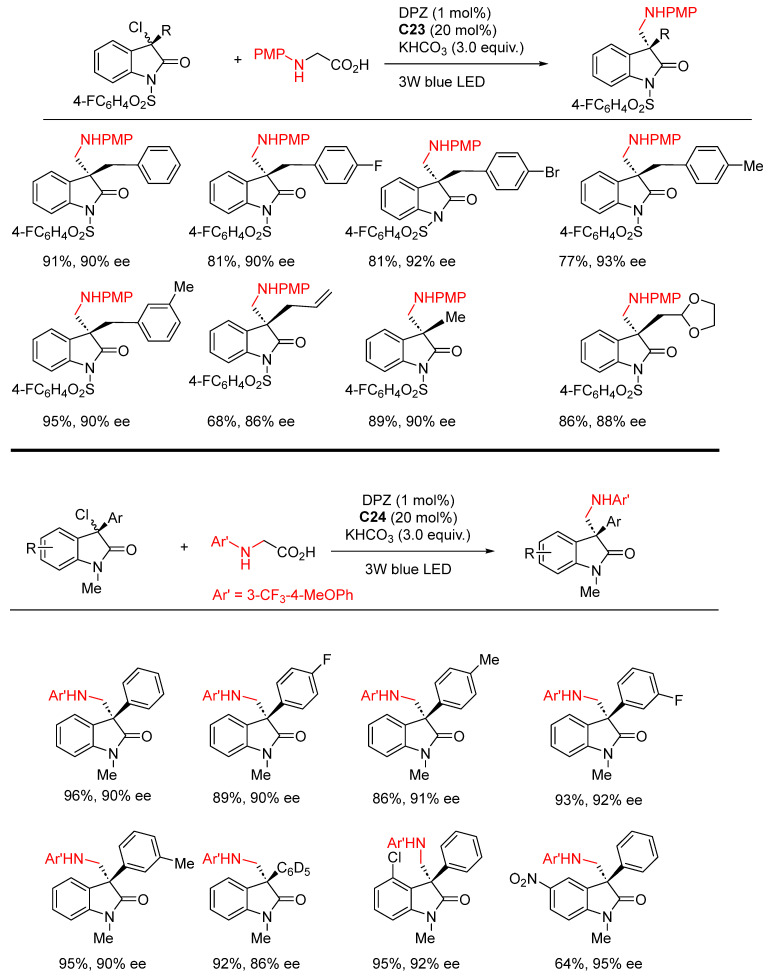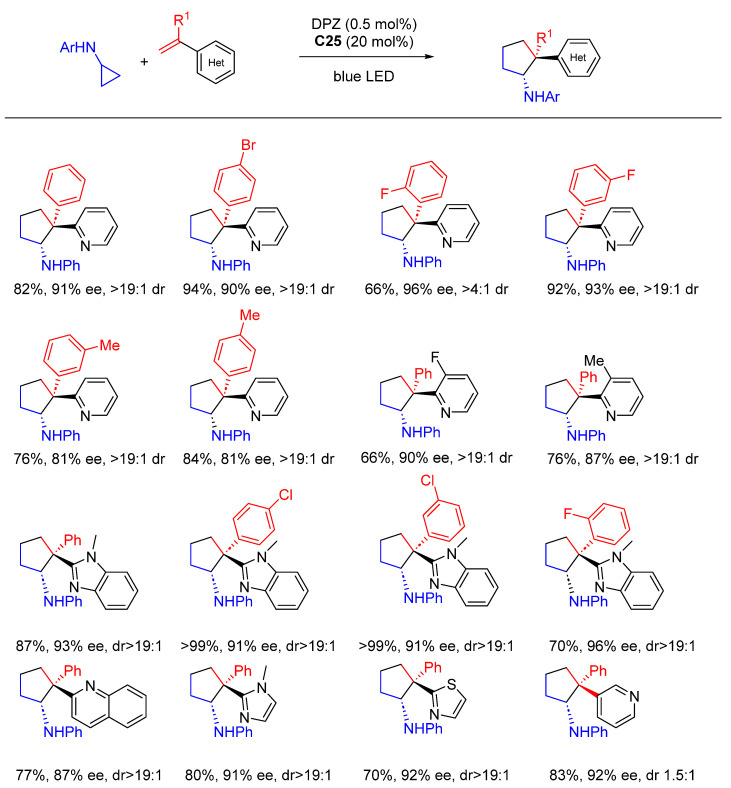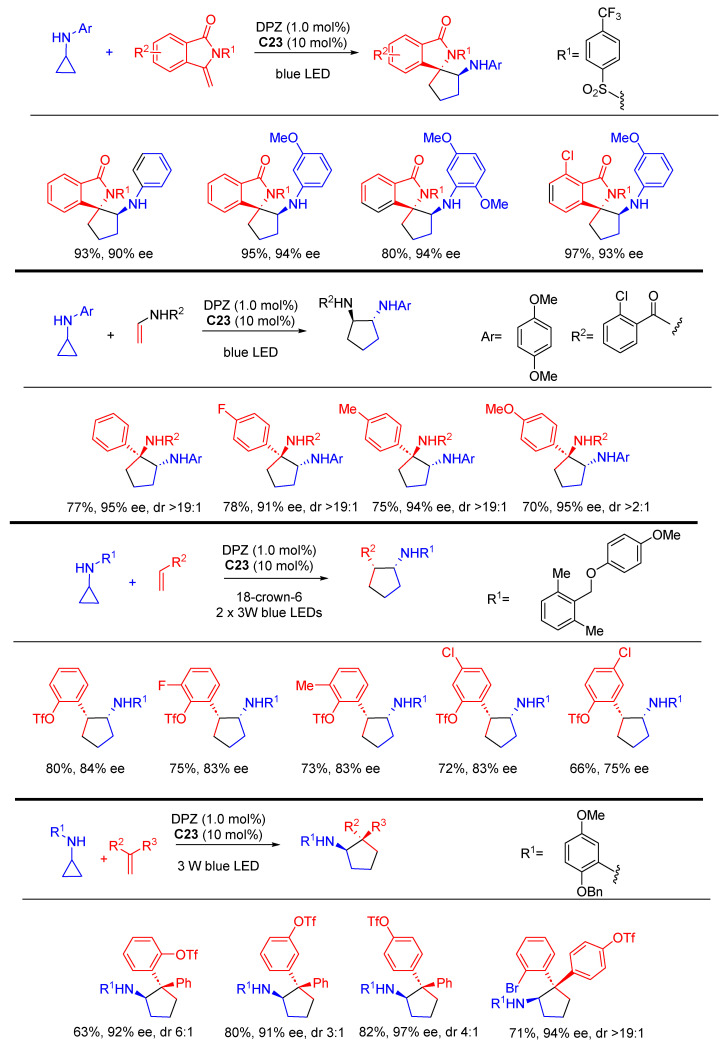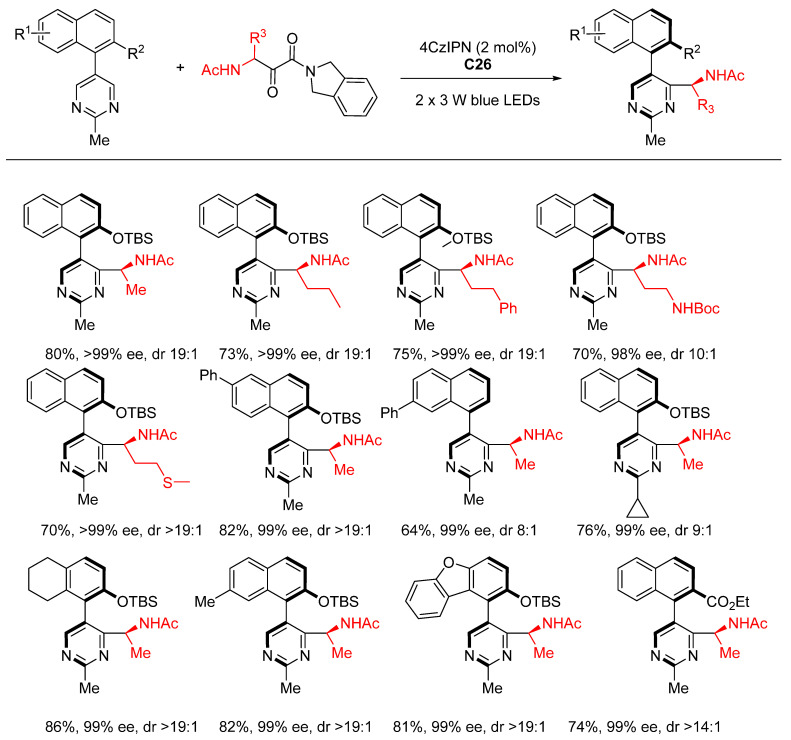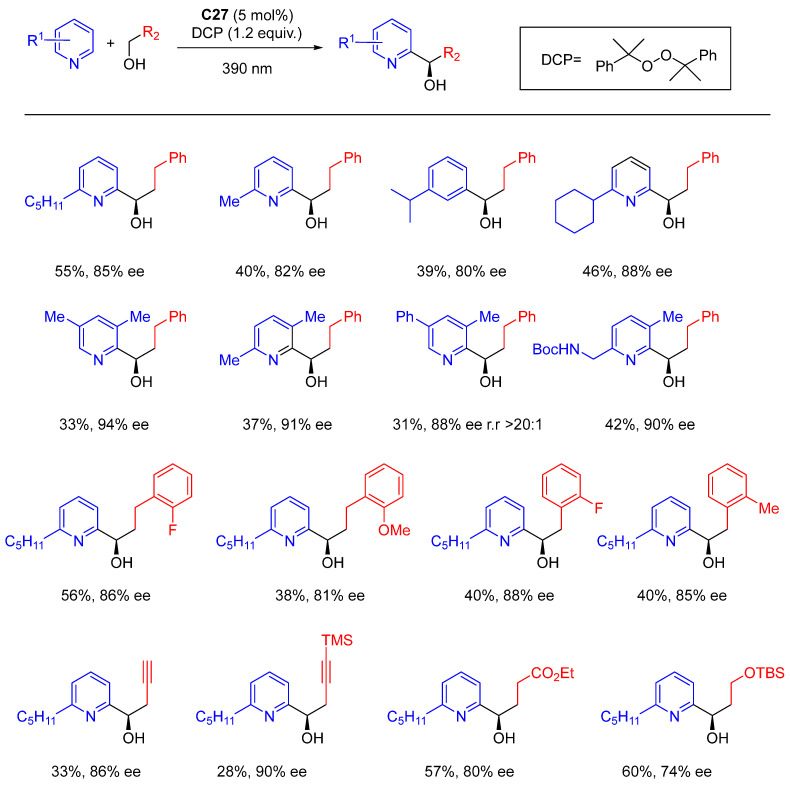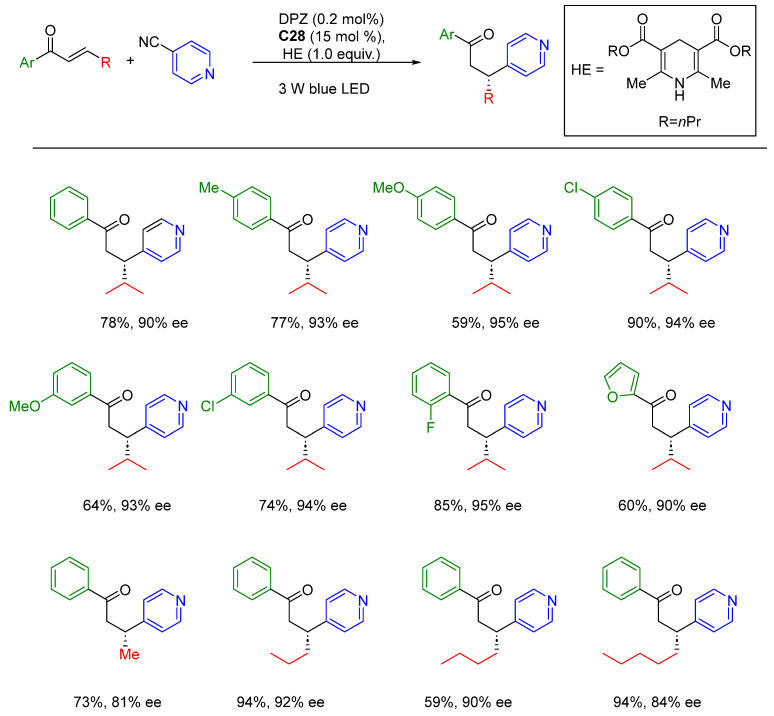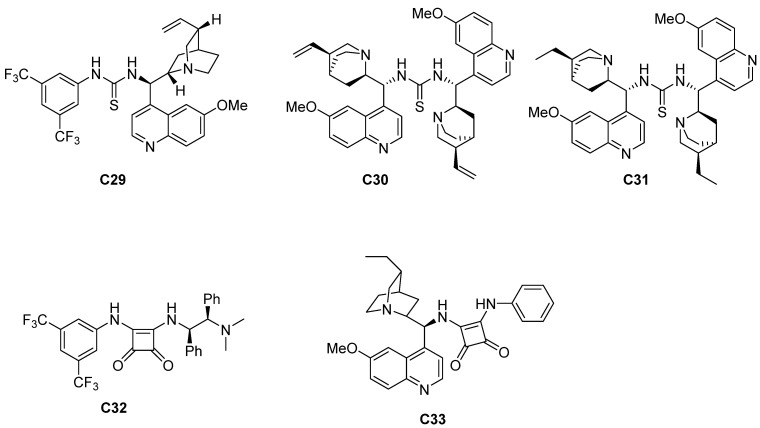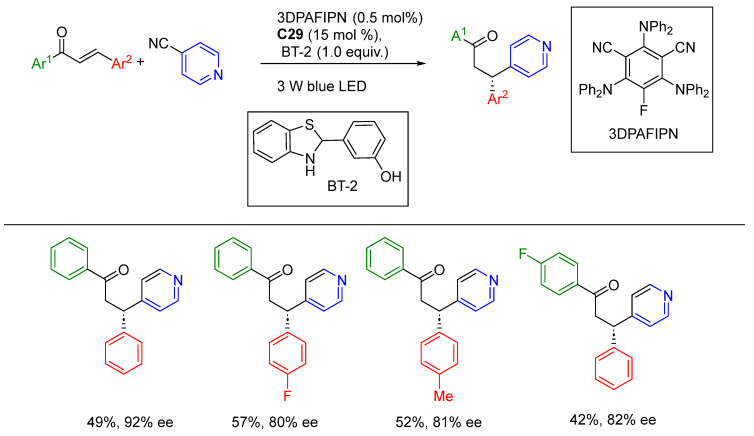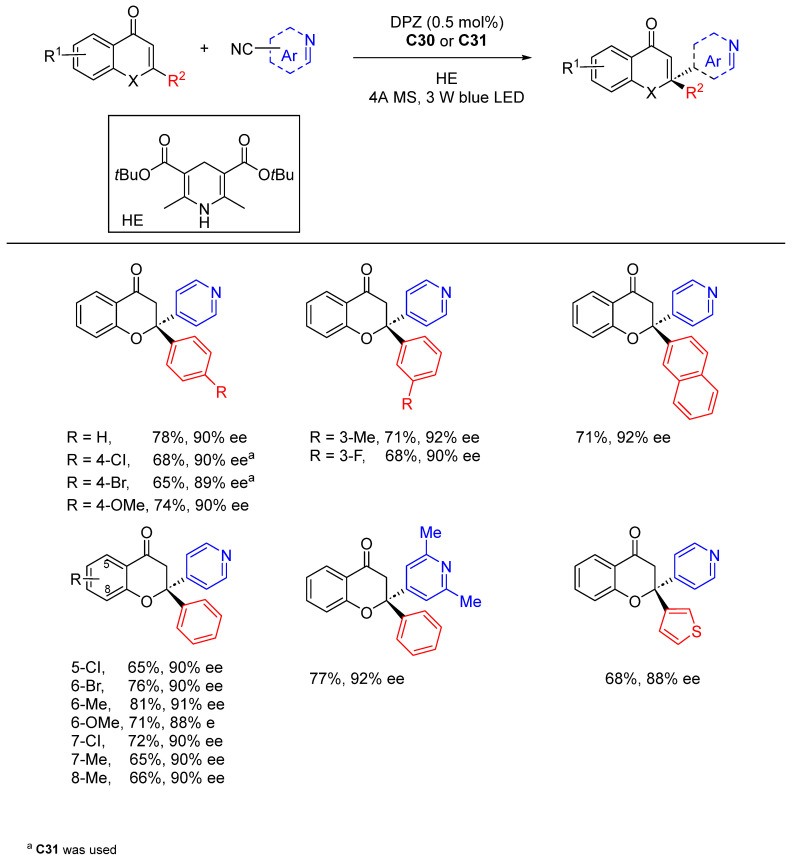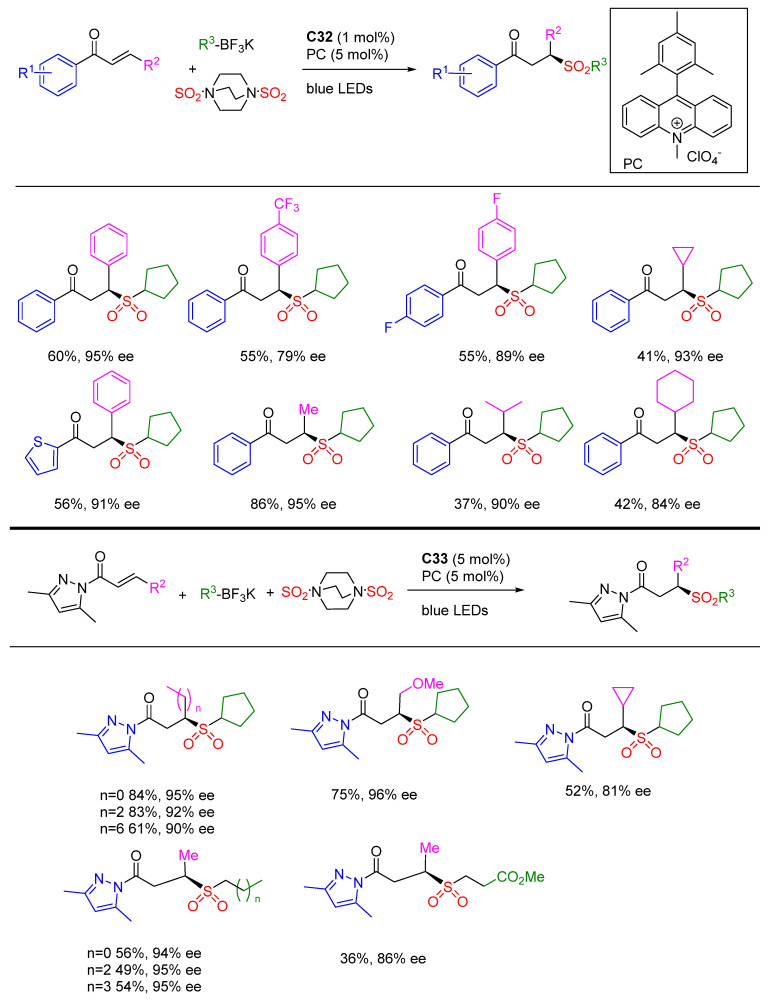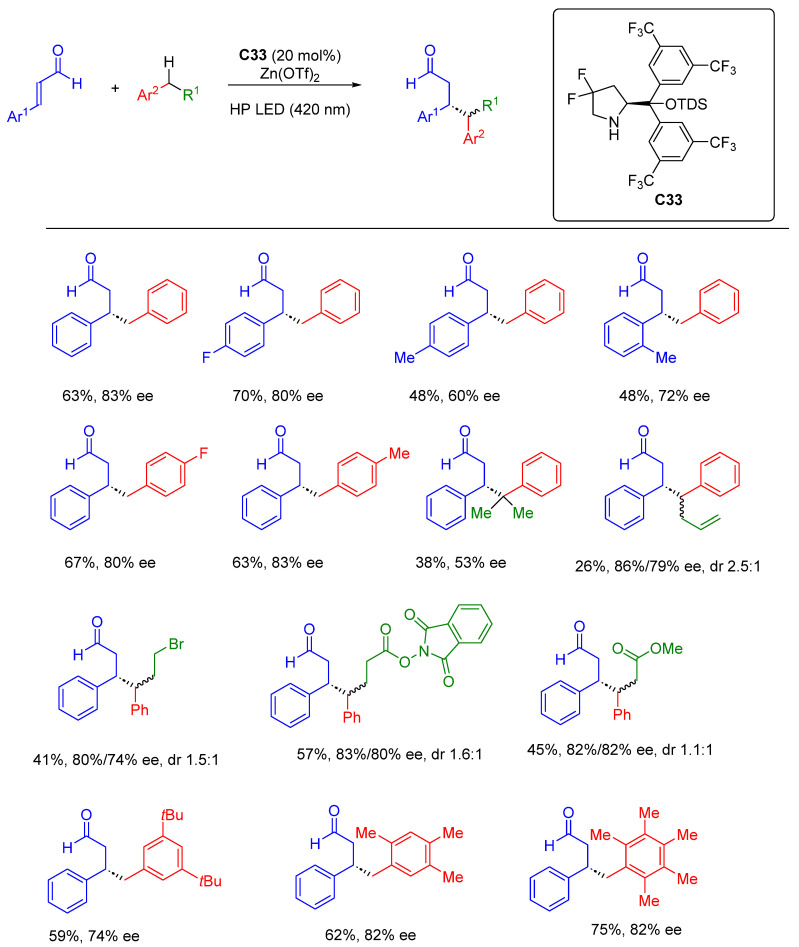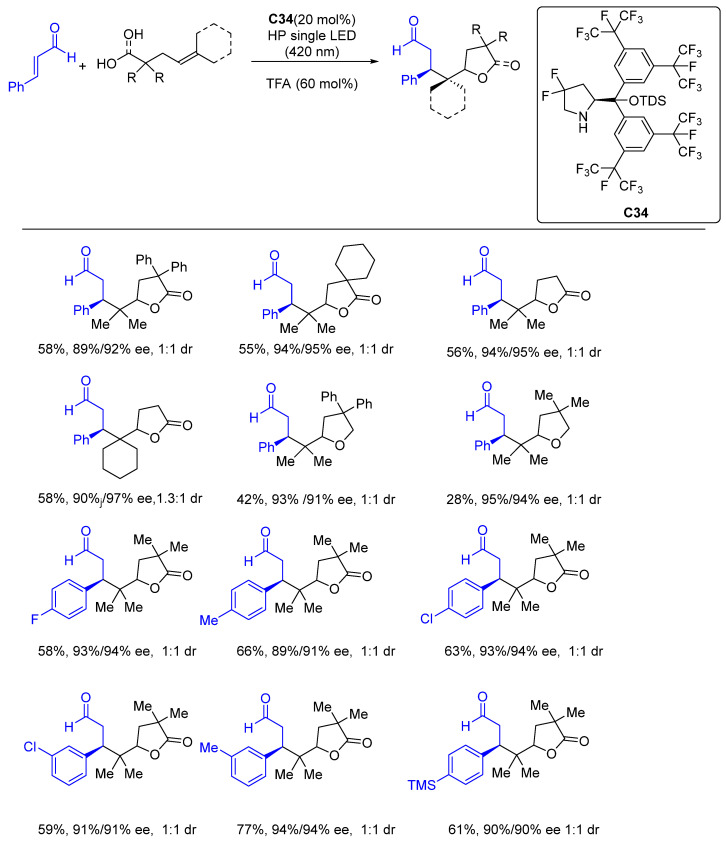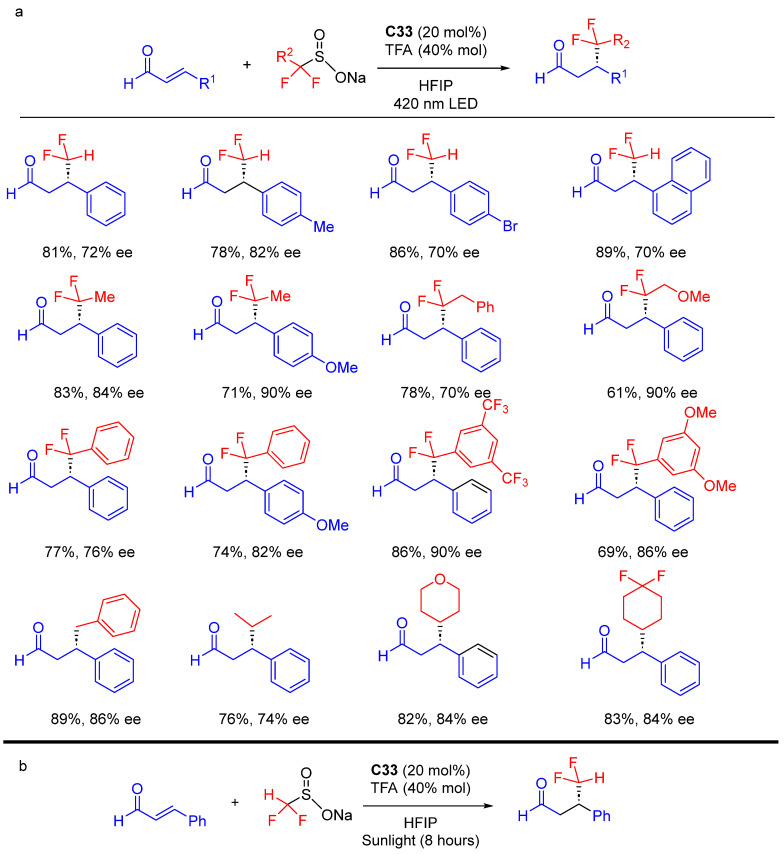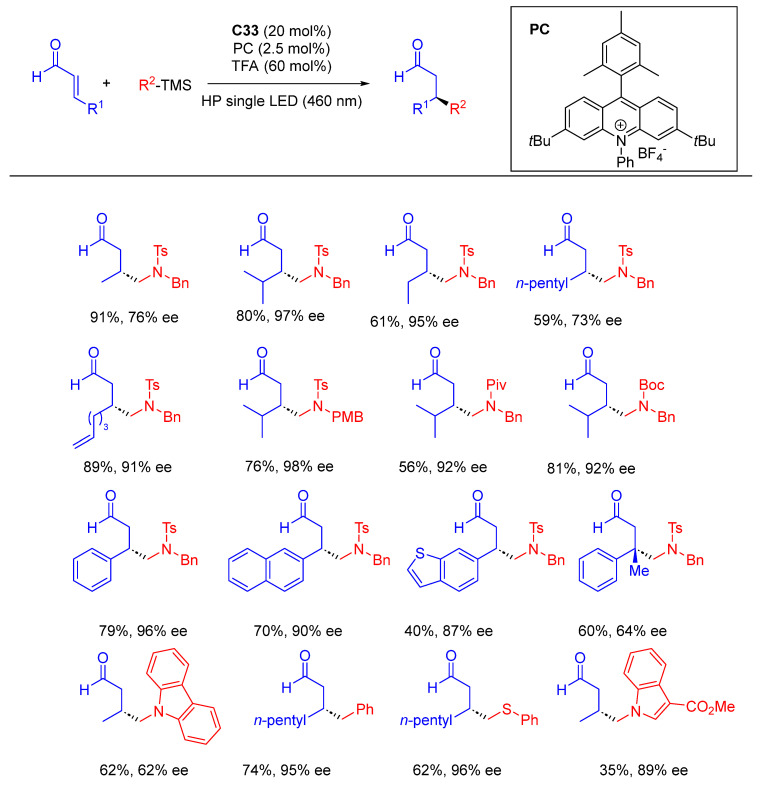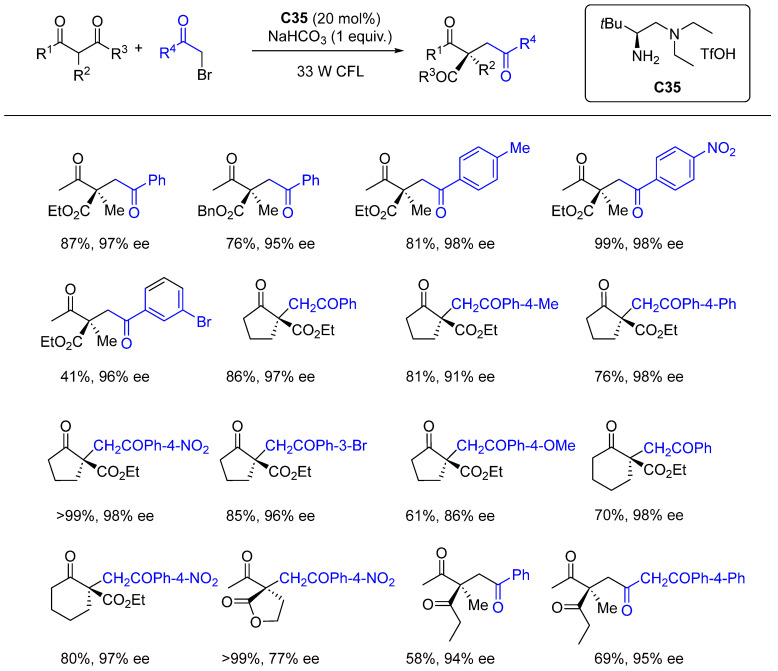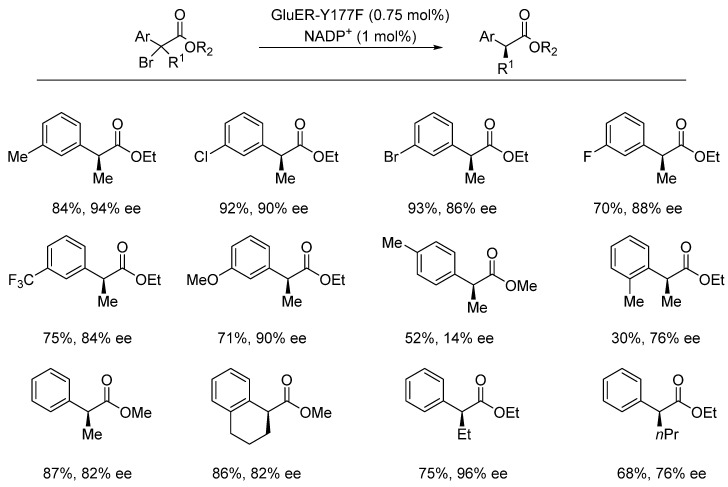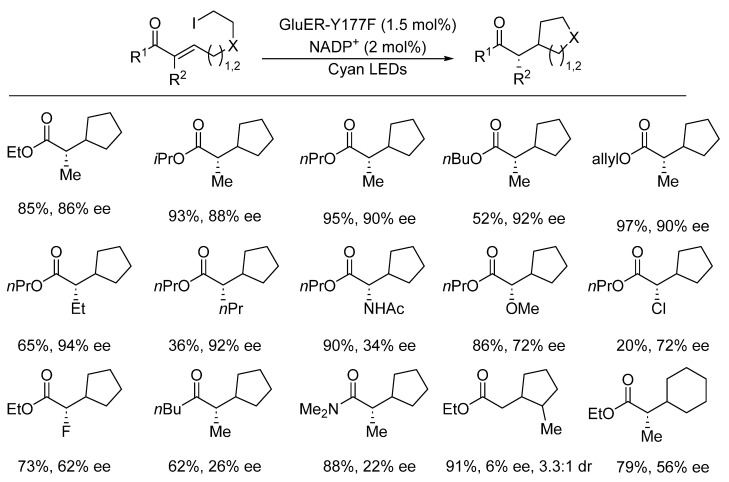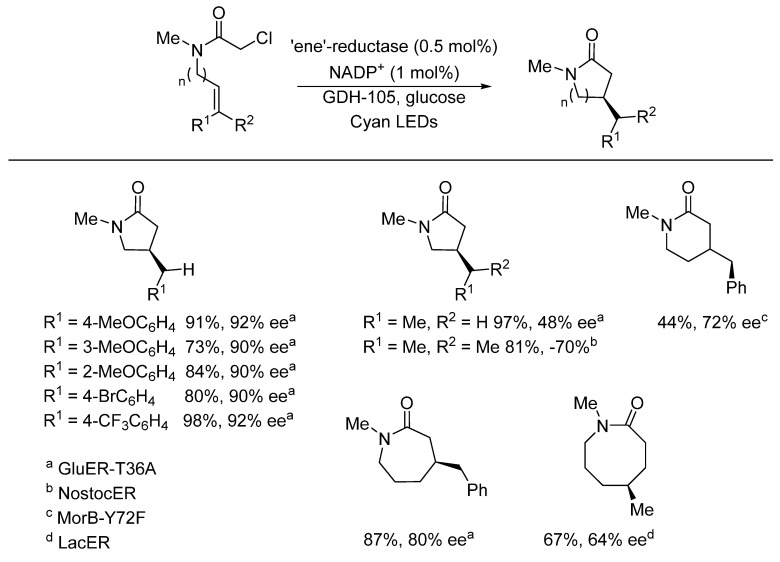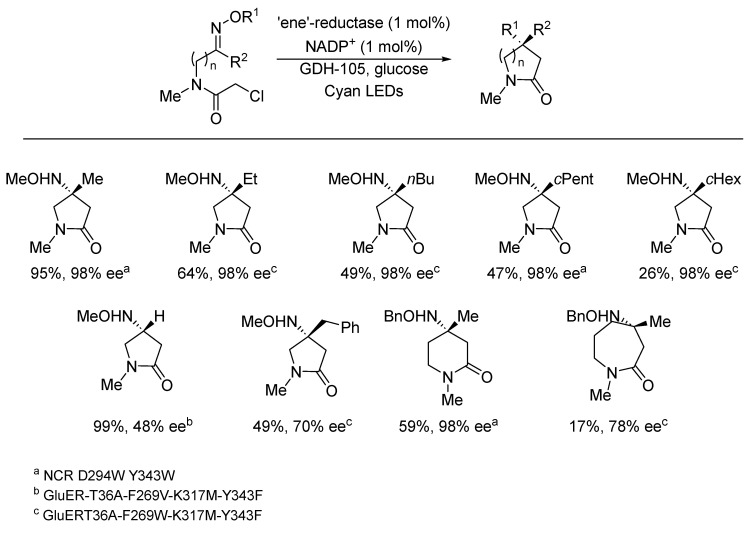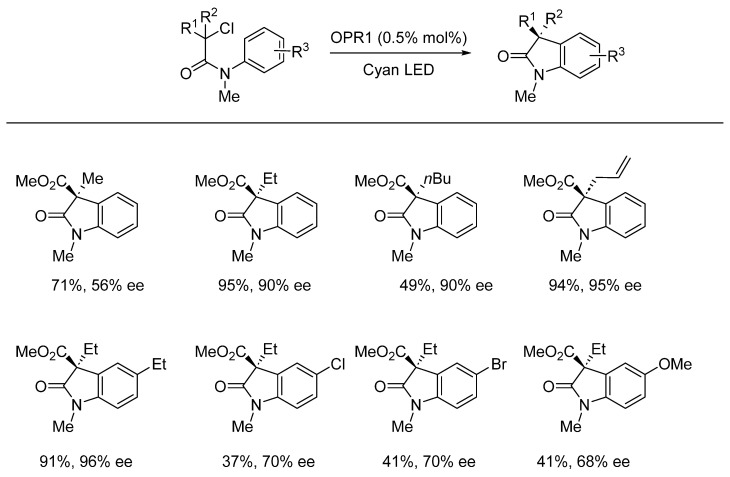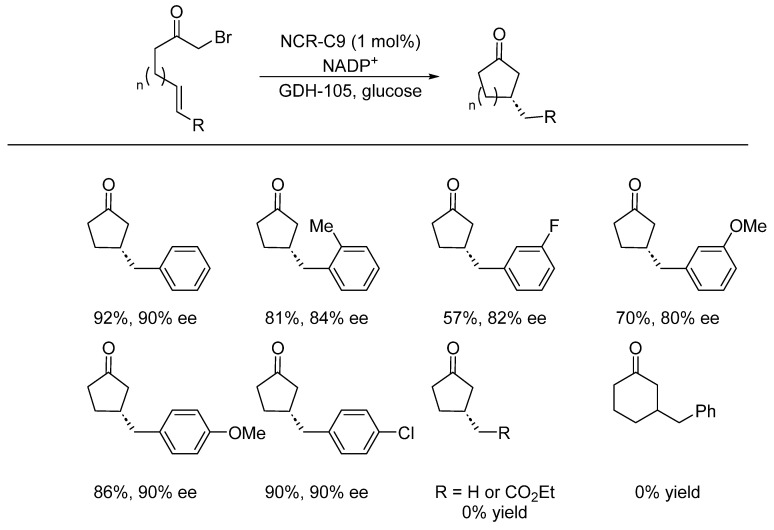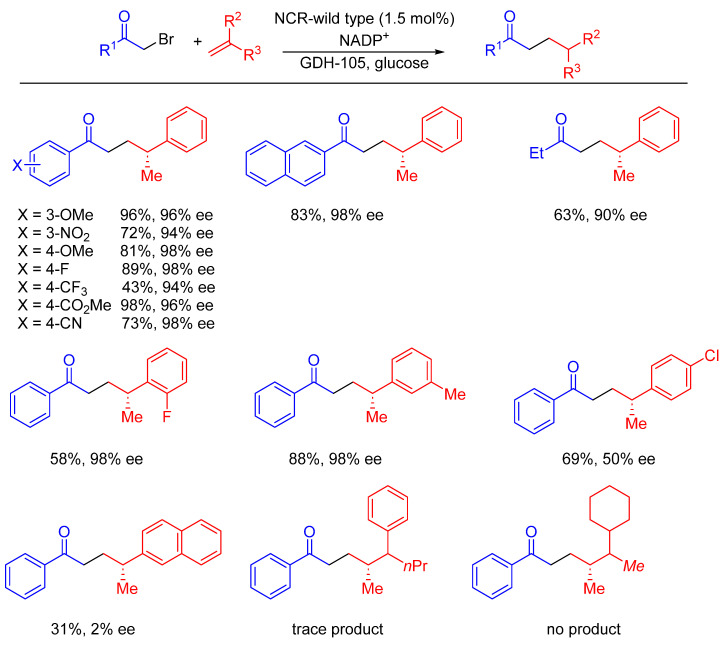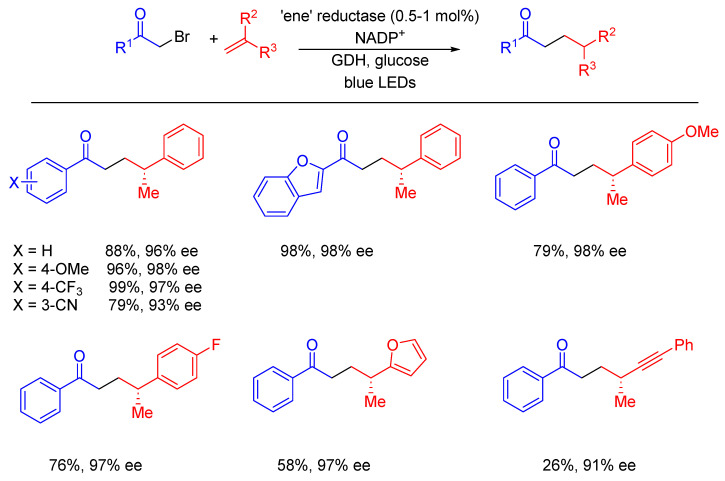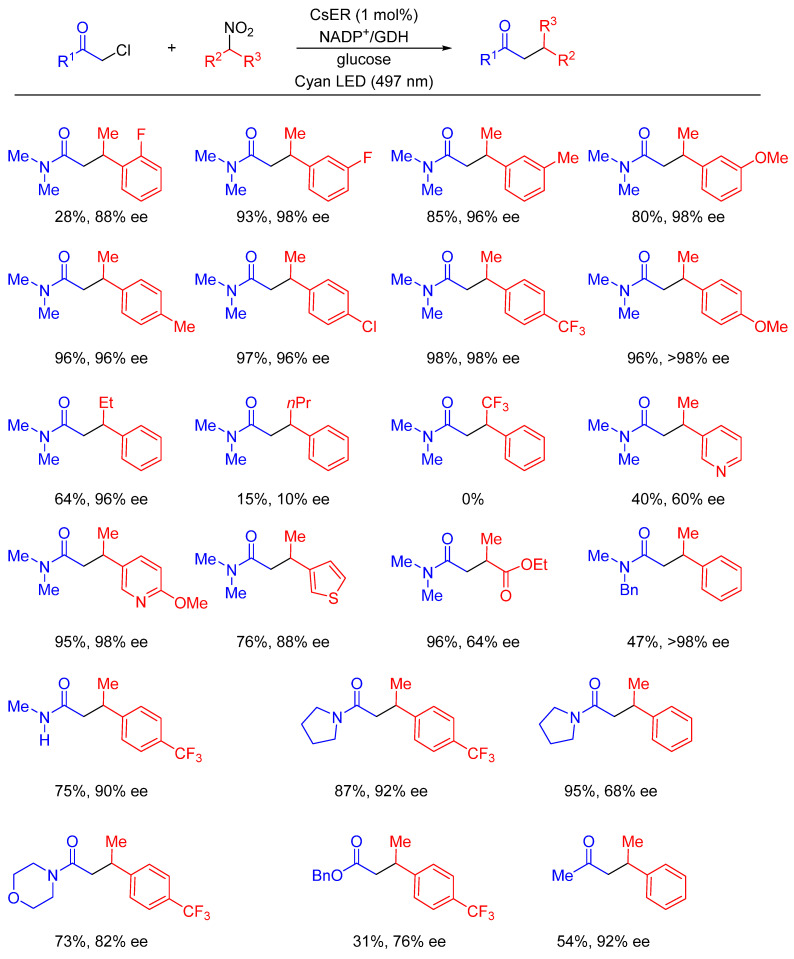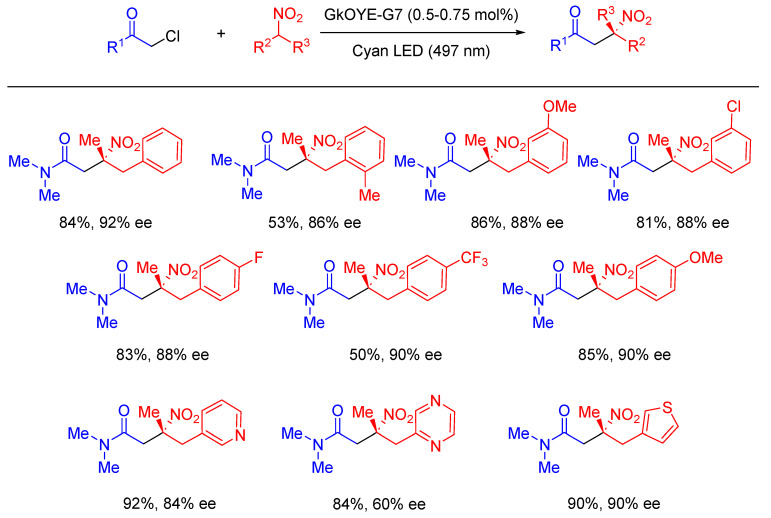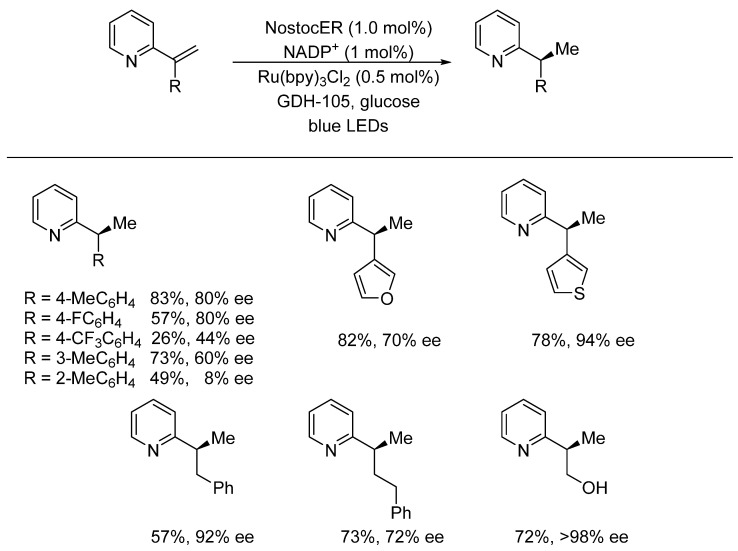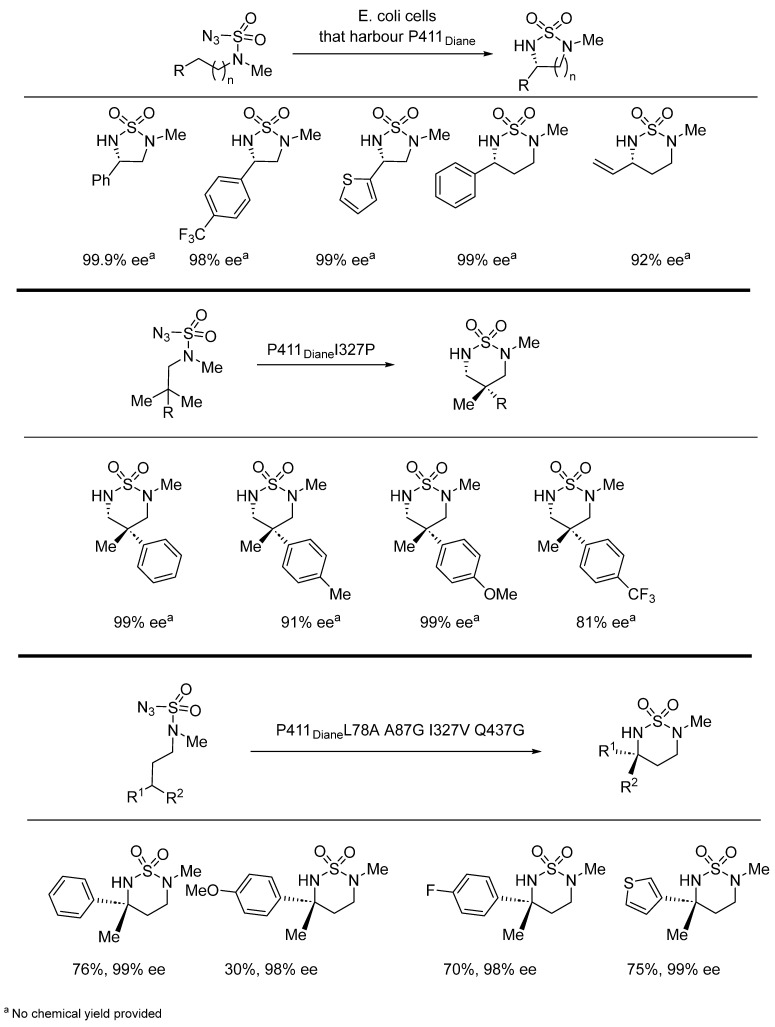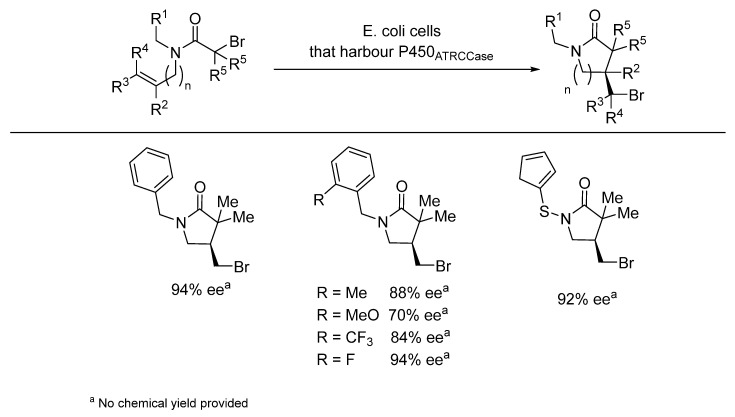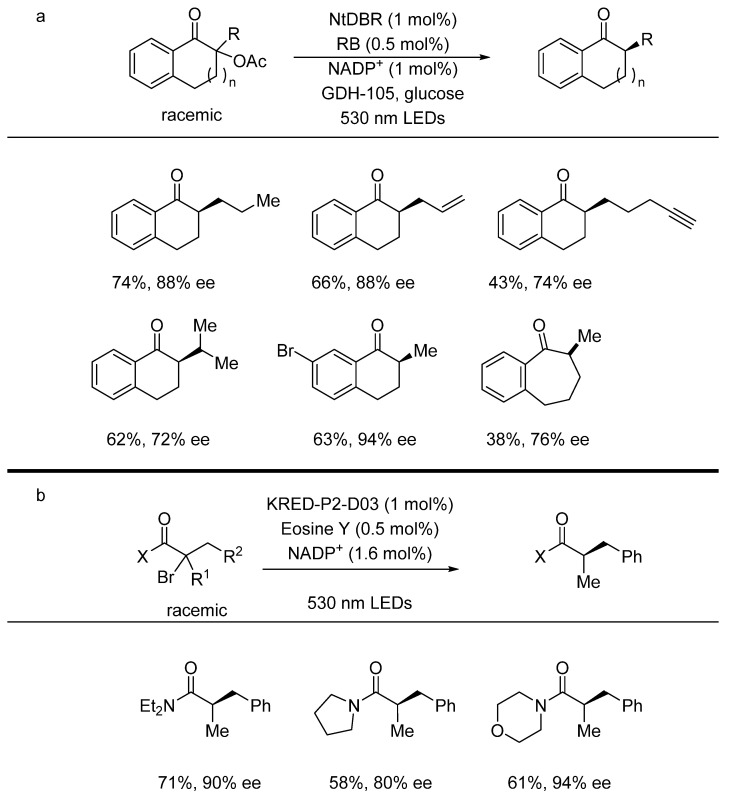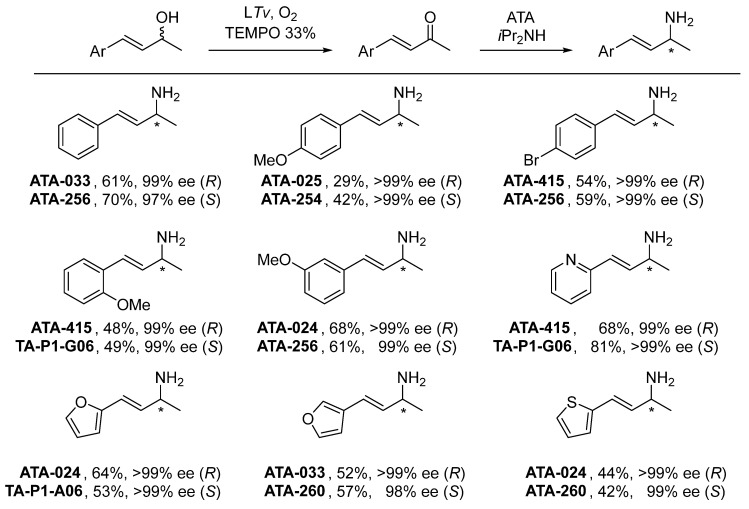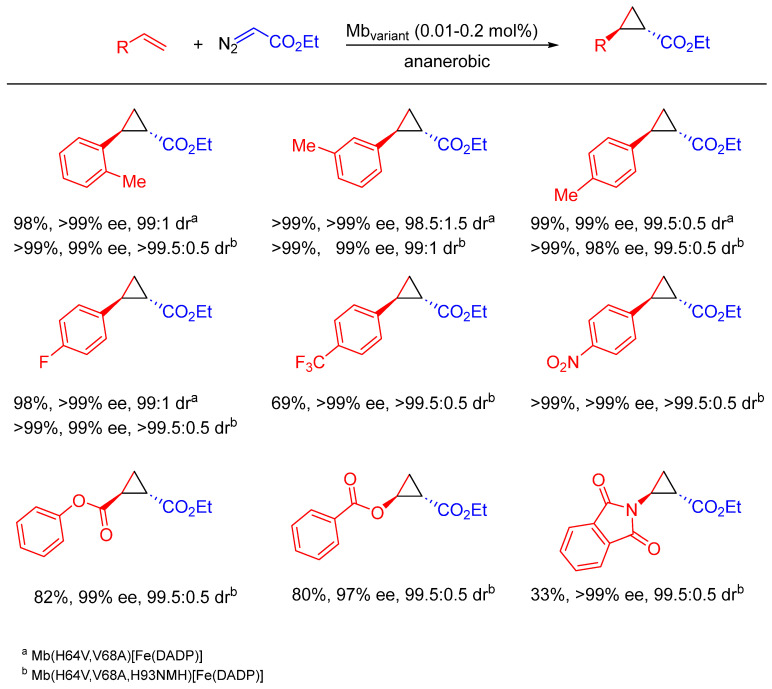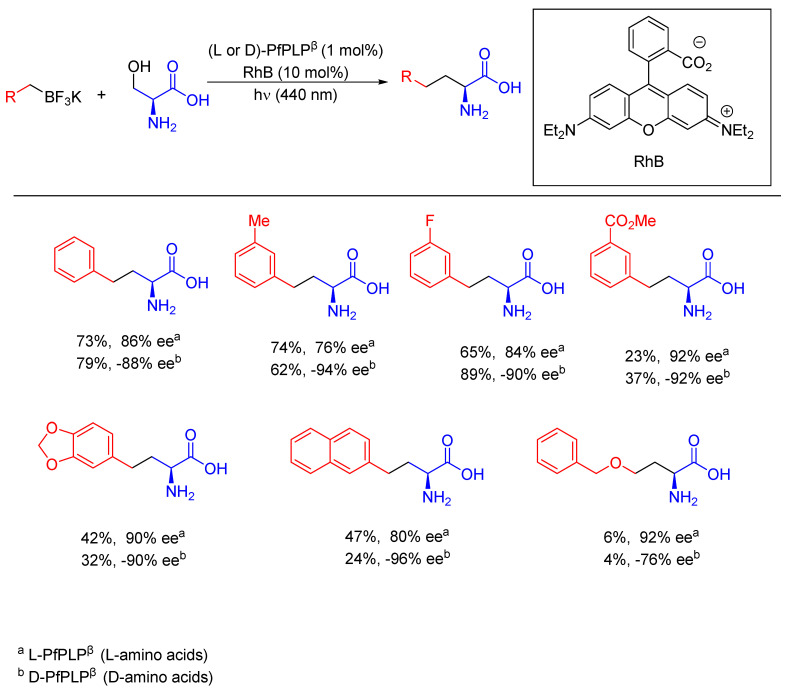Abstract
The review covers research published since 2017 and is focused on enantioselective synthesis using radical reactions. It describes recent approaches to the asymmetric synthesis of chiral molecules based on the application of the metal catalysis, dual metal and organocatalysis and finally, pure organocatalysis including enzyme catalysis. This review focuses on the synthetic aspects of the methodology and tries to show which compounds can be obtained in enantiomerically enriched forms.
Keywords: radical chemistry, enantioselective synthesis, transition metal catalysis, organocatalysis, enzymes
1. Introduction
Radical reactions are now well established as an excellent and one of the most powerful methods for the formation of the carbon–carbon and carbon–heteroatom bonds. Among them, photo-induced transformations are of great value and become very popular since new sources of the light—cheap and efficient LEDs—became available. The key challenge for the radical reaction is the controlling selectivity of the reaction. The highly reactive radical species can be involved in several unwanted side reactions. The problem becomes even more serious in the area of asymmetric synthesis. The synthetic chemist willing to perform radical reactions in a highly enantioselective manner has to not only to control the already mentioned side reactions, but also suppress non-enantioselective background reactions competing with the main process and leading to the formation of racemic products.
Until the late 1990s, the scientific community believed that radical species are too reactive and the control of the stereochemically defined processes is not possible. The pioneering work of Porter and Sibi [1,2] introducing chiral Lewis acids into radical reactions opened new avenues, and in last twenty years, we are seeing an enormous development in the methodology of enantioselective radical chemistry.
Several new methodologies were developed:
Transition metal catalysis—the catalyst not only creates chiral environment by coordination to a substrate, but also plays important role in the radical generation process;
Visible light photoredox radical reactions combined with transition metal catalysis;
Visible light photoredox radical reactions combined with organocatalysis including dual transition metal/organocatalytic processes.
Several excellent reviews have been published [3,4,5,6,7,8,9,10,11,12,13,14,15,16], many of them explaining the mechanistic aspects of the above-mentioned processes in great detail. In this review, we would like concentrate on the synthetic aspects of the methodology leading to enantiomerically enriched compounds. The most valuable and/or informative outcomes of the described reactions will be presented in the schemes. Recent papers published since 2017 are presented.
2. Transition Metal Catalysis
2.1. Copper-Catalyzed Enantioselective Radical Reactions
Liu’s group developed a concept of transition-metal-catalyzed reactions based on the copper complexes with privileged ligands—bisoxazolines, also known as box ligands. As the early part of asymmetric radical transformations developed by Liu and co-workers, they reported the novel copper-catalyzed intermolecular trifluoromethylarylation of styrenes, in which a variety of CF3-substituted 1,1-diarylalkanes could be efficiently synthesized [17]. Several box ligands have been tried and the best results were obtained for two of them, L1 and L2. The process is based on the formation of a benzylic radical-containing CF3 group in the cooperative action of the Togni-I reagent, which in the chiral environment of the Cu-box complex leads to an enantioenriched product. The trifluoromethyl group-containing compounds were obtained in good yields and very good enantioselectivities up to 93% ee (Scheme 1). However, the exact mechanism has not been investigated.
Scheme 1.
Trifluoromethylarylation of styrenes by enantioselective arylation of benzylic radicals.
In another paper, the group reported a copper-catalyzed enantioselective aminoarylation of styrenes with specially designed novel N-F reagent, N-fluoro-N-alkylsulfonamide (NFAS) as the amine reagent generating amino radical. Again, the complex L1/Cu(II)Ar was able to control the enantioselective arylation [18]. Several enantioenriched 2, 2 diarylamines were obtained with good yields and very good enantioselectivities, up to 94% ee (Scheme 2). These compounds are a valuable source of biologically active compounds such as dopamine receptors and some anticancer agents.
Scheme 2.
Synthesis of optically active 2, 2-diarylethylamines using N-F reagent and Cu/box complex.
Another very interesting method for the difunctionalization of styrenes led to the synthesis of β–amino and β-azidonitriles [19]. In this paper, authors presented an extension of the earlier published methodology: an enantioselective benzylic C-H cyanation, where the formation of a benzylic radical generated by a hydrogen atom transfer (HAT) in the assistance of a chiral bis(oxazoline)/copper cyanide complex leads to enantiomerically enriched benzyl nitriles [20]. The group also recently developed an enantioselective trifluoromethylcyanation reaction of styrene that is initiated by a CF3 radical-addition process [21]. Aminocyanation of several substituted styrenes proceeded with very-good-to-excellent enantioselectivities (Scheme 3).
Scheme 3.
Aminocyanation of styrenes.
The necessity of the sulfonyl group removal under harsh conditions was the major drawback of this approach. Therefore, the authors decided to modify the reaction conditions to introduce an azido group instead of a disulfonyl imino one. In this case, the best results were obtained for indabox L4, and also this reaction proceeded with very-good-to-excellent enantioselectivities (Scheme 4). Both electron-donating and electron-withdrawing substituents provided the same level of enantioselectivity, while the pattern of the substitution was important to some extent, ortho-substituted substrates delivered the best stereoselectivity. The reaction was not compatible with heteroaromatics, and pyridine derivative was obtained with only moderate ee.
Scheme 4.
Azidocyanation of styrenes.
Liu’s group has developed a new method for the asymmetric phosphinocyanation of styrenes based on the proton-coupled electron transfer (PCET). Chiral organophosphines are among most popular ligands used in asymmetric synthesis; therefore, new methods for their synthesis are of great value. In this paper, the authors present the synthesis of the phosphine precursors, a phosphine oxides. The best results were obtained for the reaction catalyzed by the copper complex of the ligand from the indabox family—dibenzyl derivative L5 [22]. The addition proceeded with both excellent yield and enantioselectivity, and was almost insensitive to the substitution pattern of the starting styrenes (Scheme 5).
Scheme 5.
Asymmetric phosphinocyanation of styrenes.
The methodologies developed by Liu’s group for the difunctionalization of styrenes’ double bond was further extended to more complicated substrates—enamides and vinyl esters [23]. The radical formed on the central carbon of the unsaturated part of the substrate interacts with the copper complex of indabox ligand. The reaction shows high compatibility with various functional groups and proceeds with good yield and very-good-to-excellent selectivities. The reaction is quite flexible and TMSCN can be used to provide trifluoromethylcyanation of enamides and vinyl esters with ligand L6 (Scheme 6), or the use of alcohol as reagent gave products of trifluoromethyloxygenation with ligand L7 (Scheme 7).
Scheme 6.
Trifluoromethylocyanation of enamides (a) and vinyl esters (b).
Scheme 7.
Trifluoromethyloxygenation of enamides.
The major drawback of this approach seems to be necessity of the introduction of a trifluoromethyl group into each product, which narrows the usability of these compounds.
Under the same conditions which were used for the trifluoromethylocyanation of enamides (see Scheme 6), there was the trifluoromethylocyanation of β,γ-unsaturated carbonyl compounds—ketones, esters and amides [24]. In this case, best results were achieved for a box ligand L8 and the products were obtained with good yields and enantioselectivities in a range of 70–91% ee (Scheme 8).
Scheme 8.
Trifluoromethylocyanation of β,γ-unsaturated carbonyl compounds.
Azidation of acrylamides led to broad range of azides bearing various haloalkyl groups and the best ee’s, up to 90%, were observed for anionic box ligand L9 [25]. The reactions proceed with good yields and are very tolerant to the various substituents of the double bond and amide’s nitrogen (Scheme 9). Several sulfonyl chlorides, including the range of halosulfonyl chlorides were used as radical precursors with good results; however, simple alkyl sulfonyl chlorides like mesyl chloride failed to react, probably because they were unable to initiate the single-electron-transfer process.
Scheme 9.
Azidation of acrylamides.
The elegant three-component reaction of azoles catalyzed via the copper–bisoxazoline complex was presented by Zhang and Ma [26]. The reactions of various benzoxazoles, styrenes and tertiary bromides or diaryliodonium salts proceeded smoothly with good yields and good-to-very-good enantioselectivities in the presence of carbazol-derived bisoxazoline L10. The reactions and some selected examples of the products are presented in Scheme 10.
Scheme 10.
Azolation of alkenes.
Another three-component reaction was presented by Wang et al. Intermolecular alkene vicinal dicarbofunctionalization (DCF) is fundamental transformations of alkenes, which allows for the installation of two different carbon fragments. While the ionic version of this reaction is well known, the radical-mediated enantioselective version remained largely unexplored. The author reported a catalytic asymmetric three-component radical vicinal DCF reaction of alkenes with oximes and TMSCN, which provide a general approach of valuable optically active α-cyano ketones and alkyldinitriles [27]. Box ligand ent-L4 provided the highest enantioselectivities in the range 82–93% ee, usually around 90%. The substitution pattern of the tested aryl moieties only slightly influenced the stereoselectivity of the reaction (Scheme 11).
Scheme 11.
Vicinal alkene difunctionalization.
The privileged ligands, bisoxazolines, were broadly used not only for the functionalization of alkenes, but also in several other asymmetric reactions.
The ligand L4 was used in novel process combining photoredox catalysis with asymmetric copper catalysis [28]. The enantioselective decarboxylative cyanation allowed for the synthesis of the broad spectrum of aryl-substituted alkyl nitriles with high yields and with very good and, in some cases, excellent enantioselectivities (Scheme 12). These compounds can be important substrates in organic synthesis and are easily converted into valuable precursors for the synthesis of several important pharmaceuticals.
Scheme 12.
Decarboxylative cyanation.
Han and co-workers reported novel method for the synthesis of chiral sulfonyl lactones bearing a quaternary stereogenic center based on the copper-catalyzed multi-component reaction of ω-unsaturated carboxylic acids [29]. Lactones were obtained with good yields and moderate selectivities in the presence of classical bu-box ligand L11 (Scheme 13). However, only three types and five box ligands in total of were taken to the screening procedures; therefore, there is still some room for improvement.
Scheme 13.
Synthesis of chiral sulfonyl lactones.
Gong and co-workers reported a highly efficient method for the enantioselective alkylation of imines based on the photoredox/bifunctional Cu(II)/box catalyst [30]. The alkylation of both sulfonyl imines and isatin-derived ketimines proceeded with very-good-to-excellent enantioselectivities, up to 98% ee; however, results were highly dependent on the ligand structure. Several ligands were tested and the best results were obtained using L12a for sulfonylimines and ent-L5 for ketimines (Scheme 14).
Scheme 14.
Alkylation of imines and isatin-derived ketimines.
The researchers put in a lot of effort to elucidate the mechanism of the reaction. They probed, inter alia, the radical pathway, investigated UV-VIS spectra and performed cyclovoltametric experiments. The proposed mechanism is presented in Figure 1.
Figure 1.
A plausible mechanism for the alkylation of imines and isatin-derived ketimines.
Copper-box complexes were applied to several reactions other than the fuctionalization of the double-bond.
Liu et al. reported the benzylic arylation of C(sp3)-H bonds in the radical relay process [31]. They showed the importance of the thorough survey of chiral ligands used in this type of the reaction. The structure of the bisoxazolines influences not only the enantioselectivity, but can also increase the reactivity, improve the yield and suppress side reactions. After testing 10 ligands, it was found that the best stereoselectivity and highest yields with only trace amounts of the side products can be obtained in the presence of bisoxazoline L13. The reaction is compatible with both electron-donating and electron-withdrawing groups and several functional groups (Scheme 15).
Scheme 15.
Enantioselective C-H arylation.
The first catalytic asymmetric cyanation of propargylic esters was described by Lan, Xiao and co-workers [32].
They used photoredox catalysis and asymmetric catalysis based on copper complexes of bisoxazoline ent-L4. The reaction proceeded with good-to-very-good chemical yields and very-good-to-excellent enantioselectivity (Scheme 16). The structure and electronic properties only slightly influenced the outcome of the reaction. Moreover, both photocatalyst (Ph-PTZ, 10-phenyl-10H-phenothiazine) and leaving group 3,5-(ditrifluoromethyl)benzoic acid could be recovered with very good yields.
Scheme 16.
Catalytic asymmetric cyanation of propargyl esters.
Yang et al. described highly enantioselective cyclopropyl ring opening of arylcyclopropanes with trimethylsilyl cyanide [33]. The resulting γ-aminonitriles were obtained with good-to-excellent yields and enantioselectivities (Scheme 17).
Scheme 17.
Enantioselective cyclopropyl ring opening.
Products of this reaction can be further converted into diamines or γ-amino amides (Scheme 18); however, the major drawback of this methodology seems to be the harsh conditions for the removal of the sulfonamide protection of the terminal amino group.
Scheme 18.
Reactions of γ-aminonitriles.
Copper-catalyzed aerobic enantioselective carboamination and carboetherication of alkenes has been reported by Wdowik et al. [34]. Instead of the usually used MnO2 or hypervalent iodine reagents for that type of transformation, the authors applied environmentally friendly 10% oxygen (O2) in nitrogen as oxidant. Very good results, with ee’s up to 97% ee, were obtained for the carboamination, slightly worse for the carboetherication. The latter reaction gave good results only for sterically demanding tertiary alcohols (Scheme 19). Spirocyclic ethers were also obtained using this methodology, but with low-to-moderate yields.
Scheme 19.
Carboamination and carboetherication of alkenes.
Enantioselective carboesterification of dienes with diacyl peroxides leading to chiral acylated α,β-unsaturated alcohols was reported by Zhu et al. [35]. The reaction is catalyzed by a bisoxazoline. Several ligands were checked in order to find the best one for this specific addition, and the best results were obtained for the pybox L17; the enantioselectivities were generally in the range 80–90% ee with moderate-to-good yields (Scheme 20).
Scheme 20.
Enantioselective carboesterification of dienes with diacyl peroxides.
Better enantioselectivities, usually over 90% ee, were observed for the disubstituted dienes; however, the bulkier pybox ligand L18 had to be used. Moreover, the reaction was fully regioselective for 1,2-diaryl dienes (Scheme 21).
Scheme 21.
Enantioselective carboesterification of 1,2-disubstituted dienes with diacyl peroxides.
The products of this reaction can be useful starting material for further transformations, as was shown by the RCM reaction in Scheme 22.
Scheme 22.
Ring-closing metathesis leading to 10-membered ring.
The mechanism studied under radical clock reaction, radical trap experiment, crossover reaction with two different peroxides, crystallography of two single crystals of dimer copper-dimer ligand complex, and MS studies of copper complex resulted in the plausible mechanism below in Figure 2.
Figure 2.
A proposed mechanism for the carboesterification of dienes.
The asymmetric Cu-catalyzed [4+1] spiroannulation reaction has been reported by Bai et al. [36]. Dearomatization/dehalogenation of α-bromo-β-naphtols produced pyrazoline-based frameworks with moderate-to-excellent enantioselectivity (Scheme 23).
Scheme 23.
Dearomatization/dehalogenations of β-naphtols.
A very interesting approach to the enantioselective difunctionalization of alkenes using dual photoredox and copper catalysis was developed by Lu and co-workers [37]. They found that the generation of either an O-centered aroyloxy radical or an N-centered phtalimidyl radical from N-(aroyloxy)-phtalimides (ArCO2NPhth) depends on the ratio of the ligand to the copper catalyst. The photocatalyst generates an O-centered aroyloxy radical in the presence of excess copper and N-centered phtalimidyl radical when the ligand predominates over copper. Several box ligands have been investigated and the best results were obtained for the new serine-derived, (-)-menthol substituted ligand L19. The reaction proceeded with good yields and very-good-to-excellent enantioselectivities, albeit with some important exceptions. Representative examples are presented in Scheme 24.
Scheme 24.
Chemodivergent asymmetric aminocyanation and oxocyanation of alkenes.
The very interesting approach to oxocyanation was presented by Chen et al. [38]. The nitrile group is formed by a ring-opening of cycloalkenone’s acylated oxime with the simultaneous C-O cross-coupling with 1-Ar-substituted 1,3-dienes leading to chiral allylic esters bearing terminal CN moiety. In the presence of the simple box ligand L20, the reaction proceeds with high regioselectivity, very good yields and very-good-to-excellent enantioselectivities (Scheme 25).
Scheme 25.
C-O cross-coupling.
Mechanistic studies involving both experiments and DFT calculations led to the proposition of the plausible mechanism (Figure 3).
Figure 3.
Mechanism of C-O cross-coupling.
A modified version of that research, using Boc protected oximes and carboxylic acids as the third component, was simultaneously published by Chen’s group (Scheme 26) [39].
Scheme 26.
Three-component C-O cross-coupling.
The atom transfer radical addition approach was successful for arylalkenes, albeit optimization of the reaction required thorough studies on the bisoxazoline structure. Finally, L21 was shown to give the best results for various carboxylic acids and alkenes with good-to-excellent enantioselectivities, as shown in Scheme 27 and Scheme 28 [40].
Scheme 27.
C-O coupling of 2-vinylnaphtalenes.
Scheme 28.
C-O coupling of various oxime esters and (hetero)arenes.
Under those conditions the functionalization of alkenes using peroxides as a radical precursor provided highly enantioenriched products (Scheme 29).
Scheme 29.
C-O coupling of carboxylic acids and styrenes.
The method for the synthesis of imidazolidines catalyzed by copper complex with bisoxazoline L22 was developed by Dai et al. [41]. The combination of copper catalysis and visible-light-induced photocatalysis in the presence of photosensitizer 4CzIPN allowed for the synthesis of imidazolidinones with very good yields and enantioselectivities. This approach is quite flexible, and when the three-component reaction leads to the synthesis of imidazolidines, the same reaction in the absence of formaldehyde gives vicinal diamines with comparable yields and selectivities (Scheme 30).
Scheme 30.
Synthesis of imidazolidines catalyzed by copper complex of L22.
The synthesis of 3-aminoindolines (compounds with potential antitumor activity) based on the Cu-catalyzed enantioselective cyclization of ethynyl benzoxazinones with amines using simple pybox ligand L23 (or its enantiomer) was reported [42]. The reactions proceeded smoothly to give 3-aminoindolines. The model reactions were performed mainly with 9H-fluoren-9-amine, but also with some other aromatic amines and a broad spectrum of sulfonamides, as well as alkyl substituents, providing 3-aminoindolines in very good yields and enantioselectivities (Scheme 31a).
Scheme 31.
The synthesis of 3-aminoindolines and their sulfonyl derivatives.
The attempt to introduce a trifluoromethyl group to terminal alkene carbon using Togni’s reagent led unexpectedly to sulfonyl migration with good yields (Scheme 31b).
Synthesis of chiral 1,1-diarylalkanes in radical relay coupling reactions was presented by Maruoka and co-workers [43]. In order to achieve an acceptable level of enantiodiscrimination in this three-component coupling of alkylsilyl peroxides, vinylarenes, and arylboronic acids, series of a new type of hybrid binaphtol-box ligands, were designed and the best results were obtained for the ligand L24 (Scheme 32); however, mostly moderate-to-good enantioselectivities were observed.
Scheme 32.
Synthesis of chiral 1,1-diarylalkanes.
Enantioselective α-C(sp3)-H-alkynylation of cyclic, unactivated amines were successfully performed yielding chiral propargylic amines with enantioselectivities over 80% ee, and in some case over 90% ee [44]. This level of enantiodiscrimination was achieved after thorough studies on the box ligand structure–ee relationship, and after the important discovery that BINOL is an indispensable element of the system. In the Maruoka’s studies (vide supra) binaphtol had to be a part of the ligand. Herein, only the presence of the optically pure BINOL as additive to a ligand L25 was sufficient to highly improve chemical yield and, to some extent, the enantioselectivity (Scheme 33).
Scheme 33.
Alkynylation of cyclic, unactivated amines.
In the same publication, authors perform diastereoselective additions to d- and l-proline and report mismatched interactions between chiral substrate and chiral catalyst; however, no investigation into which elements in this three-molecule (substrate-BOPA ligand L25-(R)-BINOL) system are responsible for that effect were conducted.
Under the same conditions, but in the presence of ligand L26, benzo-fused amines were also alkynylated with very good enantioselectivities up to 88% ee.
The mechanism was comprehensively studied with (a) a control experiment of possible intermediates, (b) reduction potential of substrates and different complexes, (c) Stern-Volmer plots, (d) deuterium-labeling and KIE experiments, (e) TEMPO trapping experiment, (f) stereocontrol effect of BINOL, and (g) SAESI-MS of possible intermediates, which resulted in the plausible mechanism presented below (Figure 4).
Figure 4.
Mechanism of amine alkynylation.
Other interesting ligands used in enantioselective reactions are phosphino-oxazolines (PHOX ligands). These well-known ligands, which proved their efficacy in several types of enantioselective processes were recently applied for copper-catalyzed radical reactions. Liu et al. successfully used them in the radical oxidative C(sp3)-C(sp) cross-coupling of C-H bonds with alkynes [45].
We should consider it as a rule, that for the given enantioselective reaction, the structure of the ligand has to be fitted to the reagents in order to provide the best asymmetric induction. So, tedious studies including several ligands of different structure and mode of action have to be performed in most cases. Authors found that highest ee’s for C-H functionalization of benzylic position as well as of the allylic position in cyclic alkenes is secured by the use of ligand L27 in the presence of N-fluorosulfonamide as an oxidant (Scheme 34 and Scheme 35b), while L28 is the best one for acyclic alkenes (Scheme 35a).
Scheme 34.
Oxidative C(sp3)-C(sp) cross-coupling of C-H bonds with alkynes.
Scheme 35.
Oxidative C(sp3)-C(sp) cross-coupling of C-H bonds with alkynes.
A different approach to the installation of an alkynyl moiety in the benzylic position was proposed by Zhang’s group [46]. They performed alkynylation of various benzylic bromides (Scheme 36a), including α-silyl bromides (Scheme 36b), and achieved very good yields and enantioselectivities, in a few cases as high as 96% ee in the presence of two novel PHOX ligands, L29 and L30.
Scheme 36.
Alkynylation of benzylic bromides.
Cinchona alkaloid derivatives, extremely popular in organocatalysis, and to a lesser extent in transition metal catalysis and organometallic chemistry, were used as ligands for radical reactions.
Li et al. developed an asymmetric radical oxytrifluoromethylation of oximes. They have checked several cinchona derivatives for efficient copper catalysis and found, that in the presence of the cinchonine sulfonamide L31/copper complex, CF3-containing isooxazolines bearing α-tertiary stereocenters were obtained with good-to-excellent yield and enantioselectivity [47]. Selected results are presented in Scheme 37.
Scheme 37.
Asymmetric radical oxytrifluoromethylation of oximes.
New chiral ligands based on the modified cinchona alkaloids were developed by Dixon’s group [48] and later were successfully (after some modifications) used by Liu’s group; their common feature was the presence of triaryl phosphine moiety, thus taking advantage of the Cu-P soft–soft interactions. The three most efficient ones are presented in Figure 5.
Figure 5.
Cinchona alkaloid ligands.
Liu and co-workers reported the enantioconvergent Sonogashira C(sp3)-C(sp) cross-coupling of alkynes with racemic alkyl bromides using a copper complex of a cinchona alkaloid-based P,N-ligand L32a [49]. Several ligands from various classes, as phosphoramidites, BOX and PHOX ligands, axially chiral phosphines and cinchona alkaloid derivatives were tried, and the best results were obtained for L32a. This system appeared to be relatively insensitive to the substituents of the reaction partners and tolerant of various functional groups; very good yields and very-good-to-excellent enantioselectivities were reported (Scheme 38).
Scheme 38.
Sonogashira C(sp3)-C(sp) cross-coupling of alkynes with racemic alkyl bromides.
Liu’s group used ligand L32a in another alkynylation reaction, namely enantioselective 1,2-carboalkynylation of alkenes [50]. The reaction proceeded very well for a variety of terminal alkenes, alkynes as well as several alkyl halides, and high chemical yields and enantioselectivities were obtained (Scheme 39).
Scheme 39.
1,2-Carboalkynylation of alkenes.
The comprehensive mechanism was studied by control experiments, radical clock and radical quenching experiments, NMR studies of L32a-Cu complex, cyclic voltammograms to investigate the redox potential of Cu(I) catalyst, and EPR experiments to support the involvement of a Cu(II) species, and lastly the kinetic analysis. On that basis, a plausible mechanism was proposed (Figure 6).
Figure 6.
Mechanism of 1,2-carboalkynylation of alkenes.
The alkynylation of racemic secondary halides (see Scheme 38) has some major drawbacks as tedious synthesis and, often, low stability of the substrates occur. As a remedy, Liu’s group developed the method for the decarboxylative alkynylation of N-hydroxyphthalimide esters of racemic alkyl carboxylic acids [51]. The photoinduced radical reaction catalyzed again by L32a/copper complex proceeded with good yields and excellent enantioselectivities for a broad range of terminal alkynes and alkyl carboxylic acids (Scheme 40).
Scheme 40.
Decarboxylative alkynylation of N-hydroxyphthalimide esters.
The catalytical system L32b/copper complex (modification of the phosphine moiety was required in order to achieve best results) was applied to the alkylation of azoles leading to pharmaceutically important α-chiral alkylated azoles [52]. The enantioconvergent coupling of alkyl halides with azole C(sp2)-H bonds proceeds under mild conditions yielding products with moderate-to-good yields and good-to-very-good enantioselectivities. This method not only provides an excellent complementary approach to the previous reported enantioselective heteroarene C(sp2)-H alkylation, but also an immediate access to enantioenriched α-chiral alkylated azoles for potential drug discovery (Scheme 41).
Scheme 41.
The enantioconvergent coupling of alkyl halides with azoles.
On the basis of the previous results, Liu’s group proposed a similar strategy, which might also be suitable for enantiocontrol over the sp-hybridized allenyl radicals, thus allowing for the construction of tetrasubstituted chiral allenes [53]. They described the development of a copper-catalyzed three-component asymmetric radical 1,4-carboalkynylation of 1,3-enynes in the presence of the cinchona alkaloid-derived ligand L32c, providing straightforward access to diverse tetrasubstituted chiral allenes with moderate-to-good chemical yields and very good enantioselectivities (Scheme 42).
Scheme 42.
1,4-Carboalkynylation of 1,3-enynes.
Photoinduced transition metal catalysis differs from photoredox catalysis, in which metal plays a dual role as a photoabsorbent and a center for chemical bond cleavage, offering simplicity of reaction system and cost-effectiveness by avoiding the external photoredox catalyst. The mechanism consists of intermolecular photoinduced single-electron transfer (SET) between the catalytic metal complex and the substrate, followed by homolytic bond dissociation resulting in a highly reactive radical of substrate, which then recombines to the metal. Ueda et al. reported copper-catalyzed highly enantioselective umpolung acylation of γ-monosubstituted or γ,γ-disubstituted primary allylic phosphates with acyl silanes; the visible-light irradiation with a blue LED lamp led to the formation of α-branched β,γ-unsaturated ketones [54]. In the presence of chiral NHC ligand L33, the reaction proceeded with good yields and good-to-very-good enantioselectivities (Scheme 43).
Scheme 43.
Umpolung acylation of primary allylic phosphates with acyl silanes.
2.2. Nickel-Catalyzed Enantioselective Radical Reactions
Chiral nickel complexes were recently found to be very useful tools in radical-based asymmetric synthesis. Again, most of the valuable results obtained in recent years were obtained in the presence of oxazolines or bisoxazolines as chiral ligands (vide infra).
Shen et al. described an enantioselective photoredox reaction of α,β-unsaturated carbonyl compounds and tertiary or secondary α-silylamines. A complex of Ni(II) salt and box ligand L34 (DBFOX) was used as catalyst, which in this process serves a double function—initiating SET process and providing the chiral environment for radical transformation [55]. The method allowed for the obtainment of chiral γ-amino carboxylic acid derivatives in good yields and good-to-excellent enantioselectivities up to 99% ee (Scheme 44).
Scheme 44.
Conjugate addition of silylamines to α,β-unsaturated carbonyl compounds.
The authors found that the presence of the Ni(II) is crucial for the reaction. When Ni(COD)2, a Ni(0) complex, was used, the reaction failed to proceed. Also, the wavelength of light emitted by the LED diode was of great importance—no product was obtained, when red or yellow LEDs were used. On the basis of the literature, experimental data and mechanistic investigations with UV-Vis spectra and cyclic voltammograms, a plausible reaction mechanism was proposed (Figure 7).
Figure 7.
Plausible mechanism of conjugate addition of silylamines to α,β-unsaturated carbonyl compounds.
Acyl cross-coupling was described by Melchiorre and co-workers [56]. The process is triggered by the excitation of 4-alkyl dihydropyridines (DHP) which hold a dual role of a radical source and reductant and therefore do not require an external photocatalyst. Symmetrical anhydrides were selected as electrophiles. Depending on the DHP used in this reaction N-alkylated indoles (Scheme 45) or N-aryl ketones could be obtained (Scheme 46).
Scheme 45.
Synthesis of N-alkylated indoles.
Scheme 46.
Acyl cross-coupling leading to α-aryl ketones.
The products were obtained with moderate-to-good chemical yields and enantioselectivities. Different substitution patterns for both DHPs as radical precursors and anhydrides as reagents were tolerated; however, only DHP bearing methyl substituent could be synthesized.
The preparation of acyclic α,α-aryl, alkyl ketones required the synthesis of DHPs bearing both aryl and alkyl groups; also, another Ni catalyst was required—NiBr2 instead of NiCl2 in order to efficiently promote cross-coupling reaction. The reaction was compatible with various aryl rings substituted with electron-donating or electron-withdrawing groups, and was able to deliver products with good chemical yields and very-good-to-excellent enantiomeric excesses.
Another approach to the synthesis of chiral α-aryl ketones was presented by Huan et al. [57]. Enantioselective benzylic acylation of alkylarenes was based on the in situ activation of carboxylic acids using dimethyl dicarbonate; a nickel and photoredox dual catalysis allowed for the synthesis of α-aryl ketones with good yields and very-good-to-excellent enantioselectivity (Scheme 47). The chiral environment was provided by bisoxazoline L20. This process exhibits high tolerance for functional groups and is applicable to broad range of carboxylic acids.
Scheme 47.
Synthesis of chiral α-aryl ketones.
Geng et al. described the enantioselective synthesis of chiral allylic sulfones via Ni-catalyzed reductive cross-coupling of α-chlorosulfones with vinyl bromides [58]. The best enantioselectivity was obtained for box ligand ent-L6. The reaction outcome highly depends on the conditions and reagents used; replacement of the manganese with zinc, MgBr2 with TBAB or conducting the reaction at a higher temperature (10 °C) in each case led to substantially diminished ee’s. Reactions of the wide selection of β-aryl-substituted alkenyl bromides with electron-withdrawing and electron-donating groups at para positions resulted in the desired products with good yields and high enantioselectivities, up to 96% ee. Chlorosulfones with various α-alkyl, phenyl and alkyl silyl ether groups yielded products with very good enantiomeric excess, except pyridine and morpholine substituents, which failed to give ee’s better than 81% ee (Scheme 48).
Scheme 48.
Synthesis of chiral allylic sulfones.
Lv and Li described the asymmetric radical nitration of oxindoles in the presence of pybox ligand L36 [59]. Tertiary 3-nitrooxindoles were obtained with good yields and high enantioselectivities (Scheme 49). The reaction is quite insensitive to the electronic and steric effects.
Scheme 49.
Nitration of oxindoles.
Experimental results supported with DFT calculations allowed for the proposal of a plausible mechanism involving single-electron-transfer (SET) as a process consisting of two stages: HAT initiated by tert-butoxyl radical and then asymmetric nitration where chirality is induced by nickel(II)/L36 complex (Figure 8).
Figure 8.
Mechanism of the nitration of oxindoles.
Jin and Wang described the asymmetric reductive dicarbofunctionalization of unactivated alkenes via nickel-catalyzed reductive arylalkylation. Among the chiral ligands tested, only the less popular bi-oxazoline (biOx) ligand L37 secured high enantiodiscrimination [60]. Benzene-fused cyclic compounds with quaternary stereocenters were obtained in this process (Scheme 50). Monosubstituted alkenes did not deliver the desired products due to a tendency to undergo β-hydride elimination. The formation of a five-membered ring is preferred and low enantioselectivity was observed for six-membered ring products. Indoles were obtained in high enantioselectivity. Various structurally complicated aliphatic primary bromides are compatible with this reaction; however, secondary and tertiary bromides failed to react.
Scheme 50.
Reductive dicarbofunctionalization of unactivated alkenes.
Diarylation of vinylarenes with aryl bromides is another example where biOx ligand performed much better than classical box ligands [61]. Interestingly, not only did the chiral biOx ligand L38, but also N-oxyl radical additive 9-azabicyclo[3.3.1]nonane N-oxyl (ABNO) highly influenced enantiomeric excess in this reaction and, under optimized conditions, products were obtained with good yields and high enantioselectivity (Scheme 51).
Scheme 51.
Diarylation of vinylarenes with aryl bromides.
The asymmetric dicarbofunctionalization of alkenes, a synthetically very useful process, has been reported by Wei et al. [62]. In the presence of nickel(II)/biOx complex, two different Csp2- and Csp3-halides add across the double bond of various vinyl amides with very good chemical yields and excellent enantioselectivities. The best results in this radical relayed reductive cross-coupling were obtained in the presence of (l)-(+)-isoleucine-derived bisoxazoline L39 (Scheme 52). The broad spectrum of alkenes and halides can be used; however, no product was obtained for secondary alkyl iodides and N-Boc or N-Ts protected vinyl amides.
Scheme 52.
Dicarbofunctionalization of alkenes using alkyl halides.
The scope of the olefinic substrate was extended to vinyl boronic esters; however, the modification of the procedure was required and preformed catalyst L39_Ni, instead of the one formed in situ, had to be used (Scheme 53).
Scheme 53.
Dicarbofunctionalization of alkenes using vinyl boronic esters.
As it was stated above, the structure of the ligand has to be complemental to the type of the reaction, reagents and the sterical requirements of the transition state. Very often popular, and in most cases effective, bisoxazoline ligands give inferior results. Fu and co-workers presented an enantioconvergent nucleophilic substitution reaction of tertiary alkyl halides with alkenyl zirconium reagents [63]. As substrates were used, there were two types of alkyl halides—acyclic and cyclic ones. The former required bioxazoline L40 in order to achieve a high level of enantioselectivity; the other biOx (L37) or box ligand L41 was much less selective or not selective at all (Scheme 54).
Scheme 54.
Alkenylation of acyclic tertiary alkyl halides.
The cyclic ones worked perfectly in the presence of pyOx L42, while the use of ligand L40 gave very poor ee’s and pybox L43 failed to promote the reaction (Scheme 55).
Scheme 55.
Alkenylation of cyclic tertiary alkyl halides.
Wang and co-workers extended their approach to the carbodifunctionalization of alkenes (see Scheme 50), to the arylbenzylation of unactivated alkenes with benzyl halides. The highest ee’s were obtained in the presences of the pyOx ligand L44 [64]. The best results were achieved for benzyl chlorides and alkenes containing aryl iodide moiety, since the reactions of benzyl bromides with aryl bromides proceeded with diminished yields due to competitive homocoupling. A wide selection of benzyl and naphtyl chlorides successfully underwent the reaction with high enantioselectivities. Alkenes containing aryl rings with various electron properties were well tolerated. Indane, dihydrobenzofuran and indole frameworks were obtained in good chemical yields and high enantioselectivities (Scheme 56).
Scheme 56.
Arylbenzylation of unactivated alkenes.
Zhang et al. presented an intermolecular radical–polar crossover reaction. Very high asymmetric induction was realized by the combination of N,N′-dioxide L45/Ni(II) complex in the presence of Ag2O as the best radical-generating oxidant. The counterion of nickel salt used in the process had significant impact on the stereocontrol; Ni(ClO4)2·H2O secured the highest enantioselectivities [65]. The reaction is applicable to various indanonecarboxamides, except acyclic β-ketoamides, and tolerant to the various substitution patterns of the aryl rings in both amide and alkene (Scheme 57).
Scheme 57.
Crossover reaction of indanonecarboxamides with alkenes.
2.3. Cobalt-Catalyzed Enantioselective Radical Reactions
Metal-based radical chemistry takes advantage of cobalt’s ability to form metal-centered radicals. Increasingly popular Co(II) porphyrin complexes with their ability to form stable metalloradicals have become excellent tools for asymmetric synthesis. Zhang developed a family of chiral, porphyrin-based cobalt complexes (Figure 9) and showed their great usefulness in asymmetric radical chemistry. He created several methods for the enantioselective cyclopropanation of alkenes by various diazo reagents in the presence of the above-mentioned complexes. The cobalt(II) complex C1 catalyzes the reaction of the diazo compound generated in situ from N-arylsulfonyl hydrazones with 1,1-disubstituted alkenes to afford corresponding cyclopropanes with high chemical yields and high diastereo- and enantioselectivity, as presented in Scheme 58a [66]. This approach and the same catalyst C1 were used for the cyclopropanation of dehydroaminocarboxylates using 2,4,6-triisopropylbenzenesulfonyl (trisyl) hydrazone, again with very good yields and high stereoselectivity (Scheme 58b) [67]. Some of the products were easily deprotected to give respective α-amino acids with very good yield and retained enantiopurity.
Figure 9.
Co(II) porphyrin complexes.
Scheme 58.
Cyclopropanation of 1,1-disubstituted alkenes.
This concept of the cyclopropane synthesis was further extended to heteroaryl-substituted cyclopropanes (Scheme 59a). In the presence of metalloradical complex C5, various heteroaryldiazomethanes cyclopropanated alkenes with excellent enantio- and diastereoselectivity up to 99% ee and 99:1 dr, respectively [68]. The methodology was also applicable to the asymmetric cyclopropanation of styrene, also with excellent selectivity (Scheme 59b).
Scheme 59.
Synthesis of heteroaryl- and diarylsubstituted cyclopropanes.
Not only can N-sulfonylhydrazones be successfully applied in the cyclopropanation reactions; in the presence of cobalt(II) catalyst C2, α-formylodiazoacetates reacted with styrenes and acrylic acid derivatives. Excellent chemical yields, enantio- and diastereoselectivities were observed for styrene and its derivatives. Both electron-donating and electron-withdrawing substituents are acceptable; selectivity was only slightly influenced by the type of substituent. Formyl groups present in both olefin and diazoacetate remain intact in this process. Acrylic acid derivatives gave moderate-to-excellent ee’s, but the diastereoselectivity was low (Scheme 60).
Scheme 60.
α-Formylodiazoacetates as cyclopropanation reagents.
Another interesting cyclopropanation reaction was recently presented [69]. α-Alkynyldiazomethanes, formed in situ from the α-alkynylsulfonyl hydrazones, very efficiently reacted with various alkenes in the presence of C7 as shown at Scheme 61.
Scheme 61.
Synthesis of alkynyl-substituted cyclopropanes.
Co(II) porphyrin complexes were successfully used not only for the enantioselective synthesis of cyclopropanes, but also cyclobutene derivatives. Zhang developed a procedure for a radical ring closure, based on the 1,4-hydrogen atom abstraction (1,4-HAA), where the crucial role is played by the Co(II)-based metalloradical catalyst C4 [70]. As shown in Scheme 62, various substituents were tolerated and cyclobutanones were obtained with usually good yields and excellent enantioselectivity. Interestingly, while diastereoselectivity was often moderate to good, the product underwent isomerization to the trans isomer; therefore, the dr for the final purified cyclobutanones was (with one exception of the phenylacetylene substituent) very high.
Scheme 62.
Radical ring-closure leading to cyclobutanones.
The intramolecular, radical bicyclization of allyl azidoformates was performed using cobalt complex C6 [71]. The reaction goes through the radical pathway without an additional base or oxidant. The reaction exhibits excellent enantio- and diastereoselectivity and several 3-oxa-1-azabicyclo[3.1.0]hexan-2-one compounds were obtained. However, these compounds are highly strained, making the isolation of pure compounds very difficult. Therefore, prior to isolation, aziridines were opened with nucleophiles yielding respective oxazolidinones; the original stereoselectivity was retained during this process (Scheme 63).
Scheme 63.
Bicyclization of allyl azidoformates as a tool for the synthesis of oxazolidinones.
A similar approach was applied for the intramolecular reactions of sulfamoyl azides [72]. Under Co(II)-based metalloradical catalysis, enantioselective radical 1,5-C-H amination proceeded with enantiodifferentiative hydrogen atom abstraction (HAA) and stereoretentive radical substitution. The most striking feature of this system is the enantiodivergent amination promoted by two very similar cobalt catalysts, C3 and C5. These two complexes differ only by the length of the alkyl bridges (C8 vs. C6) and the type of the aryl substituent on the porphyrin ring, but the effect of these variations is tremendous. They behave as pseudo-enantiomers and lead to the opposite absolute configuration of the cyclic sulfamide’s stereogenic center with comparable, very high enantioselectivity (Scheme 64). In depth discussion of the stereochemical models, based on the kinetic isotope effect, DFT calculations and control experiments was presented by the authors.
Scheme 64.
Intramolecular reactions of sulfamoyl azides.
The cobalt-catalyzed enantioselective Negishi cross-coupling of arylzinc bromides with racemic α-halo esters was reported [73]. The chiral environment was provided by box ligand L46, the best one among 14 box ligands tested. Several α-aryl alkanoic esters were obtained with high enantioselectivities and good chemical yields (Scheme 65). The mechanism of this supposedly radical process was not discussed.
Scheme 65.
Negishi cross-coupling of arylzinc bromides with racemic α-halo esters.
Co-salen complexes are a very popular and efficient catalyst in enantioselective synthesis. They found use also in radical chemistry and salen complexes were used in intramolecular hydrofunctionalization of tertiary allylic alcohols (C8) [74], and hydroamination of alkenes (C9) [75], with moderate-to-high enantioselectivity (Figure 10, Scheme 66).
Figure 10.
Cobalt and rhodium catalyst.
Scheme 66.
Use of Co-salen complexes for radical reactions.
The visible-light-induced conjugated addition of alkyl and acyl radicals to enones has been reported [76]. The reaction is promoted by the newly designed octahedral Co(II)-complex C10, whose structure was a modification of excellent Meggers’ catalysts [77]. The major difference is found in the metal-centered chirality in Meggers’ catalysts vs. carbon-derived stereogenic centers in catalyst C10 (Figure 10). C10 appeared to be an efficient catalyst in the visible-light-induced Giese reaction; addition of alkyl and acyl radicals to both aryl and alkyl β-substituted enones yielded desired chiral ketones with good enantioselectivity, up to 92% ee (Scheme 67).
Scheme 67.
Alkylation and acylation of β-substituted enones.
2.4. Rhodium-Catalyzed Enantioselective Radical Reactions
The chiral-at-ruthenium catalysts developed by Meggers have been applied to several processes. One of them is visible-light-activated asymmetric β-C(sp3)−H functionalization of 2-acyl imidazoles and 2-acylpyridines with 1,2-dicarbonyl compounds, mostly α-ketoesters [78]. The rhodium complex C11 (Figure 10) plays a dual role of a chiral Lewis acid and a photocatalyst. The system exhibits good tolerance for various functional groups and reactions proceed with good yields and excellent stereoselectivity, even over 99% ee (Scheme 68).
Scheme 68.
β-C(sp3)−H functionalization of 2-acyl imidazoles and 2-acylpyridines.
On the basis of experiments and computational studies, a plausible mechanism was proposed (Figure 11).
Figure 11.
Mechanism proposed for β-C(sp3)−H functionalization.
The same complex C11 was applied to the enantioselective synthesis of β-substituted γ-aminobutyric acid derivatives [79]. The method makes use of glycine derivatives as the precursors to nucleophilic α-aminoalkyl radicals, which subsequently undergo enantioselective radical conjugated addition to α,β-unsaturated N-acylpyrazoles in the presence of Hantzsch ester and C11. Authors found that the reaction proceeds with better enantioselectivity in the absence of fac-[Ir(ppy)3], which was used at the beginning as a photocatalyst. Various β-substituted γ-aminobutyric acid derivatives were obtained in good yields (42–89%) and with excellent enantioselectivity (90–97% ee). Aryl, ether and alkyl substituents at the β-position of N-acylpyrazoles were tolerated. An addition to β-disubstituted β-methyl-β-phenyl alkene did not yield the expected product; however, replacement of the methyl group with a fluoro one yielded the desired product with high ee. This was the first example of a radical-conjugated addition leading to potentially useful GABA analogues bearing β-fluorinated quaternary stereogenic centers (Scheme 69).
Scheme 69.
Synthesis of β-substituted γ-aminobutyric acid derivatives.
The mechanism of the above-described reactions catalyzed by chiral-at-rhodium complexes and the origin of the asymmetric induction were analyzed using computational methods [80,81].
The enantioselective α-cyanoalkylation of 2-acyl imidazoles was reported by Meggers and co-workers [82]. Substituted imidazoles were obtained with good yields and moderate-to-very-good enantioselectivities (Scheme 70) in the presence of the two new enantiomeric chiral-at-rhodium complexes C12 and/or ent-C12 (Figure 10). The new catalysts simultaneously act as a chiral Lewis acid securing asymmetric induction and as the photoredox catalyst for visible-light-induced redox processes.
Scheme 70.
α-Cyanoalkylation of 2-acyl imidazoles.
Chen et al. presented a more classical approach. The combination of rhodium complex [{Rh(cod)Cl}2] as a photocatalyst and p-Tol-DIOP L47 as a chiral ligand allowed for the performance of an addition of CX4 to terminal olefins (Kharasch reaction) with very good enantioselectivity (Scheme 71). The authors performed a broad screening of the phosphine ligands in order to choose the most effective one [83].
Scheme 71.
Enantioselective Kharasch reaction.
2.5. Iridium-Catalyzed Enantioselective Radical Reactions
Iridium complexes are well known photosensitizers. Chiral iridium complexes can provide a chiral environment enabling asymmetric induction and simultaneously serve as photosensitizers. Skubi et al. reported the synthesis and application of iridium complexes with the octahedral Ir(III) stereocenter [84]. The new catalyst C13 (Figure 12) bearing a pyridylpyrazole hydrogen-bonding domain is an asymmetric triplet sensitizer and allows for the enantioselective intramolecular [2+2]photocycloadditions of quinolones with excellent yields and good enantiomeric excess (Scheme 72). The substitution of the alkene moiety was tolerated, but the enantioselectivity dropped significantly. The catalyst is very effective in amounts as small as 1 mol%.
Figure 12.
Chiral iridium complexes.
Scheme 72.
Intramolecular [2+2]photocycloadditions of quinolones.
This approach was extended to the intermolecular reaction. [2+2]Cycloaddition of 3-alkoxyquinolones catalyzed by chiral hydrogen-bonding iridium photosensitizer C14, a slightly modified structure of C13, is described [85]. The identity of 3-alkoxy substituent in the quinolone molecule highly influenced the yield and stereoselectivity of the reaction and its presence appeared to be indispensable (Scheme 73).
Scheme 73.
[2+2]Cycloaddition of 3-alkoxyquinolones.
Through a combination of synthetic, kinetic, spectroscopic, and computational studies, a mechanism of the process was proposed (Figure 13).
Figure 13.
Plausible mechanism of [2+2]cycloaddition of 3-alkoxyquinolones.
The very interesting iridium photocatalyst was developed by Ooi and co-workers [86]. The racemic iridium complex [rac-Ir(dFCF3ppy)2(dtbbpy)] has been paired with a chiral borate anion to give catalyst C15 (Figure 12). The chiral environment of the borate anion and not the stereochemistry of the iridium complex is responsible for the asymmetric induction. The control experiments showed that enantioselectivity in the presence of any of [Ir(dFCF3ppy)2(dtbbpy)]’s enantiomers was virtually identical. The urea moiety in the substrate was used as a directing group in the [3+2]cycloaddition of cyclopropylamine to α-alkyl-substituted styrenes and the products were obtained with excellent chemical yields and very-good-to-excellent enantio- and diastereoselectivity (Scheme 74).
Scheme 74.
[3+2] cycloaddition of cyclopropylamine to α-alkyl-substituted styrenes.
The iridium complex [Ir(cod)Cl]2 combined with various phosphoramidite chiral ligands, e.g., L48 have been widely used as very successful catalysts in asymmetric allylic substitution reactions. Melchiorre and co-workers presented completely new possibilities for this type of catalyst. Under the influence of visible light, the photoexcitation of the organometallic reagent can lead to a radical-based pathway. That allows for alkyl–alkyl cross-coupling reactions of allylic alcohols with radical precursors [87]. The reaction proceeds with moderate-to-good yields and good-to-excellent enantiomeric excess (Scheme 75).
Scheme 75.
Alkyl–alkyl cross-coupling reactions of allylic alcohols.
2.6. Iron-Catalyzed Enantioselective Radical Reactions
Bao’s group published a series of papers presenting various approaches to the enantioselective radical azidation. In each case, the box complex Fe(II)-L48 provided a chiral environment; the catalyst is very active, no more than 5 mol% was required for the completion of the reactions with good yields and enantioselectivities. The developed method was applied with success to the carboazidation of styrenes [88], aminoazidation and diazidation of styrenes [89] and decarboxylative azidation [90], as presented in Scheme 76, Scheme 77 and Scheme 78.
Scheme 76.
Carboazidation of styrenes.
Scheme 77.
Carboazidation and aminoazidation of styrenes.
Scheme 78.
Diazidation and decarboxylative azidation.
2.7. Catalysis with Complexes of Other Metals
In the last 5 years, in addition to many papers devoted to catalysis with the metals described above, less popular metals have been used for catalysis in enantioselective radical reactions.
Sibi and Nad reported enantioselective conjugate radical additions to 2-hydroxymethyl-cycloalkenones leading to 2,3-disubstituted cyclopentanones and cyclohexanones (Scheme 79) in high yield, good enantioselectivity and excellent diastereoselectivity [91]. The reaction was catalyzed by chiral salen-aluminum catalyst C16; other metals and ligands proved to be less effective.
Scheme 79.
Conjugate addition to 2-hydroxymethyl-cycloalkenones.
Zhang et al. reported the asymmetric three-component radical 1,4-dialkylation of 1,3-enynes [92]. This photoredox reaction is catalyzed by photocatalyst 4-CzIPN and the chiral environment is provided by the chromium complex of the anionic box ligand L50; under mild conditions chiral allenols were obtained with very good yields and stereoselectivities (Scheme 80).
Scheme 80.
Three-component 1,4-dialkylation of 1,3-enynes.
The conditions depicted in Scheme 80 above were modified and Hantzsch ester, a radical precursor, and CzIPN, a photocatalyst, were replaced with alkyl tetrafluoroborates and acridine tetrafluoroborate, respectively, in order to increase the scope of the reagents (Scheme 81).
Scheme 81.
Modified three-component 1,4-dialkylation of 1,3-enynes.
The mechanism of the reaction presented in Scheme 80 was investigated using a radical trapping experiment, light on/off study and quantum yield measurement, as well as Stern–Volmer luminescence quenching studies. A direct correlation between photolysis and product formation indicates that the process undergoes a photoredox, instead of a radical-chain pathway as presented in Figure 14.
Figure 14.
Plausible mechanism of 1,4-dialkylation.
The enantioselective radical alkylation of pyridyl aryl and alkyl ketones was described by Yu et al. [93]. The asymmetric induction is secured by the erbium(III) complex of a very bulky dioxide, L51; as the photocatalyst that was used was iridium complex Ir[dF(CF3)ppy]2(dtbbpy)PF6, bromide-radical-mediated hydrogen atom transfer (HAT) is responsible for the formation of the alkyl radical. The series of tertiary alcohols was obtained with moderate-to-very-good chemical yields and enantioselectivities (Scheme 82).
Scheme 82.
Alkylation of pyridyl aryl and alkyl ketones.
Calvo et al. described radical asymmetric trifluoromethylation of oxindoles using hypervalent iodine-based reagent as a trifluoromethyl group source and a pybox–magnesium bromide complex as a chiral Lewis acid [94]. Neither pybox ligand provided high ee’s for all substrates; therefore, ligands L52 and L53 were used interchangeably and very-good-to-excellent yields and enantiomeric excesses were obtained (Scheme 83).
Scheme 83.
Trifluoromethylation of oxindoles.
Kleij and co-workers describe the method for the synthesis of vicinal tetrasubstituted homoallylic alcohols [95]. The procedure combines photoredox catalysis and palladium-catalyzed asymmetric allylic alkylation of vinyl cyclic carbonates, making use of Hantzsch esters as radical precursors, Ir(ppy)2(dtbbpy)PF6 (PC) as the photocatalyst and (R)-3,5-tBu-MeOBIPHEP L54 as the chiral ligand. Homoallylic alcohols were obtained with moderate-to-good chemical yields and enantioselectivities (Scheme 84). The ratio of the linear (addition to the terminal carbon of the double bond vs. branched (leading to the new stereogenic center) product was from excellent to moderate.
Scheme 84.
Synthesis of vicinal tetrasubstituted homoallylic alcohols.
3. Dual Catalysis with Transition Metals and Organocatalysts
In recent years, compounds developed earlier for the organocatalytic chemistry entered the field of radical chemistry as carriers of chirality. Several excellent papers depict the “purely” organic approach and will be presented in Section 4; herein, we discuss the border chemistry, where both transition metals and chiral organocatalysts are indispensable elements of the process. The organocatalysts applied in the dual-type catalysis are presented in Figure 15.
Figure 15.
Chiral phosphoric acids used as catalysts.
One of the hot topics is the enantioselective functionalization, including the difunctionalization, of alkenes.
Liu described several methods for the functionalization of styrenes. Enantioselective radical oxytrifluoromethylation of alkenes with the simultaneous cyclization was catalyzed by copper(I) complex, chiral phosphoric acid (CPA) L55 with the assistance of N,N-diethylnicotinamide as an achiral Lewis base LB [96]. Chiral spirotetrahydrofurans bearing quaternary stereogenic centers were obtained with good chemical yields and very-good-to-excellent enantioselectivities (Scheme 85). Achiral pyridine, as shown in control experiments, acts as an ancillary copper ligand to greatly enhance the level of enantiocontrol.
Scheme 85.
Oxytrifluoromethylation of alkenes.
Liu and co-workers developed a methodology for the synthesis of substituted pyrrolidines bearing a quaternary stereogenic center by the functionalization of styrenes, α-substituted with various urea derivatives in the presence of chiral phosphoric acids [97]. The enantioselective aminoperfluoroalkylation and aminodifluoromethylation were catalyzed by CPA L56/Cu; the trifluoromethyl group was introduced using the inexpensive and easily available trifluoromethylsulfonyl chloride, and not by the usually used Togni’s reagent. Pyrrolidines were obtained with very good yields and excellent enantiomeric excesses (Scheme 86). The reaction is catalyzed by the chiral Brønsted acid and another one, HCl, is formed in situ. In an elegant way, the background reactions catalyzed by HCl are suppressed by an additive, a silver carbonate.
Scheme 86.
Synthesis of substituted pyrrolidines.
The same system was used for the diamination and aminoazidation [98]. As a second reactant was used, various O-acyl hydroxylamines for the diamination and azidoiodinane for the aminoazidation were also used; the CPA L56/Cu catalytical system was responsible for the highly asymmetric induction (Scheme 87 and Scheme 88).
Scheme 87.
Diamination of styrenes.
Scheme 88.
Diamination (a) and azidoamination (b) of styrenes.
The modification of the above-described conditions allowed for the synthesis of silylated azaheterocycles from the same type of substrates in the presence of CPA L57/Cu complex [99]. The reaction proceeds with good chemical yields and ee’s (Scheme 89). The catalytic cycle supposedly involves the formation of an alkyl radical from LPO, which reacts with (TMS)3SiH to give a silicon-centered radical through hydrogen atom abstraction (HAA).
Scheme 89.
Synthesis of silylated azaheterocycles.
The enantioselective three-component Minisci reaction was developed by Zheng and Studer [100]. The reaction of heteroarene, enamide and methyl 2-bromoacetate catalyzed by CPA L58 in the presence of iridium photocatalyst provided γ-amino acids with good yields and good-to-very-good selectivities (Scheme 90a). The replacement of the bromoacetate with O-acyl hydroxylamine allowed for the synthesis of diamines, also with high ee’s (Scheme 90b). This is the first example of three-component Minisci reaction involving an amidyl radical.
Scheme 90.
Synthesis of γ-amino acids and diamines by three-component Minisci reaction.
The enantioselective dicarbofunctionalization of 1,1-diaryloalkenes with indole derivatives and halogenated sulfonyl chlorides furnished triarylmethanols bearing a quaternary stereogenic center [101]. The CPA L59/Cu(I) complex gave the best ee’s; several other SPINOL- and BINOL-based chiral phosphoric acids were much less efficient, both in terms of chemical yield and asymmetric induction. Various perfluorinated and perchlorinated substituents were introduced using sulfonyl chlorides; however, the trifluoromethyl group had to be derived from Togni’s reagent, because CF3SO2Cl was inefficient. Again, the use of silver carbonate allowed for the suppression of background reactions (vide supra). Selected examples are presented in Scheme 91.
Scheme 91.
Dicarbofunctionalization of 1,1-diaryloalkenes.
The mechanism of the reaction was studied via a radical quenching experiment, GC-MS, a linear relationship study between product enantiopurity and catalyst enantiopurity, which indicates the involvement of CPA catalyst in the enantioselectivity-determining transition states. The presence of intermediate C is also supported by DFT calculations. The proposed mechanism is depicted below in Figure 16.
Figure 16.
Mechanism proposed for the dicarbofunctionalization of 1,1-diaryloalkenes.
Chen et al. presented a method for the functionalization of alkenyl oxazolines with N-aryl glycines in the presence of CPA L60 as a chiral catalyst and iridium complex (Ir[dF(CF3)ppy]2(dtppy))PF6 as a photocatalyst [102]. The reaction yielded α-substituted oxazoline with good yields and high ee’s (Scheme 92).
Scheme 92.
Functionalization of alkenyl oxazolines with N-aryl glycines.
The three-component Piancatelli-type rearrangement catalyzed using a combination of chiral CPA L61/copper(I) and achiral Lewis acid Dy(OTF)3 was developed by Xu et al. [103]. The reaction of furylalkenes, anilines and Togni-I reagent led to a series of cyclopentenones with a quaternary stereogenic center, substituted with the CF3CH2 group and an arylamine with very good yields and diastereo- and enantioselectivity (Scheme 93a). To introduce halogenated substituents other than trifluoromethyl, it was necessary to use the appropriate bromides instead of the Togni reagent and the iridium photocatalyst (Scheme 93b).
Scheme 93.
Three-component Piancatelli-type rearrangement.
An interesting modification of the previously described intramolecular approach [96] was presented by Liu [104]. In this work, the group described the development of the first efficient asymmetric intermolecular radical aminotrifluoromethylation of 1,1-diarylalkenes with nitrogen-based nucleophile and Togni’s reagent enabled by CPA L62/Cu(I) cooperative catalysis with very good chemical yields and moderate-to-good ee’s (Scheme 94).
Scheme 94.
Intermolecular aminotrifluoromethylation of 1,1-diarylalkenes.
Dai et al. described an asymmetric photocatalytic C(sp3)−H bond addition to enones using tetrabutylammonium decatungstate (TBADT) as a hydrogen atom transfer (HAT) photocatalyst and chiral phosphoric acid L63 [105]. Products of the substitution were obtained with good yields and good to high enantioselectivities (Scheme 95).
Scheme 95.
C(sp3)−H bond addition to enones.
The same approach to the asymmetric photocatalytic C(sp3)−H bond addition was applied to the functionalization of α-substituted acrylates using a chiral phosphoric acid L64 as a chirality source [106]. The process occurs via a radical/ionic relay process, including a TBADT-mediated HAT to cleave the inert C(sp3)−H bond, a 1,4-radical addition, a back hydrogen abstraction, and an enantioselective protonation. With respect to the hydrocarbon substrates, the reaction tolerated a wide range of cyclic hydrocarbons and methylarenes and the substituted products were obtained with moderate yields and good enantioselectivities (Scheme 96).
Scheme 96.
C(sp3)−H bond addition to α-substituted acrylates.
Ureas, successfully used in the intermolecular aminations of the double bond (vide supra), were also valuable substrates in the intramolecular, enantioselective C-H amination in the presence of CPA L65/Cu(I)/Zn(II) catalyst, oxidant and 4-OMe-PINO as the chemoselective HAT mediator, which abstracts a proton in allylic and benzylic position [107]. The Zn(II) was added in the form of ZnO and it supposedly built zinc phosphate with CPA. Alternatively, (L65)2Zn was preformed by the reaction of CPA with Et2Zn.The latter further improved the enantioselectivity of the reaction. The selected examples are presented in Scheme 97 (allylic) and Scheme 98 (benzylic).
Scheme 97.
Intramolecular C-H amination in allylic position.
Scheme 98.
Intramolecular C-H amination in benzylic position.
Intramolecular cyclopropanation was developed by Liu [108]. The concept is based on the classical organocatalytic approach, i.e., the formation of an enamine in the reaction of an unsaturated aldehyde with the proline-derived organocatalyst followed by a radical formation and ring closure to give bicyclo[3.1.0]hexanes. The best chiral catalysts were selected from among 15 amines and the best asymmetric induction was observed for the bulky proline derivatives C17a and b (Figure 17); however, only in the presence of two other crucial elements—bipyridyl copper ligand biPy and hypervalent iodine(III) reagents as sufficiently strong oxidants F-BI-OH and DF-BI-OH (Scheme 99).
Figure 17.
Amine organocatalysts.
Scheme 99.
Intramolecular cyclopropanation.
A simple amine, the tert-leucinol derivative, was used as a chiral tool for the enamine formation. The morpholine substituent appeared to be the most efficient for the asymmetric dehydrogenative coupling of β-ketocarbonyls and simple olefins with acceptable yields and stereoselectivity, as depicted in Scheme 100 [109]. The radical addition process involving a chiral α-imino radical, iridium photocatalyst Ir(ppy)2dtbbpyPF6 and a cobaloxime Co(II)-metalloradical resulted in stereoselective C−C bond formation.
Scheme 100.
Dehydrogenative coupling of β-ketocarbonyls with alkenes.
4. Organocatalysis
Organocatalyzed reactions are now an emerging tool in asymmetric radical synthesis. While dual organo- and transition-metal catalysis brought several excellent publications (vide supra), the organocatalysis, which does not suffer from tedious transition-metal removal, is a method of choice for the pharmaceutical industry. In recent publications in the radical organocatalysis area, there are two classes of catalysis that dominate—Brønsted acids, typically chiral phosphoric acids and amine catalysis, usually based on the proline derivatives, often accompanied by organic photosensitizers. Let us start with the former.
4.1. Chiral Phosphoric Acids as Catalysts
Jiang and co-workers described a series of papers dealing with organocatalytic, radical functionalization of the α-position in N-aryl glycines. The conjugate addition of N-aryl glycines to α-substituted 2-vinyl pyridines and 2-vinyl quinolines proceeded very well, when catalyzed by SPINOL-based phosphoric acid C19 and C20, respectively (Figure 18), in the presence of DPZ as a photocatalyst [110]. A series of 3-heteroaryl-3-substituted amines was obtained with very-good-to-excellent enantioselectivity, especially for 2-vinyl quinolines (Scheme 101 and Scheme 102). As suggested on the basis of theoretical and experimental data, the stereogenic center is formed by the enantioselective protonation by CPA.
Figure 18.
Chiral phosphoric acids as catalysts.
Scheme 101.
Conjugate addition of N-aryl glycines to α-substituted 2-vinyl pyridines.
Scheme 102.
Conjugate addition of N-aryl glycines to α-substituted 2-vinyl quinolines.
Also, β-substituted pyridines could be used for the enantioselective addition of N-aryl glycines and the reaction catalyzed by CPA C21 and DPZ afforded various heteroaromatics bearing the tertiary stereogenic centers with good-to-excellent ee’s [111]. The selected examples are presented in Scheme 103.
Scheme 103.
Conjugate addition of N-aryl glycines to β-substituted 2-vinyl pyridines.
On the basis of experiments and calculations, some possible mechanisms of the reaction were proposed.
Another example is the enantioconvergent substitution of racemic alkyl halides, being part of α-bromo ketones with N-aryl glycines and amino acids [112]. The reaction is based on the concept of the debromination of the ketone leading to the alkyl radical and subsequent cross-coupling with another radical derived from the amino acid in the chiral environment of the difunctional H-bonding CPA catalyst C22. Both secondary and tertiary stereogenic centers are formed with a high selectivity (Scheme 104).
Scheme 104.
Substitution of alkyl halides with N-aryl glycines and amino acids.
That approach was extended to the substitution of 3-substituted 3-chlorooxindoles with high yields and selectivities [113]. Some selected examples are presented in Scheme 105.
Scheme 105.
Substitution of 3-substituted 3-chlorooxindoles.
On the basis of previous research, Jiang developed a new enantioselective process leading to an azaarene-substituted cyclopentane ring with a quaternary stereogenic center [114]. Formally, [3+2]cycloaddition, the reaction is in fact a photocatalyzed cyclopropylamine ring opening, followed by two radical additions. The chiral C2-symmetric imidodiphosphoric acid C25, which stabilizes the transition state by hydrogen bonding to both nitrogen atoms, is responsible for the asymmetric induction. The minimum energy of the TS was calculated and, according to the results, the minimalization of steric interaction between the aryl groups at the catalyst and the one originating from the cyclopropyl amine are responsible for the observed selectivity. Various cyclopentanes were obtained in good chemical yields and high ee’s (Scheme 106).
Scheme 106.
Synthesis of azaarene-substituted cyclopropanes.
Jiang made this method more general and described the highly stereoselective [3+2] photocycloadditions of cyclopropylamines with electron-rich and electron-neutral olefins [115]. Herein, due to a lack of the second binding point, a much simpler CPA, C23, was used with good results. Quite a number of olefins were tested as substrates and the representative examples are presented in Scheme 107.
Scheme 107.
[3+2]Photocycloadditions of cyclopropylamines with electron-rich and electron-neutral olefins.
The Minisci reaction was used in the synthesis of axially and centrally chiral heterobiaryls of 5-arylpyrimidines and α-amino acid esters, repeatedly with an enantioselectivity over 99% [116]. The chiral environment leading to high ee’s is secured by chiral phosphoric acid C26/L58 (other substituents at the phenyl ring were less efficient) and the formation of the radical is controlled by organic photocatalyst 4CzIPN. Several biaryls were obtained and those with the highest ee are presented in Scheme 108.
Scheme 108.
Synthesis of axially and centrally chiral heterobiaryls.
The new version of the Minisci reaction was developed by Phipps. Unlike the earlier presented approaches, he used alcohols as a prochiral radical source, for the first time accessing secondary alcohols with good yields and enantiomeric excesses [117]. The reaction proceeds best with the irradiation at 390 nm, and under these conditions, dicumyl peroxide (DCP) was sufficient and no additional photosensitizer was required. Interestingly, less hindered CPA C27 was proved to furnish better ee’s than C26 (Scheme 109).
Scheme 109.
Minisci reaction using alcohols as prochiral radical source.
Another publication, devoted to the conjugated addition to enones, shows how much effort needs to be put in and how many catalysts need to be tested to obtain the best stereoselectivity. Li et al. developed an efficient method for the addition of cyanopyridines to acyclic and cyclic enones [118]. They tested 51 chiral catalysts, several photoredox catalyst, both metal-based and organic, and seven Hantzsch esters as reductants. The addition to β-alkyl ketones proceeded with a high enantioselectivity in the presence of CPA C28 (Scheme 110).
Scheme 110.
Addition of cyanopyridines to acyclic and cyclic enones.
However, in the presence of C28, addition to β-aryl enones (chalcones) led to nearly racemic products with a low chemical yield. Further investigation revealed that in this case, a totally different catalytic system was required, and its main element was a chiral catalyst from a different family of organocatalyst—a chiral thiourea. This is what leads us to the next section.
4.2. Double H-Bonding Catalysts
The quinine-derived chiral thiourea C29 (Figure 19) was shown to be the most efficient organocatalyst for addition to chalcones.
Figure 19.
Chiral double-H-bonding catalysts.
However, not only the chiral catalyst but also the photosensitizer and amine reductant had to be tuned in order to achieve ee’s slightly over 80% ee (Scheme 111).
Scheme 111.
Addition to chalcones.
And again, attempts to use the already established catalytical system to cyclic enones failed and some modifications were required; DPZ was used as photocatalyst and the authors returned to the Hantzsch-type ester as amine. The addition proceeded with good enantioselectivities around 90% ee (Scheme 112).
Scheme 112.
Addition to cyclic enones.
Chiral squaramides are another group of very efficient organocatalysts, whose ability to form two hydrogen bonds allows for excellent stereoselectivity in various reactions. He et al. developed a method for the conjugate addition leading to enantioenriched β-carbonyl sulfones [119]. The combination of potassium alkyltrifluoroborates as an alkyl source, and DABCO.(SO2)2 complex as a sulfur dioxide source provided convenient access to chiral sulfones. The reaction performed in the presence of the photocatalyst Mes-Acr+ perchlorate and squaramides C32 and C33 yielded various sulfones with high enantioselectivity (Scheme 113).
Scheme 113.
Synthesis of β-carbonyl sulfones by conjugate addition.
Melchiorre developed an excellent combination of classical amine organocatalysis with light-induced radical chemistry. The group showed that the iminium ion obtained by the reaction of an aldehyde with an amine organocatalyst after irradiation goes to the excited state, which in turn, with a suitable substrate, generates a radical by a SET-oxidation. This approach was used for the functionalization of the unactivated benzylic position in toluene and its derivatives [120]. In the presence of the proline-derived catalyst C33, the β-benzylation of enals could be performed, affording products with good chemical yields and enantioselectivities (Scheme 114); however, the reaction is limited to the enals bearing an aromatic ring in the β-position, since the β-alkyl enals are unable to react through the excited state.
Scheme 114.
β-Benzylation of enals.
Melchiorre extended the use of excited-state reactivity of chiral iminium ions to several other enantioselective processes. The radical cascade reaction of α,β-unsaturated aldehydes (the precursor of the chiral iminium ion) and the alkenes bearing a suitably placed oxygen function (hydroxyl of carboxylic group) led to the chiral γ-lactones [121]. In the presence of a very sterically demanding catalyst C34, good yields and high enantioselectivities were obtained, as presented in Scheme 115. The process was extended to the three-component reaction, albeit with lower selectivity.
Scheme 115.
Synthesis of chiral γ-lactones.
Alemán applied that idea for the synthesis of gem-difluoroalkylation of enals using alkyldifluorosulfinates in the presence of chiral catalyst C33. The reaction goes through the electron donor–acceptor complex of the iminium ion with sulfinate, followed by the visible-light-induced formation of the excited state intermediate. The interaction of the latter with sulfonate leads to sulfonyl radical formation, followed by SO2 extrusion and radical–radical recombination to arrive at a product with good yields and ee’s. The scope of the reaction could be extended to simple alkyl sulfinates (Scheme 116a). The reaction goes quite well, even under the natural sunlight irradiation; however, one has to take into account that the experiment was conducted in sunny Spain; the product was obtained in 71% yield and 72% ee (Scheme 116b).
Scheme 116.
Visible-light-induced gem-difluoroalkylation of enals.
The lack of reactivity of enals substituted with an alkyl group in the β-position was overcome via the modification of the previous approach. Instead of relying on the activity of the enal’s excited state, the second partner of the reaction was transformed into the radical by means of an external photoredox catalyst. Then, it could react with the iminium ion in its ground state, regardless of the type of β-substituents. The broad applicability of this new approach was shown by the reactions of various alkyl- and aryl-substituted enals with silyl radical precursors [122]. In the presence of chiral catalyst C33 and organic photoredox catalyst di-tBuMesAcr+BF4-, addition products were obtained with good yields and very high ee’s (Scheme 117).
Scheme 117.
Alkylation of alkyl- and aryl-substituted enals with silyl radical precursors.
Melchiorre’s idea of a photoredox catalyst-free enamine catalysis was further extended to chiral primary amines as organocatalysts by Luo [123]. The addition of phenacyl bromide to β-ketocarbonyls provided a series of products with the quaternary center with good yields and high enantioselectivities. The sterically demanding primary amine C35 was very efficient as an enamine-forming organocatalyst with further stabilization of the transition state by double hydrogen bonding to the remaining carbonyl of the substrate. The phenacyl bromide radical was formed in the CFL-induced photolysis. Some selected examples of the products are presented in Scheme 118.
Scheme 118.
Addition of phenacyl bromide to β-ketocarbonyl compounds.
5. Enzyme-Catalyzed Reactions
Enzymes are well known as excellent tools for asymmetric synthesis providing enantiomers with often extreme purity. However, many reactions which are highly valuable for organic chemists are not catalyzed by natural enzymes and some modification of the classical enzymatic synthesis approach is required. Even less popular is the application of enzymes for the enantioselective radical reactions. Hyster showed that flavine-dependent ‘ene’-reductases, known as EREDs, can be used as highly enantioselective chiral catalysts in radical chemistry. The first example discussed in this review is an enantioselective dehalogenation of α-bromoesters [124]. Hydrogen atom transfer (HAT) from flavine to reactant in the chiral environment of the enzyme GluER-Y177F obtained from mutated Gluconobacter oxydans is an enantiodetermining step. Several esters with a stereogenic center in the α-position were obtained with enantioselectivity varying from low to very high, and being highly dependent on the substrate structure (Scheme 119).
Scheme 119.
Enzymatic dehalogenation of α-bromoesters.
The same enzyme was used in the enantioselective cyclization of unactivated iodides (Giese reaction); however, in this case, an irradiation with cyan LEDs (497 nm) was required [125]. The stereoselectivity of the reaction was again highly dependent on the structure of the starting material and varied from nearly racemic to very high (Scheme 120).
Scheme 120.
Enzymatic cyclization of unactivated iodides.
Another cyclization enzyme proposed by the Hyster’s group is the synthesis of lactams from α-chloramides [126]. The reaction is highly sensitive to the structure of the substrate used in this process; therefore, various types of ‘ene’-reductases (GluER T36A, NostocER, MorB-Y72F, LacER) were used to obtain the best results, However, the enantioselectivities were only moderate. Also, this reaction required irradiation with cyan LEDs (Scheme 121).
Scheme 121.
Cyclization of α-chloramides.
Hyster’s group developed the very interesting cyclization of α-chloroamides bearing an oxime functionality [127]. Three very efficient engineered ‘ene’-reductases, NCR D294W Y343W, GluER-T36A-F269V-K317M-Y343F and GluERT36A-F269W-K317M-Y343F, were successfully used, yielding various chiral lactams, in several cases with excellent enantiomeric excesses (Scheme 122).
Scheme 122.
Cyclization of α-chloroamides bearing an oxime functionality.
Flavine-dependent ‘ene’-reductase was used in the redox-neutral cyclization of α-chloroamides to oxindoles with moderate to high enantioselectivity [128]. Among several wild-type ERED’s tested, the best results were achieved for the 12-oxophytodienoate reductase (OPR1) and the cyan LED irradiation. The selected results are presented in Scheme 123.
Scheme 123.
Cyclization of α-haloamides.
A mutated nicotinamide-dependent cyclohexanone reductase from Zymomonas mobiles was used for the synthesis of β-chiral cyclopentanones. Several wild-type enzymes were checked and did not deliver acceptable results; therefore, a new, artificial enzyme was developed by site saturation mutagenesis. The resulting NCR-C9 mutant secured high yields and stereoselectivities, as presented in Scheme 124.
Scheme 124.
Synthesis of β-chiral cyclopentanones.
In the same paper, the authors described the enantioselective hydroalkylation reaction catalyzed by the wild-type NCR enzyme. This reaction of α-bromoacetophenones with α-methylstyrene goes via the stereoselective HAT process in the absence of a light source, as opposite to the method described by Zhang (vide infra). The stereoselectivity is good; however, the substrate choice seems to be restricted to α-methyl- or -ethylstyrene (Scheme 125).
Scheme 125.
Hydroalkylation of α-methylstyrenes.
As mentioned above, Zhang and co-workers presented similar hydroalkylation reactions. In this case, the best results, up to 98% ee (Scheme 126), were obtained when the reactions were catalyzed by OYE1, an Old Yellow Enzyme from Saccharomyces cerevisiae with irradiation using blue LEDs [129].
Scheme 126.
Hydroalkylation of alkenes.
The wild-type flavine-dependent ‘ene’-reductase CsER from Gluconobacter oxydans was used for the challenging cross-electrophile coupling (XEC) of alkyl halides and nitroalkanes [130], leading to the enantioconvergent creation of a new Csp3-Csp3 bond. The formation of the product is not possible under classical photoredox metal catalysis and is unique for the biocatalysis. According to the proposed mechanism of the reaction, the alkyl radical formed from the halide reacts with the in situ-generated nitronate to form the new C-C bond. This nitro radical undergoes enzyme-mediated homolytic cleavage of the C-N bond and the newly formed alkyl radical is transformed into final product in the enzyme-controlled chiral space. The conversions and enantioselectivities of the reaction were in most cases very high, with the exclusion of bulky R2 substituents (Scheme 127).
Scheme 127.
Cross-electrophile coupling of alkyl halides and nitroalkanes.
The same type of substrates, which under CsER catalysis underwent Csp3-Csp3 coupling with the removal of the nitro group, was used in the synthesis of enantioenriched tertiary nitroalkanes [131]. The key modification of the reaction conditions was the use of the mutated Old Yellow Enzyme from Geobacillus kaustophilus (GkOYE); the mutation allowed for the enhancement of the enantioselectivity from a moderate 56% ee for the wild-type enzyme to, in some cases, 90% ee for the engineered one (GkOYE-G7). Selected examples are presented in Scheme 128.
Scheme 128.
Coupling of alkyl halides and nitroalkanes leading to tertiary nitroalkanes.
The NostocER, the ‘ene’ reductase from Nostoc punctiforme, was applied to the hydrogenation of the 2-vinyl pyridines [132]. The process required the addition of ruthenium photosensitizer and irradiation with blue LEDs to afford products with good yields and high enantioselectivities (Scheme 129).
Scheme 129.
Hydrogenation of vinyl-substituted heteroaromatics.
The use of enzymes in radical enantioselective synthesis is not limited to flavine-dependent ‘ene’ reductases. The enzyme catalysts derived from the cytochrome P450 proved to be very efficient tools in enzymatic radical synthesis. These enzymes are produced and function in bacteria, where they can be optimized by directed evolution for a broad spectrum of enantioselective reactions.
Yang et al. described the amination of C(sp3)–H bonds which proceeds with excellent yield and enantioselectivities in the presence of cytochrome P411, a variant of P450 [133]. The catalysts were fine-tuned by the evolution of intact Escherichia coli cells that harbor P411 to deliver the best one for the amination process. Whole cells of Escherichia coli were used, which highly simplifies the synthetic procedures. The selected amination results are presented in Scheme 130.
Scheme 130.
Amination of C(sp3)–H bonds.
Yang and Liu published important papers which deal with the mechanism of the P450-catalyzed reactions. These in-depth computational and experimental studies go beyond the scope of this review; however, we encourage interested researchers to read these works [134,135]. Within the same trend of mechanistic investigations, joined group of researchers from Universities of Queensland and Adelaide analyzed mechanistic aspects of P450-catalyzed alkene epoxidations [136].
Yang and co-workers developed another cyclization process catalyzed by engineered P450 enzymes [137]. They developed the atom-transfer radical cyclization (ATRC) of amides leading to respective lactams with low to very high enantioselectivity, depending on the substrate structure (Scheme 131).
Scheme 131.
Stereodivergent atom-transfer radical cyclization.
Biegasiewicz et al. described an enantioselective deacetoxylation of ketones by nicotinamide-dependent double-bond reductase (NtDBR) from Nicotiana tabacum in the presence of Rose Bengal (RB) as a photocatalyst and irradiation with visible light [138]. The reaction proceeded with good yields and good to high enantioselectivities (Scheme 132a). This approach appears to be more general and a tuning of the reaction conditions should allow for the effective use of other substrates. It was shown by enantioselective debromination of α-bromoamides in the presence of ketoreductase and Eosine Y (Scheme 132b).
Scheme 132.
Enantioselective deacetoxylation (a) and debromination (b).
The conversion of racemic allylic alcohols into enantioenriched allylic amines was based on two consecutive enzymatic processes: the oxidation of an alcohol with the laccase from Trametes versicolor and the oxyradical TEMPO to an α,β-unsaturated ketone, followed by transamination with amine transaminase (ATA) [139]. The sequential protocol was developed and the amines were obtained with moderate-to-good isolated yields and excellent enantiomeric excess, in some cases over 99% ee. Both enantiomers of the amines are available with the proper choice of ATA (Scheme 133).
Scheme 133.
Sequential transamination of allylic alcohols.
The engineered metalloenzyme myoglobins (Mb) were shown to be very effective catalysts for the highly stereoselective cyclopropanation of various types of alkenes, as presented in Scheme 134 [140].
Scheme 134.
Myoglobin-catalyzed cyclopropanation.
Yang, Liu and co-workers developed a method in which the simultaneous use of a photoredox catalyst responsible for generating radicals and an enzyme creating a chiral environment was used for the synthesis of non-canonical amino acids [141]. The best results were obtained by the combination of rhodamine B (RhB) as the photocatalyst and the pyridoxal 5-phosphate (PLP) enzyme “2B9” variant of the Pyrococcus furiosus tryptophan synthase β subunit (l-PfPLPβ) for l-amino acids and its single mutant E104G for d-amino acids (d-PfPLPβ). Some selected examples from the broad library of products are presented in Scheme 135.
Scheme 135.
Synthesis of non-canonical amino acids.
6. Conclusions
Enantioselective radical chemistry has been developing rapidly in recent years and new types of enantioselective reactions, hitherto known in the racemic version, are emerging. Undoubtedly, in the coming years, we will witness more and more new discoveries that will allow us to obtain new groups of compounds with very high enantiomeric excesses with greater and greater freedom.
Author Contributions
Conceptualization, literature analysis and collection of references, writing and preparing final version of schemes and figures—original draft preparation, writing—review and editing, T.B.; preparing abstracts from references dealing with metal-catalyzed reactions, preparing draft drawings, Y.Z.H. and P.M. All authors have read and agreed to the published version of the manuscript.
Conflicts of Interest
The authors declare no conflict of interest.
Funding Statement
This research received no external funding.
Footnotes
Disclaimer/Publisher’s Note: The statements, opinions and data contained in all publications are solely those of the individual author(s) and contributor(s) and not of MDPI and/or the editor(s). MDPI and/or the editor(s) disclaim responsibility for any injury to people or property resulting from any ideas, methods, instructions or products referred to in the content.
References
- 1.Sibi M.P., Ji J., Wu J.H., Gürtler S., Porter N.A. Chiral Lewis acid catalysis in radical reactions: Enantioselective conjugate radical additions. J. Am. Chem. Soc. 1996;118:9200–9201. doi: 10.1021/ja9623929. [DOI] [Google Scholar]
- 2.Sibi M.P., Porter N.A. Enantioselective free radical reactions. Acc. Chem. Res. 1999;32:163–171. doi: 10.1021/ar9600547. [DOI] [Google Scholar]
- 3.Li Z.-L., Fang G.-C., Gu Q.-S., Liu X.-Y. Recent advances in copper-catalyzed radical involved asymmetric 1,2-difunctionalization of alkenes. Chem. Soc. Rev. 2020;49:32–48. doi: 10.1039/C9CS00681H. [DOI] [PubMed] [Google Scholar]
- 4.Larionov V.A., Stoletova N.V., Maleev V.I. Advances in Asymmetric Amino Acid Synthesis Enabled by Radical Chemistry. Adv. Synth. Catal. 2020;362:4325–4367. doi: 10.1002/adsc.202000753. [DOI] [Google Scholar]
- 5.Garrido-Castro A.F., Maestro M.C., Alemán J. Asymmetric induction in photocatalysis—Discovering a new side to light-driven chemistry. Tetrahedron Lett. 2018;59:1286–1294. doi: 10.1016/j.tetlet.2018.02.040. [DOI] [Google Scholar]
- 6.Yao W., Bazan-Bergamino E.A., Ngai M. Asymmetric Photocatalysis Enabled by Chiral Organocatalysts. ChemCatChem. 2022;14:e202101292. doi: 10.1002/cctc.202101292. [DOI] [PMC free article] [PubMed] [Google Scholar]
- 7.Huang X., Meggers E. Asymmetric Photocatalysis with Bis-cyclometalated Rhodium Complexes. Acc. Chem. Res. 2019;52:833–847. doi: 10.1021/acs.accounts.9b00028. [DOI] [PubMed] [Google Scholar]
- 8.Tao Z.-L., Denmark S.E. Catalytic, Enantioselective Diamination of Alkenes. Synthesis. 2021;53:3951–3962. doi: 10.1021/jacs.9b11261. [DOI] [Google Scholar]
- 9.Wang F., Chen P., Liu G. Copper-Catalyzed Radical Relay for Asymmetric Radical Transformations. Acc. Chem. Res. 2018;51:2036–2046. doi: 10.1021/acs.accounts.8b00265. [DOI] [PubMed] [Google Scholar]
- 10.Proctor R.S.J., Colgan A.C., Phipps R.J. Exploiting attractive non-covalent interactions for the enantioselective catalysis of reactions involving radical intermediates. Nat. Chem. 2020;12:990–1004. doi: 10.1038/s41557-020-00561-6. [DOI] [PubMed] [Google Scholar]
- 11.Chen D.-F., Gong L.-Z. Organo/Transition-Metal Combined Catalysis Rejuvenates Both in Asymmetric Synthesis. J. Am. Chem. Soc. 2022;144:2415–2437. doi: 10.1021/jacs.1c11408. [DOI] [PubMed] [Google Scholar]
- 12.Vega-Peñaloza A., Paria S., Bonchio M., Dell’amico L., Companyó X. Profiling the Privileges of Pyrrolidine-Based Catalysts in Asymmetric Synthesis: From Polar to Light-Driven Radical Chemistry. ACS Catal. 2019;9:6058–6072. doi: 10.1021/acscatal.9b01556. [DOI] [Google Scholar]
- 13.Wang K., Kong W. Recent Advances in Transition Metal-Catalyzed Asymmetric Radical Reactions. J. Chem. 2018;36:247–256. doi: 10.1021/cjoc.201700745. [DOI] [Google Scholar]
- 14.Nielsen C.D.-T., Linfoot J.D., Williams A.F., Spivey A.C. Recent progress in asymmetric synergistic catalysis—The judicious combination of selected chiral aminocatalysts with achiral metal catalysts. Org. Biomol. Chem. 2022;20:2764–2778. doi: 10.1039/D2OB00025C. [DOI] [PMC free article] [PubMed] [Google Scholar]
- 15.Genzink M.J., Kidd J.B., Swords W.B., Yoon T.P. Chiral Photocatalyst Structures in Asymmetric Photochemical Synthesis. Chem. Rev. 2022;122:1654–1716. doi: 10.1021/acs.chemrev.1c00467. [DOI] [PMC free article] [PubMed] [Google Scholar]
- 16.Mondal S., Dumur F., Gigmes D., Sibi M.P., Bertrand M.P., Nechab M. Enantioselective Radical Reactions Using Chiral Cata-lysts. Chem. Rev. 2022;122:5842–5976. doi: 10.1021/acs.chemrev.1c00582. [DOI] [PubMed] [Google Scholar]
- 17.Wu L., Wang F., Wan X., Wang D., Chen P., Liu G. Asymmetric Cu-Catalyzed Intermolecular Trifluoromethylarylation of Styrenes: Enantioselective Arylation of Benzylic Radicals. J. Am. Chem. Soc. 2017;139:2904–2907. doi: 10.1021/jacs.6b13299. [DOI] [PubMed] [Google Scholar]
- 18.Wang D., Wu L., Wang F., Wan X., Chen P., Lin Z., Liu G. Asymmetric Copper-Catalyzed Intermolecular Aminoarylation of Styrenes: Efficient Access to Optical 2,2-Diarylethylamines. J. Am. Chem. Soc. 2017;139:6811–6814. doi: 10.1021/jacs.7b02455. [DOI] [PubMed] [Google Scholar]
- 19.Wang D., Wang F., Chen P., Lin Z., Liu G. Enantioselective Copper-Catalyzed Intermolecular Amino- and Azidocyanation of Alkenes in a Radical Process. Angew. Chem. Int. Ed. 2017;56:2054–2058. doi: 10.1002/anie.201611850. [DOI] [PubMed] [Google Scholar]
- 20.Zhang W., Wang F., McCann S.D., Wang D., Chen P., Stahl S.S., Liu G. Enantioselective cyanation of benzylic C–H bonds via copper-catalyzed radical relay. Science. 2016;353:1014–1018. doi: 10.1126/science.aaf7783. [DOI] [PMC free article] [PubMed] [Google Scholar]
- 21.Wang F., Wang D., Wan X., Wu L., Chen P., Liu G. Enantioselective Copper-Catalyzed Intermolecular Cyanotrifluoromethylation of Alkenes via Radical Process. J. Am. Chem. Soc. 2016;138:15547–15550. doi: 10.1021/jacs.6b10468. [DOI] [PubMed] [Google Scholar]
- 22.Zhang G., Fu L., Chen P., Zou J., Liu G. Proton-Coupled Electron Transfer Enables Tandem Radical Relay for Asymmetric Copper-Catalyzed Phosphinoylcyanation of Styrenes. Org. Lett. 2019;21:5015–5020. doi: 10.1021/acs.orglett.9b01607. [DOI] [PubMed] [Google Scholar]
- 23.Zhang G., Zhou S., Fu L., Chen P., Li Y., Zou J., Liu G. Asymmetric Coupling of Carbon-Centered Radicals Adjacent to Nitrogen: Copper-Catalyzed Cyanation and Etherification of Enamides. Angew. Chem. Int. Ed. 2020;59:20439–20444. doi: 10.1002/anie.202008338. [DOI] [PubMed] [Google Scholar]
- 24.Zhou S., Zhang G., Fu L., Chen P., Li Y., Liu G. Copper-Catalyzed Asymmetric Cyanation of Alkenes via Carbonyl-Assisted Coupling of Alkyl-Substituted Carbon-Centered Radicals. Org. Lett. 2020;22:6299–6303. doi: 10.1021/acs.orglett.0c02085. [DOI] [PubMed] [Google Scholar]
- 25.Wu L., Zhang Z., Wu D., Wang F., Chen P., Lin Z., Liu G. Anionic Bisoxazoline Ligands Enable Copper-Catalyzed Asymmetric Radical Azidation of Acrylamides. Angew. Chem. Int. Ed. 2021;60:6997–7001. doi: 10.1002/anie.202015083. [DOI] [PubMed] [Google Scholar]
- 26.Ma X., Zhang G. Asymmetric Alkyl and Aryl/Azolation of Alkenes via a Single Cu(I) Complex. ACS Catal. 2021;11:5108–5118. doi: 10.1021/acscatal.0c05576. [DOI] [Google Scholar]
- 27.Wang P.-Z., Gao Y., Chen J., Huan X.-D., Xiao W.-J., Chen J.-R. Asymmetric Three-Component Olefin Dicarbofunctionalization Enabled by Photoredox and Copper Dual Catalysis. Nat. Commun. 2021;12:1815. doi: 10.1038/s41467-021-22127-x. [DOI] [PMC free article] [PubMed] [Google Scholar]
- 28.Wang D., Zhu N., Chen P., Lin Z., Liu G. Enantioselective Decarboxylative Cyanation Employing Cooperative Photoredox Catalysis and Copper Catalysis. J. Am. Chem. Soc. 2017;139:15632–15635. doi: 10.1021/jacs.7b09802. [DOI] [PubMed] [Google Scholar]
- 29.Wang Y., Deng L., Zhou J., Wang X., Mei H., Han J., Pan Y. Synthesis of Chiral Sulfonyl Lactones via Copper-Catalyzed Asymmetric Radical Reaction of DABCO⋅(SO2) Adv. Synth. Catal. 2018;360:1060–1065. doi: 10.1002/adsc.201701532. [DOI] [Google Scholar]
- 30.Li Y., Zhou K., Wen Z., Cao S., Shen X., Lei M., Gong L. Copper(II)-Catalyzed Asymmetric Photoredox Reactions: Enanti-oselective Alkylation of Imines Driven by Visible Light. J. Am. Chem. Soc. 2018;140:15850–15858. doi: 10.1021/jacs.8b09251. [DOI] [PubMed] [Google Scholar]
- 31.Zhang W., Wu L., Chen P., Liu G. Enantioselective Arylation of Benzylic C–H Bonds by Copper-Catalyzed Radical Relay. Angew. Chem. Int. Ed. 2019;58:6425–6429. doi: 10.1002/anie.201902191. [DOI] [PubMed] [Google Scholar]
- 32.Lu F.D., Liu D., Zhu L., Lu L.Q., Yang Q., Zhou Q.Q., Wei Y., Lan Y., Xiao W.J. Asymmetric Propargylic Radical Cya-nation Enabled by Dual Organophotoredox and Copper Catalysis. J. Am. Chem. Soc. 2019;141:6167–6172. doi: 10.1021/jacs.9b02338. [DOI] [PubMed] [Google Scholar]
- 33.Yang S., Wang L., Zhang H., Liu C., Zhang L., Wang X., Zhang G., Li Y., Zhang Q. Copper-Catalyzed Asymmetric Ami-nocyanation of Arylcyclopropanes for Synthesis of γ-Amino Nitriles. ACS Catal. 2019;9:716–721. doi: 10.1021/acscatal.8b03768. [DOI] [Google Scholar]
- 34.Wdowik T., Galster S.L., Carmo R.L.L., Chemler S.R. Enantioselective, Aerobic Copper-Catalyzed Intramolecular Carbo-amination and Carboetherification of Unactivated Alkenes. ACS Catal. 2020;10:8535–8541. doi: 10.1021/acscatal.0c02607. [DOI] [PMC free article] [PubMed] [Google Scholar]
- 35.Zhu X., Jian W., Huang M., Li D., Li Y., Zhang X., Bao H. Asymmetric Radical Carboesterification of Dienes. Nat. Commun. 2021;12:6670. doi: 10.1038/s41467-021-26843-2. [DOI] [PMC free article] [PubMed] [Google Scholar]
- 36.Bai L., Luo X., Ge Y., Wang H., Liu J., Wang Y., Luan X. Catalytic Asymmetric [4+1] Spiroannulation of α-Bromo-Beta-Naphthols with Azoalkenes by an Electrophilic Dearomatization-SRN1-Debromination Approach. CCS Chem. 2021;4:1054–1064. doi: 10.31635/ccschem.021.202100831. [DOI] [Google Scholar]
- 37.Zheng M., Gao K., Qin H., Li G., Lu H. Metal-to-Ligand Ratio-Dependent Chemodivergent Asymmetric Synthesis. Angew. Chem. Int. Ed. 2021;60:22892–22899. doi: 10.1002/anie.202108617. [DOI] [PubMed] [Google Scholar]
- 38.Chen J., Liang Y.J., Wang P.Z., Li G.Q., Zhang B., Qian H., Huan X.D., Guan W., Xiao W.J., Chen J.R. Photoinduced Copper-Catalyzed Asymmetric C-O Cross-Coupling. J. Am. Chem. Soc. 2021;143:13382–13392. doi: 10.1021/jacs.1c06535. [DOI] [PubMed] [Google Scholar]
- 39.Wang P.Z., Wu X., Cheng Y., Jiang M., Xiao W.J., Chen J.R. Photoinduced Copper-Catalyzed Asymmetric Three-Component Coupling of 1,3-Dienes: An Alternative to Kharasch–Sosnovsky Reaction. Angewe. Chem. Int. Ed. 2021;60:22956–22962. doi: 10.1002/anie.202110084. [DOI] [PubMed] [Google Scholar]
- 40.Wang P.Z., Liang Y.J., Wu X., Guan W., Xiao W.J., Chen J.R. Copper-Catalyzed Three-Component Photo-ATRA-Type Reaction for Asymmetric Intermolecular C-O Coupling. ACS Catal. 2022;12:10925–10937. doi: 10.1021/acscatal.2c03576. [DOI] [Google Scholar]
- 41.Dai L., Zhu Q., Zeng J., Liu Y., Zhong G., Han X., Zeng X. Asymmetric Synthesis of Chiral Imidazolidines by Merging Copper and Visible Light-Induced Photoredox Catalysis. Org. Chem. Front. 2022;9:2994–2999. doi: 10.1039/D2QO00303A. [DOI] [Google Scholar]
- 42.Wang B.C., Fan T., Xiong F.Y., Chen P., Fang K.X., Tan Y., Lu L.Q., Xiao W.J. De Novo Construction of Chiral Ami-noindolines by Cu-Catalyzed Asymmetric Cyclization and Subsequent Discovery of an Unexpected Sulfonyl Migration. J. Am. Chem. Soc. 2022;144:19932–19941. doi: 10.1021/jacs.2c08090. [DOI] [PubMed] [Google Scholar]
- 43.Sakurai S., Matsumoto A., Kano T., Maruoka K. Cu-Catalyzed Enantioselective Alkylarylation of Vinylarenes Enabled by Chiral Binaphthyl–BOX Hybrid Ligands. J. Am. Chem. Soc. 2020;142:19017–19022. doi: 10.1021/jacs.0c09008. [DOI] [PubMed] [Google Scholar]
- 44.Guo R., Xiao H., Li S., Luo Y., Bai J., Zhang M., Guo Y., Qi X., Zhang G. Photoinduced Copper-Catalyzed Asymmetric C(sp3)–H Alkynylation of Cyclic Amines by Intramolecular 1,5-Hydrogen Atom Transfer. Angew. Chem. Int. Ed. 2022;61:e202208232. doi: 10.1002/anie.202208232. [DOI] [PubMed] [Google Scholar]
- 45.Liu L., Guo K.X., Tian Y., Yang C.J., Gu Q.S., Li Z.L., Ye L., Liu X.Y. Copper-Catalyzed Intermolecular Enantioselective Radical Oxidative C(sp3)–H/C(sp)–H Cross-Coupling with Rationally Designed Oxazoline-Derived N,N,P(O)-Ligands. Angew. Chem. Int. Ed. 2021;60:26710–26717. doi: 10.1002/anie.202110233. [DOI] [PubMed] [Google Scholar]
- 46.Guo R., Sang J., Xiao H., Li J., Zhang G. Development of Novel Phosphino-Oxazoline Ligands and Their Application in Asymmetric Alkynlylation of Benzylic Halides. Chin. J. Chem. 2022;40:1337–1345. doi: 10.1002/cjoc.202200074. [DOI] [Google Scholar]
- 47.Li X.-T., Gu Q.-S., Dong X.-Y., Meng X., Liu X.-Y. A Copper Catalyst with a Cinchona-Alkaloid-Based Sulfonamide Ligand for Asymmetric Radical Oxytrifluoromethylation of Alkenyl Oximes. Angew. Chem. Int. Ed. 2018;57:7668–7672. doi: 10.1002/anie.201804315. [DOI] [PubMed] [Google Scholar]
- 48.Sladojevic F., Trabocch A., Guarna A., Dixon D.J. A New Family of Cinchona-Derived Amino Phosphine Precatalysts: Appli-cation to the Highly Enantio- and Diastereoselective Silver-Catalyzed Isocyanoacetate Aldol Reaction. J. Am. Chem. Soc. 2011;133:1710–1713. doi: 10.1021/ja110534g. [DOI] [PubMed] [Google Scholar]
- 49.Dong X.-Y., Zhang Y.-F., Ma C.-L., Gu Q.-S., Wang F.-L., Li Z.-L., Jiang S.-P., Liu X.-Y. A general asymmetric copper-catalysed Sonogashira C(sp3)–C(sp) coupling. Nat. Chem. 2019;11:1158–1166. doi: 10.1038/s41557-019-0346-2. [DOI] [PubMed] [Google Scholar]
- 50.Dong X.-Y., Cheng J.-T., Zhang Y.-F., Li Z.-L., Zhan T.-Y., Chen J.-J., Wang F.-L., Yang N.-Y., Ye L., Gu Q.-S., et al. Copper-Catalyzed Asymmetric Radical 1,2-Carboalkynylation of Alkenes with Alkyl Halides and Terminal Alkynes. J. Am. Chem. Soc. 2020;142:9501–9509. doi: 10.1021/jacs.0c03130. [DOI] [PubMed] [Google Scholar]
- 51.Xia H.D., Li Z.L., Gu Q.S., Dong X.Y., Fang J.H., Du X.Y., Wang L.L., Liu X.Y. Photoinduced Copper-Catalyzed Asymmetric Decarboxylative Alkynylation with Terminal Alkynes. Angew. Chem. Int. Ed. 2020;59:16926–16932. doi: 10.1002/anie.202006317. [DOI] [PubMed] [Google Scholar]
- 52.Su X.L., Ye L., Chen J.J., Liu X.D., Jiang S.P., Wang F.L., Liu L., Yang C.J., Chang X.Y., Li Z.L., et al. Copper-Catalyzed Enantioconvergent Cross-Coupling of Racemic Alkyl Bromides with Azole C(sp2)–H Bonds. Angew. Chem. Int. Ed. 2021;60:380–384. doi: 10.1002/anie.202009527. [DOI] [PubMed] [Google Scholar]
- 53.Dong X.Y., Zhan T.Y., Jiang S.P., Liu X.D., Ye L., Li Z.L., Gu Q.S., Liu X.Y. Copper-Catalyzed Asymmetric Coupling of Allenyl Radicals with Terminal Alkynes to Access Tetrasubstituted Allenes. Angew. Chem. Int. Ed. 2021;60:2160–2164. doi: 10.1002/anie.202013022. [DOI] [PubMed] [Google Scholar]
- 54.Ueda Y., Masuda Y., Iwai T., Imaeda K., Takeuchi H., Ueno K., Gao M., Hasegawa J.Y., Sawamura M. Photoinduced Cop-per-Catalyzed Asymmetric Acylation of Allylic Phosphates with Acylsilanes. J. Am. Chem. Soc. 2022;144:2218–2224. doi: 10.1021/jacs.1c11526. [DOI] [PubMed] [Google Scholar]
- 55.Shen X., Li Y., Wen Z., Cao S., Hou X., Gong L. A chiral nickel DBFOX complex as a bifunctional catalyst for visible-light-promoted asymmetric photoredox reactions. Chem. Sci. 2018;9:4562–4568. doi: 10.1039/C8SC01219A. [DOI] [PMC free article] [PubMed] [Google Scholar]
- 56.Gandolfo E., Tang X., Roy R.R., Melchiorre P. Photochemical Asymmetric Nickel-Catalyzed Acyl Cross-Coupling. Angew. Chem. Int. Ed. 2019;58:16854–16858. doi: 10.1002/anie.201910168. [DOI] [PMC free article] [PubMed] [Google Scholar]
- 57.Huan L., Shu X., Zu W., Zhong D., Huo H. Asymmetric benzylic C(sp3)–H acylation via dual nickel and photoredox catalysis. Nat. Commun. 2021;12:3536. doi: 10.1038/s41467-021-23887-2. [DOI] [PMC free article] [PubMed] [Google Scholar]
- 58.Geng J., Sun D., Song Y., Tong W., Wu F. Ni-Catalyzed Asymmetric Reductive Alkenylation of α-Chlorosulfones with Vinyl Bromides. Org. Lett. 2022;24:1807–1811. doi: 10.1021/acs.orglett.2c00217. [DOI] [PubMed] [Google Scholar]
- 59.Lv M., Li X. Ni(II)-Catalyzed Asymmetric Nitration of Oxindoles: Construction of Cipargamin Analogues. ACS Catal. 2021;11:14829–14835. doi: 10.1021/acscatal.1c04460. [DOI] [Google Scholar]
- 60.Jin Y., Wang C. Nickel-Catalyzed Asymmetric Reductive Arylalkylation of Unactivated Alkenes. Angew. Chem. Int. Ed. 2019;58:6722–6726. doi: 10.1002/anie.201901067. [DOI] [PubMed] [Google Scholar]
- 61.Anthony D., Lin Q., Baudet J., Diao T. Nickel-Catalyzed Asymmetric Reductive Diarylation of Vinylarenes. Angew. Chem. Int. Ed. 2019;58:3198–3202. doi: 10.1002/anie.201900228. [DOI] [PMC free article] [PubMed] [Google Scholar]
- 62.Wei X., Shu W., García-Domínguez A., Merino E., Nevado C. Asymmetric Ni-Catalyzed Radical Relayed Reductive Coupling. J. Am. Chem. Soc. 2020;142:13515–13522. doi: 10.1021/jacs.0c05254. [DOI] [PubMed] [Google Scholar]
- 63.Wang Z., Yang Z.-P., Fu G.C. Quaternary stereocentres via catalytic enantioconvergent nucleophilic substitution reactions of tertiary alkyl halides. Nat. Chem. 2021;13:236–242. doi: 10.1038/s41557-020-00609-7. [DOI] [PMC free article] [PubMed] [Google Scholar]
- 64.Jin Y., Yang H., Wang C. Nickel-Catalyzed Asymmetric Reductive Arylbenzylation of Unactivated Alkenes. Org. Lett. 2020;22:2724–2729. doi: 10.1021/acs.orglett.0c00688. [DOI] [PubMed] [Google Scholar]
- 65.Zhang X., Wu W., Cao W., Yu H., Xu X., Liu X., Feng X. Enantioselective Radical-Polar Crossover Reactions of Indanonecarboxamides with Alkenes. Angew. Chem. Int. Ed. 2020;59:4846–4850. doi: 10.1002/anie.201914151. [DOI] [PubMed] [Google Scholar]
- 66.Wang Y., Wen X., Cui X., Wojtas L., Zhang X.P. Asymmetric Radical Cyclopropanation of Alkenes with In Situ-Generated Donor-Substituted Diazo Reagents via Co(II)-Based Metalloradical Catalysis. J. Am. Chem. Soc. 2017;139:1049–1052. doi: 10.1021/jacs.6b11336. [DOI] [PMC free article] [PubMed] [Google Scholar]
- 67.Lee W.-C.C., Wang D.-S., Zhang C., Xie J., Li B., Zhang X.P. Asymmetric radical cyclopropanation of dehydroaminocarboxylates: Stereoselective synthesis of cyclopropyl α-amino acids. Chem. 2021;7:1588–1601. doi: 10.1016/j.chempr.2021.03.002. [DOI] [PMC free article] [PubMed] [Google Scholar]
- 68.Wang X., Ke J., Zhu Y., Deb A., Xu Y., Zhang X.P. Asymmetric Radical Process for General Synthesis of Chiral Heteroaryl Cyclopropanes. J. Am. Chem. Soc. 2021;143:11121–11129. doi: 10.1021/jacs.1c04655. [DOI] [PMC free article] [PubMed] [Google Scholar]
- 69.Ke J., Lee W.-C.C., Wang X., Wang Y., Wen X., Zhang X.P. Metalloradical Activation of In Situ-Generated α-Alkynyldiazomethanes for Asymmetric Radical Cyclopropanation of Alkenes. J. Am. Chem. Soc. 2022;144:2368–2378. doi: 10.1021/jacs.1c13154. [DOI] [PMC free article] [PubMed] [Google Scholar]
- 70.Xie J., Xu P., Zhu Y., Wang J., Lee W.-C.C., Zhang X.P. New Catalytic Radical Process Involving 1,4-Hydrogen Atom Abstraction: Asymmetric Construction of Cyclobutanones. J. Am. Chem. Soc. 2021;143:11670–11678. doi: 10.1021/jacs.1c04968. [DOI] [PMC free article] [PubMed] [Google Scholar]
- 71.Jiang H., Lang K., Lu H., Wojtas L., Zhang X.P. Asymmetric Radical Bicyclization of Allyl Azidoformates via Cobalt(II)-Based Metalloradical Catalysis. J. Am. Chem. Soc. 2017;139:9164–9167. doi: 10.1021/jacs.7b05778. [DOI] [PMC free article] [PubMed] [Google Scholar]
- 72.Lang K., Torker S., Wojtas L., Zhang X.P. Asymmetric Induction and Enantiodivergence in Catalytic Radical C–H Amination via Enantiodifferentiative H-Atom Abstraction and Stereoretentive Radical Substitution. J. Am. Chem. Soc. 2019;141:12388–12396. doi: 10.1021/jacs.9b05850. [DOI] [PMC free article] [PubMed] [Google Scholar]
- 73.Liu F., Zhong J., Zhou Y., Gao Z., Walsh P.J., Wang X., Ma S., Hou S., Liu S., Wang M., et al. Cobalt-Catalyzed Enantioselective Negishi Cross-Coupling of Racemic α-Bromo Esters with Arylzincs. Chem. A Eur. J. 2018;24:2059–2064. doi: 10.1002/chem.201705463. [DOI] [PubMed] [Google Scholar]
- 74.Discolo C.A., Touney E.E., Pronin S.V. Catalytic Asymmetric Radical–Polar Crossover Hydroalkoxylation. J. Am. Chem. Soc. 2019;141:17527–17532. doi: 10.1021/jacs.9b10645. [DOI] [PubMed] [Google Scholar]
- 75.Qin T., Lv G., Meng Q., Zhang G., Xiong T., Zhang Q. Cobalt-Catalyzed Radical Hydroamination of Alkenes with N -Fluorobenzenesulfonimides. Angew. Chem. Int. Ed. 2021;60:25949–25957. doi: 10.1002/anie.202110178. [DOI] [PubMed] [Google Scholar]
- 76.Zhang K., Lu L., Jia Y., Wang Y., Lu F., Pan F., Xiao W. Exploration of a Chiral Cobalt Catalyst for Visible-Light-Induced Enantioselective Radical Conjugate Addition. Angew. Chem. Int. Ed. 2019;58:13375–13379. doi: 10.1002/anie.201907478. [DOI] [PubMed] [Google Scholar]
- 77.Zhang L., Meggers E. Steering Asymmetric Lewis Acid Catalysis Exclusively with Octahedral Metal-Centered Chirality. Acc. Chem. Res. 2017;50:320–330. doi: 10.1021/acs.accounts.6b00586. [DOI] [PubMed] [Google Scholar]
- 78.Ma J., Rosales A.R., Huang X., Harms K., Riedel R., Wiest O., Meggers E. Visible-Light-Activated Asymmetric β-C–H Functionalization of Acceptor-Substituted Ketones with 1,2-Dicarbonyl Compounds. J. Am. Chem. Soc. 2017;139:17245–17248. doi: 10.1021/jacs.7b09152. [DOI] [PMC free article] [PubMed] [Google Scholar]
- 79.Ma J., Lin J., Zhao L., Harms K., Marsch M., Xie X., Meggers E. Synthesis of β-Substituted γ-Aminobutyric Acid Derivatives through Enantioselective Photoredox Catalysis. Angew. Chem. Int. Ed. 2018;57:11193–11197. doi: 10.1002/anie.201804040. [DOI] [PubMed] [Google Scholar]
- 80.Chen S., Huang X., Meggers E., Houk K.N. Origins of Enantioselectivity in Asymmetric Radical Additions to Octahedral Chiral-at-Rhodium Enolates: A Computational Study. J. Am. Chem. Soc. 2017;139:17902–17907. doi: 10.1021/jacs.7b08650. [DOI] [PubMed] [Google Scholar]
- 81.Tutkowski B., Meggers E., Wiest O. Understanding Rate Acceleration and Stereoinduction of an Asymmetric Giese Reaction Mediated by a Chiral Rhodium Catalyst. J. Am. Chem. Soc. 2017;139:8062–8065. doi: 10.1021/jacs.7b01786. [DOI] [PubMed] [Google Scholar]
- 82.Steinlandt P.S., Zuo W., Harms K., Meggers E. Bis-Cyclometalated Indazole Chiral-at-Rhodium Catalyst for Asymmetric Photoredox Cyanoalkylations. Chem. A Eur. J. 2019;25:15333–15340. doi: 10.1002/chem.201903369. [DOI] [PMC free article] [PubMed] [Google Scholar]
- 83.Chen B., Fang C., Liu P., Ready J.M. Rhodium-Catalyzed Enantioselective Radical Addition of CX4 Reagents to Olefins. Angew. Chem. Int. Ed. 2017;56:8780–8784. doi: 10.1002/anie.201704074. [DOI] [PMC free article] [PubMed] [Google Scholar]
- 84.Skubi K.L., Kidd J.B., Jung H., Guzei I.A., Baik M.-H., Yoon T.P. Enantioselective Excited-State Photoreactions Controlled by a Chiral Hydrogen-Bonding Iridium Sensitizer. J. Am. Chem. Soc. 2017;139:17186–17192. doi: 10.1021/jacs.7b10586. [DOI] [PMC free article] [PubMed] [Google Scholar]
- 85.Zheng J., Swords W.B., Jung H., Skubi K.L., Kidd J.B., Meyer G.J., Baik M.-H., Yoon T.P. Enantioselective Intermolecular Excited-State Photoreactions Using a Chiral Ir Triplet Sensitizer: Separating Association from Energy Transfer in Asymmetric Photocatalysis. J. Am. Chem. Soc. 2019;141:13625–13634. doi: 10.1021/jacs.9b06244. [DOI] [PMC free article] [PubMed] [Google Scholar]
- 86.Uraguchi D., Kimura Y., Ueoka F., Ooi T. Urea as a Redox-Active Directing Group under Asymmetric Photocatalysis of Iridium-Chiral Borate Ion Pairs. J. Am. Chem. Soc. 2020;142:19462–19467. doi: 10.1021/jacs.0c09468. [DOI] [PubMed] [Google Scholar]
- 87.Crisenza G.E.M., Faraone A., Gandolfo E., Mazzarella D., Melchiorre P. Catalytic asymmetric C–C cross-couplings enabled by photoexcitation. Nat. Chem. 2021;13:575–580. doi: 10.1038/s41557-021-00683-5. [DOI] [PubMed] [Google Scholar]
- 88.Ge L., Zhou H., Chiou M.-F., Jiang H., Jian W., Ye C., Li X., Zhu X., Xiong H., Li Y., et al. Iron-catalysed asymmetric carboazidation of styrenes. Nat. Catal. 2021;4:28–35. doi: 10.1038/s41929-020-00551-4. [DOI] [Google Scholar]
- 89.Lv D., Sun Q., Zhou H., Ge L., Qu Y., Li T., Ma X., Li Y., Bao H. Iron-Catalyzed Radical Asymmetric Aminoazidation and Diazidation of Styrenes. Angew. Chem. Int. Ed. 2021;60:12455–12460. doi: 10.1002/anie.202017175. [DOI] [PubMed] [Google Scholar]
- 90.Wang K., Li Y., Li X., Li D., Bao H. Iron-Catalyzed Asymmetric Decarboxylative Azidation. Org. Lett. 2021;23:8847–8851. doi: 10.1021/acs.orglett.1c03355. [DOI] [PubMed] [Google Scholar]
- 91.Nad S., Sibi M.P. Asymmetric Synthesis of 2,3-Disubstituted Cyclic Ketones by Enantioselective Conjugate Radical Additions Helv. Chim. Acta. 2019;102:e1900223. doi: 10.1002/hlca.201900223. [DOI] [Google Scholar]
- 92.Zhang F.-H., Guo X., Zeng X., Wang Z. Asymmetric 1,4-Functionalization of 1,3-Enynes via Dual Photoredox and Chromium Catalysis. Nat. Commun. 2022;13:5036. doi: 10.1038/s41467-022-32614-4. [DOI] [PMC free article] [PubMed] [Google Scholar]
- 93.Yu H., Zhan T., Zhou Y., Chen L., Liu X., Feng X. Visible-Light-Activated Asymmetric Addition of Hydrocarbons to Pyridine-Based Ketones. ACS Catal. 2022;12:5136–5144. doi: 10.1021/acscatal.2c00789. [DOI] [Google Scholar]
- 94.Calvo R., Comas-Vives A., Togni A., Katayev D. Taming Radical Intermediates for the Construction of Enantioenriched Trifluoromethylated Quaternary Carbon Centers. Angew. Chem. Int. Ed. 2019;58:1447–1452. doi: 10.1002/anie.201812793. [DOI] [PubMed] [Google Scholar]
- 95.Xue S., Limburg B., Ghorai D., Benet-Buchholz J., Kleij A.W. Asymmetric Synthesis of Homoallylic Alcohols Featuring Vicinal Tetrasubstituted Carbon Centers via Dual Pd/Photoredox Catalysis. Org. Lett. 2021;23:4447–4451. doi: 10.1021/acs.orglett.1c01380. [DOI] [PubMed] [Google Scholar]
- 96.Cheng Y.-F., Dong X.-Y., Gu Q.-S., Yu Z.-L., Liu X.-Y. Achiral Pyridine Ligand-Enabled Enantioselective Radical Oxytrifluoromethylation of Alkenes with Alcohols. Angew. Chem. Int. Ed. 2017;56:8883–8886. doi: 10.1002/anie.201702925. [DOI] [PubMed] [Google Scholar]
- 97.Lin J.-S., Wang F.-L., Dong X.-Y., He W.-W., Yuan Y., Chen S., Liu X.-Y. Catalytic asymmetric radical aminoperfluoroalkyla-tion and aminodifluoromethylation of alkenes to versatile enantioenriched-fluoroalkyl amines. Nat. Comm. 2017;8:14841. doi: 10.1038/ncomms14841. [DOI] [PMC free article] [PubMed] [Google Scholar]
- 98.Wang F.-L., Dong X.-Y., Lin J.-S., Zeng Y., Jiao G.-Y., Gu Q.-S., Guo X.-Q., Ma C.-L., Liu X.-Y. Catalytic Asymmetric Radical Diamination of Alkenes. Chem. 2017;3:979–990. doi: 10.1016/j.chempr.2017.10.008. [DOI] [Google Scholar]
- 99.Zeng Y., Liu X.-D., Guo X.-Q., Gu Q.-S., Li Z.-L., Chang X.-Y., Liu X.-Y. Cu/Chiral Phosphoric Acid-Catalyzed Radical-Initiated Asymmetric Aminosilylation of Alkene with Hydrosilane. Sci. China Chem. 2019;62:1529–1536. doi: 10.1007/s11426-019-9528-2. [DOI] [Google Scholar]
- 100.Zheng D., Studer A. Asymmetric Synthesis of Heterocyclic γ-Amino-Acid and Diamine Derivatives by Three-Component Radical Cascade Reactions. Angew. Chem. Int. Ed. 2019;58:15803–15807. doi: 10.1002/anie.201908987. [DOI] [PubMed] [Google Scholar]
- 101.Lin J.S., Li T.T., Liu J.R., Jiao G.Y., Gu Q.S., Cheng J.T., Guo Y.L., Hong X., Liu X.Y. Cu/Chiral Phosphoric Acid-Catalyzed Asymmetric Three-Component Radical-Initiated 1,2-Dicarbofunctionalization of Alkenes. J. Am. Chem. Soc. 2019;141:1074–1083. doi: 10.1021/jacs.8b11736. [DOI] [PubMed] [Google Scholar]
- 102.Chen Y., Ye X., He F., Yang X. Asymmetric synthesis of oxazolines bearing α-stereocenters through radical addition–enantioselective protonation enabled by cooperative catalysis. Org. Chem. Front. 2021;8:5804–5809. doi: 10.1039/D1QO00970B. [DOI] [Google Scholar]
- 103.Xu L., Zhong S., Yang Q., Wei J., Zou J., Li H., Cai Y. Catalytic Asymmetric Radical-Mediated Three-Component Piancatelli-Type Rearrangement of Furylalkenes. ACS Catal. 2021;11:10198–10207. doi: 10.1021/acscatal.1c03119. [DOI] [Google Scholar]
- 104.Wang Z., Cheng J.T., Shi Z., Wang N., Zhan F., Jiang S.P., Lin J.S., Jiang Y., Liu X.Y. Catalytic Asymmetric Intermolec-ular Radical Aminotrifluoromethylation of Alkenes with Hydrazines by Cu(I)/CPA Cooperative Catalysis. ChemCatChem. 2021;13:185–190. doi: 10.1002/cctc.202001398. [DOI] [Google Scholar]
- 105.Dai Z.-Y., Nong Z.-S., Wang P.-S. Light-Mediated Asymmetric Aliphatic C–H Alkylation with Hydrogen Atom Transfer Catalyst and Chiral Phosphoric Acid. ACS Catal. 2020;10:4786–4790. doi: 10.1021/acscatal.0c00610. [DOI] [Google Scholar]
- 106.Dai Z.-Y., Nong Z.-S., Song S., Wang P.-S. Asymmetric Photocatalytic C(sp3)–H Bond Addition to α-Substituted Acrylates. Org. Lett. 2021;23:3157–3161. doi: 10.1021/acs.orglett.1c00801. [DOI] [PubMed] [Google Scholar]
- 107.Ye L., Tian Y., Meng X., Gu Q.S., Liu X.Y. Enantioselective Copper(I)/Chiral Phosphoric Acid Catalyzed Intramolecular Amination of Allylic and Benzylic C–H Bonds. Angew. Chem. Int. Ed. 2020;59:1129–1133. doi: 10.1002/anie.201911742. [DOI] [PubMed] [Google Scholar]
- 108.Ye L., Gu Q.-S., Tian Y., Meng X., Chen G.-C., Liu X.-Y. Radical asymmetric intramolecular α-cyclopropanation of aldehydes towards bicyclo[3.1.0]hexanes containing vicinal all-carbon quaternary stereocenters. Nat. Commun. 2018;9:227. doi: 10.1038/s41467-017-02231-7. [DOI] [PMC free article] [PubMed] [Google Scholar]
- 109.Jia Z., Zhang L., Luo S. Asymmetric C–H Dehydrogenative Allylic Alkylation by Ternary Photoredox-Cobalt-Chiral Primary Amine Catalysis under Visible Light. J. Am. Chem. Soc. 2022;144:10705–10710. doi: 10.1021/jacs.2c03299. [DOI] [PubMed] [Google Scholar]
- 110.Yin Y., Dai Y., Jia H., Li J., Bu L., Qiao B., Zhao X., Jiang Z. Conjugate Addition–Enantioselective Protonation of N-Aryl Gly-cines to α-Branched 2-Vinylazaarenes via Cooperative Photoredox and Asymmetric Catalysis. J. Am. Chem. Soc. 2018;140:6083–6087. doi: 10.1021/jacs.8b01575. [DOI] [PubMed] [Google Scholar]
- 111.Chai X., Hu X., Zhao X., Yin Y., Cao S., Jiang Z. Asymmetric Hydroaminoalkylation of Alkenylazaarenes via Coopera-tive Photoredox and Chiral Hydrogen-Bonding Catalysis. Angew. Chem. Int. Ed. 2022;61:e202115110. doi: 10.1002/anie.202115110. [DOI] [PubMed] [Google Scholar]
- 112.Kong M., Qiao B., Lee R., Zhao X., Jiang Z. Formal enantioconvergent substitution of alkyl halides via catalytic asymmetric photoredox radical coupling. Nat. Commun. 2018;9:2445. doi: 10.1038/s41467-018-04885-3. [DOI] [PMC free article] [PubMed] [Google Scholar]
- 113.Zeng G., Li Y., Qiao B., Zhao X., Jiang Z. Photoredox asymmetric catalytic enantioconvergent substitution of 3-chlorooxindoles. Chem. Commun. 2019;55:11362–11365. doi: 10.1039/c9cc05304b. [DOI] [PubMed] [Google Scholar]
- 114.Jia Z., Zhang L., Luo S. All-Carbon Quaternary Stereocenters α to Azaarenes via Radical-Based Asymmetric Olefin Difunc-tionalization. J. Am. Chem. Soc. 2020;142:19451–19456. doi: 10.1021/jacs.0c08329. [DOI] [PubMed] [Google Scholar]
- 115.Dai Y., Liang S., Zeng G., Huang H., Zhao X., Cao S., Jiang Z. Asymmetric [3+2] photocycloadditions of cyclopropylamines with electron-rich and electron-neutral olefins. Chem. Sci. 2022;13:3787–3795. doi: 10.1039/D1SC07044D. [DOI] [PMC free article] [PubMed] [Google Scholar]
- 116.Liang D., Chen J.-R., Tan L.-P., He Z.-W., Xiao W.-J. Catalytic Asymmetric Construction of Axially and Centrally Chiral Het-erobiaryls by Minisci Reaction. J. Am. Chem. Soc. 2022;144:6040–6049. doi: 10.1021/jacs.2c01116. [DOI] [PubMed] [Google Scholar]
- 117.Colgan A.C., Proctor R.S.J., Gibson D.C., Chuentragool P., Lahdenperä A.S.K., Ermanis K., Phipps R.J. Hydrogen Atom Transfer Driven Enantioselective Minisci Reaction of Alcohols. Angew. Chem. Int. Ed. 2022;61:e202200266. doi: 10.1002/anie.202200266. [DOI] [PMC free article] [PubMed] [Google Scholar]
- 118.Li Y., Han C., Wang Y., Huang X., Zhao X., Qiao B., Jiang Z. Catalytic Asymmetric Reductive Azaarylation of Olefins via Enantioselective Radical Coupling. J. Am. Chem. Soc. 2022;144:7805–7814. doi: 10.1021/jacs.2c01458. [DOI] [PubMed] [Google Scholar]
- 119.He F.-S., Zhang C., Jiang M., Lou L., Wu J., Ye S. Access to chiral β-sulfonyl carbonyl compounds via photoinduced organocatalytic asymmetric radical sulfonylation with sulfur dioxide. Chem. Sci. 2022;13:8834–8839. doi: 10.1039/d2sc02497g. [DOI] [PMC free article] [PubMed] [Google Scholar]
- 120.Mazzarella D., Crisenza G.E.M., Melchiorre P. Asymmetric Photocatalytic C–H Functionalization of Toluene and Deriva-tives. J. Am. Chem. Soc. 2018;140:8439–8443. doi: 10.1021/jacs.8b05240. [DOI] [PubMed] [Google Scholar]
- 121.Bonilla P., Rey Y.P., Holden C.M., Melchiorre P. Photo-Organocatalytic Enantioselective Radical Cascade Reactions of Unactivated Olefins. Angew. Chem. Int. Ed. 2018;57:12819–12823. doi: 10.1002/anie.201808183. [DOI] [PMC free article] [PubMed] [Google Scholar]
- 122.Le Saux E., Ma D., Bonilla P., Holden C.M., Lustosa D., Melchiorre P. A General Organocatalytic System for Enantioselective Radical Conjugate Additions to Enals. Angew. Chem. Int. Ed. 2020;60:5357–5362. doi: 10.1002/anie.202014876. [DOI] [PMC free article] [PubMed] [Google Scholar]
- 123.Zhang W., Zhu Y., Zhang L., Luo S. Asymmetric α-Alkylation of β-Ketocarbonyls via Direct Phenacyl Bromide Photolysis by Chiral Primary Amine. Chin. J. Chem. 2018;36:716–722. doi: 10.1002/cjoc.201800125. [DOI] [Google Scholar]
- 124.Sandoval B.A., Meichan A.J., Hyster T.K. Enantioselective Hydrogen Atom Transfer: Discovery of Catalytic Promiscuity in Flavin-Dependent ‘Ene’-Reductases. J. Am. Chem. Soc. 2017;139:11313–11316. doi: 10.1021/jacs.7b05468. [DOI] [PubMed] [Google Scholar]
- 125.Clayman P.D., Hyster T.K. Photoenzymatic Generation of Unstabilized Alkyl Radicals_An Asymmetric Reductive Cycliza-tion. J. Am. Chem. Soc. 2020;142:15673–15677. doi: 10.1021/jacs.0c07918. [DOI] [PMC free article] [PubMed] [Google Scholar]
- 126.Biegasiewicz K.F., Cooper S.J., Gao X., Oblinsky D.G., Kim J.H., Garfinkle S.E., Joyce L.A., Sandoval B.A., Scholes G.D., Hyster T.K. Photoexcitation of flavoenzymes enables a stereoselective radical cyclization. Science. 2019;364:1166–1169. doi: 10.1126/science.aaw1143. [DOI] [PMC free article] [PubMed] [Google Scholar]
- 127.Gao X., Turek-Herman J.R., Choi Y.J., Cohen R.D., Hyster T.K. Photoenzymatic Synthesis of α-Tertiary Amines by Engineered Flavin-Dependent “Ene”-Reductases. J. Am. Chem. Soc. 2021;143:19643–19647. doi: 10.1021/jacs.1c09828. [DOI] [PMC free article] [PubMed] [Google Scholar]
- 128.Black M.J., Biegasiewicz K.F., Meichan A.J., Oblinsky D.G., Kudisch B., Scholes G.D., Hyster T.K. Asymmetric redox-neutral radical cyclization catalysed by flavin-dependent ‘ene’-reductases. Nat. Chem. 2020;12:71–75. doi: 10.1038/s41557-019-0370-2. [DOI] [PMC free article] [PubMed] [Google Scholar]
- 129.Huang X., Wang B., Wang Y., Jiang G., Feng J., Zhao H. Photoenzymatic enantioselective intermolecular radical hydroalkylation. Nature. 2020;584:69–74. doi: 10.1038/s41586-020-2406-6. [DOI] [PubMed] [Google Scholar]
- 130.Fu H., Cao J., Qiao T., Qi Y., Charnock S.J., Garfinkle S., Hyster T.K. An asymmetric sp3–sp3 cross-electrophile coupling using ‘ene’-reductases. Nature. 2022;610:302–307. doi: 10.1038/s41586-022-05167-1. [DOI] [PMC free article] [PubMed] [Google Scholar]
- 131.Fu H., Qiao T., Carceller J.M., MacMillan S.N., Hyster T.K. Asymmetric C-Alkylation of Nitroalkanes via Enzymatic Photoredox Catalysis. J. Am. Chem. Soc. 2023;145:787–793. doi: 10.1021/jacs.2c12197. [DOI] [PMC free article] [PubMed] [Google Scholar]
- 132.Nakano Y., Black M.J., Meichan A.J., Sandoval B.A., Chung M.M., Biegasiewicz K.F., Zhu T., Hyster T.K. Photoenzymatic Hydrogenation of Heteroaromatic Olefins using ‘Ene’-Reductases with Photoredox Catalysts. Angew. Chem. Int. Ed. 2020;59:10484–11048. doi: 10.1002/anie.202003125. [DOI] [PubMed] [Google Scholar]
- 133.Yang Y., Cho I., Qi X., Liu P., Arnold F.H. An enzymatic platform for the asymmetric amination of primary, secondary and tertiary C(sp3)–H bonds. Nat. Chem. 2019;11:987–993. doi: 10.1038/s41557-019-0343-5. [DOI] [PMC free article] [PubMed] [Google Scholar]
- 134.Mai B.K., Neris N.M., Yang Y., Liu P. C–N Bond Forming Radical Rebound Is the Enantioselectivity-Determining Step in P411-Catalyzed Enantioselective C(sp3)–H Amination: A Combined Computational and Experimental Investigation. J. Am. Chem. Soc. 2022;144:11215–11225. doi: 10.1021/jacs.2c02283. [DOI] [PubMed] [Google Scholar]
- 135.Fu Y., Chen H., Fu W., Garcia-Borràs M., Yang Y., Liu P. Engineered P450 Atom-Transfer Radical Cyclases are Bifunctional Biocatalysts: Reaction Mechanism and Origin of Enantioselectivity. J. Am. Chem. Soc. 2022;144:13344–13355. doi: 10.1021/jacs.2c04937. [DOI] [PMC free article] [PubMed] [Google Scholar]
- 136.Coleman T., Kirk A.M., Chao R.R., Podgorski M.N., Harbort J.S., Churchman L.R., Bruning J.B., Bernhardt P.V., Harmer J.R., Krenske E.H., et al. Understanding the Mechanistic Requirements for Efficient and Stereoselective Alkene Epoxidation by a Cytochrome P450 Enzyme. ACS Catal. 2021;11:1995–2010. doi: 10.1021/acscatal.0c04872. [DOI] [Google Scholar]
- 137.Zhou Q., Chin M., Fu Y., Liu P., Yang Y. Stereodivergent atom-transfer radical cyclization by engineered cytochromes P450. Science. 2021;374:1612–1616. doi: 10.1126/science.abk1603. [DOI] [PMC free article] [PubMed] [Google Scholar]
- 138.Biegasiewicz K.F., Cooper S.J., Emmanuel M.A., Miller D.C., Hyster T.K. Catalytic promiscuity enabled by photoredox catalysis in nicotinamide-dependent oxidoreductases. Nat. Chem. 2018;10:770–775. doi: 10.1038/s41557-018-0059-y. [DOI] [PubMed] [Google Scholar]
- 139.Albarrán-Velo J., Lavandera I., Gotor-Fernández V. Sequential Two-Step Stereoselective Amination of Allylic Alcohols through Combination of Laccases and Amine Transaminases. ChemBioChem. 2020;21:200–211. doi: 10.1002/cbic.201900473. [DOI] [PubMed] [Google Scholar]
- 140.Carminati D.M., Fasan R. Stereoselective Cyclopropanation of Electron-Deficient Olefins with a Cofactor Redesigned Carbene Transferase Featuring Radical Reactivity. ACS Catal. 2019;9:9683–9697. doi: 10.1021/acscatal.9b02272. [DOI] [PMC free article] [PubMed] [Google Scholar]
- 141.Cheng L., Li D., Mai B.K., Bo Z., Cheng L., Liu P., Yang Y. Stereoselective amino acid synthesis by synergistic photoredox-pyridoxal radical biocatalysis. Science. 2023;381:444–451. doi: 10.1126/science.adg2420. [DOI] [PMC free article] [PubMed] [Google Scholar]



